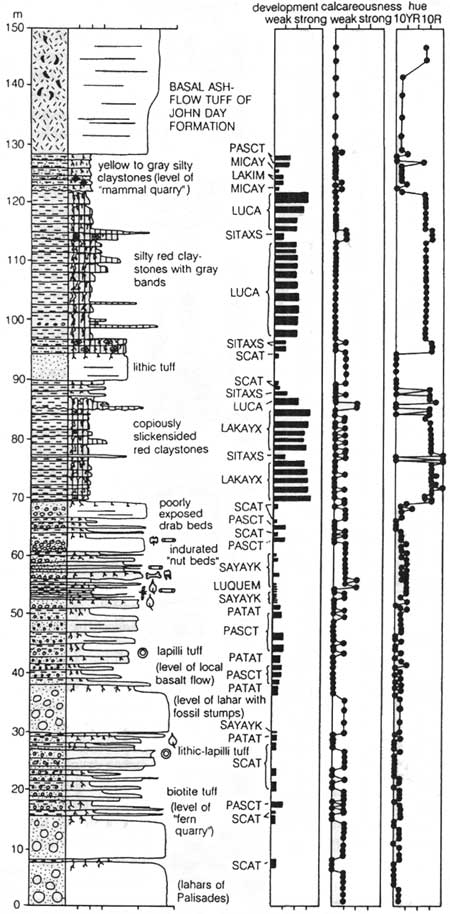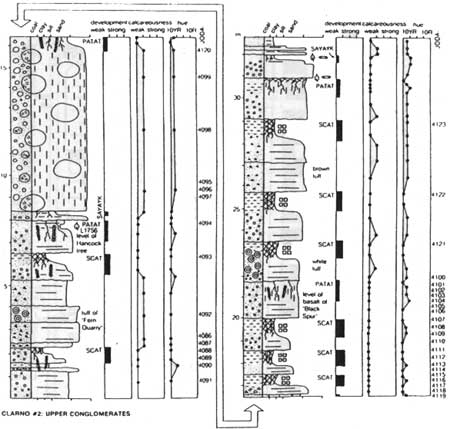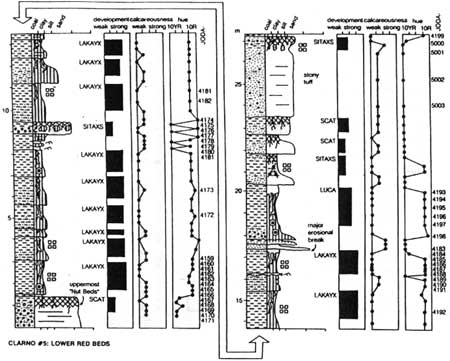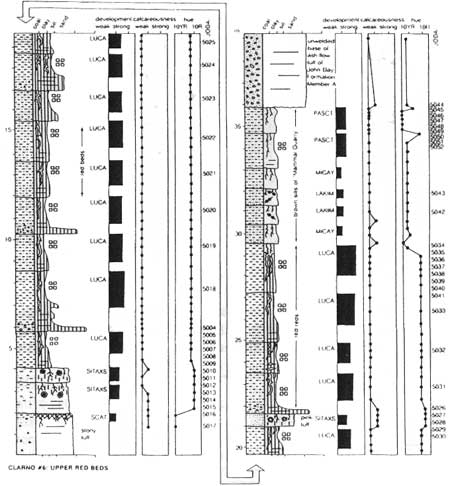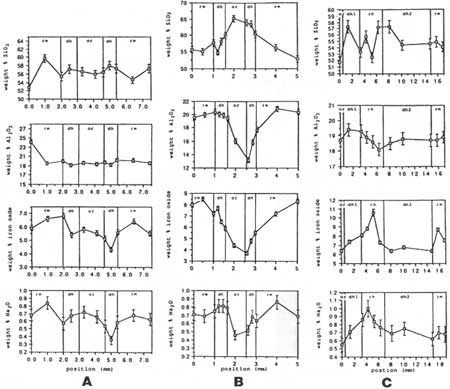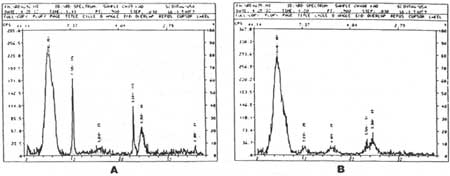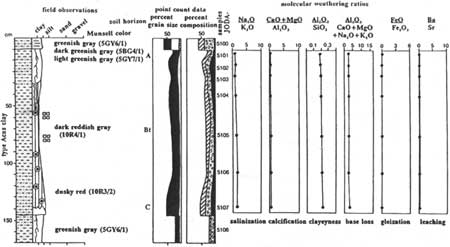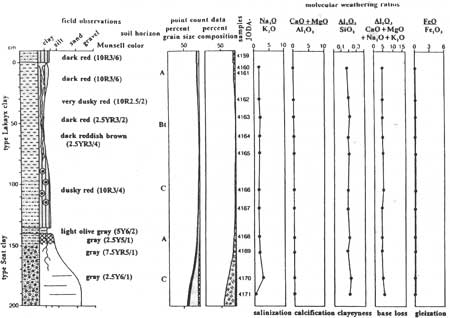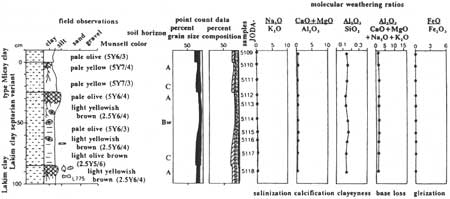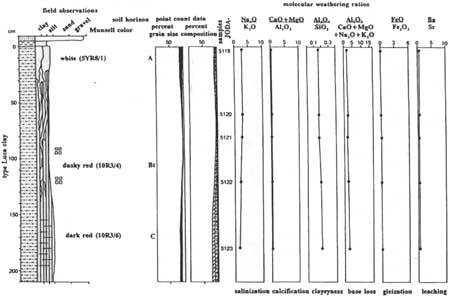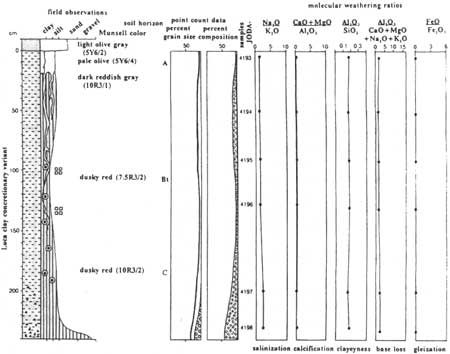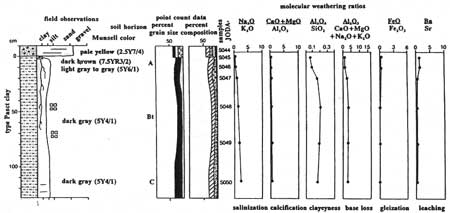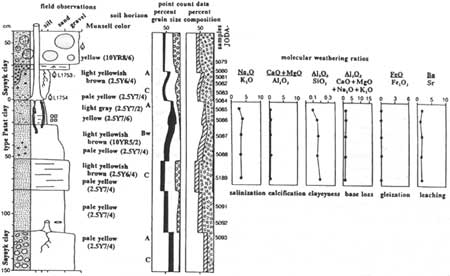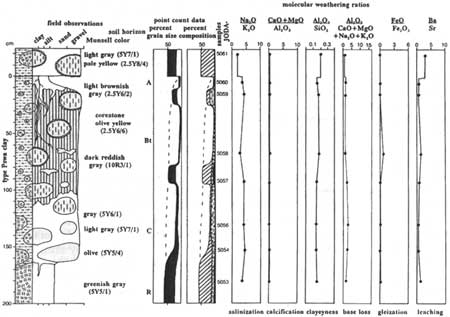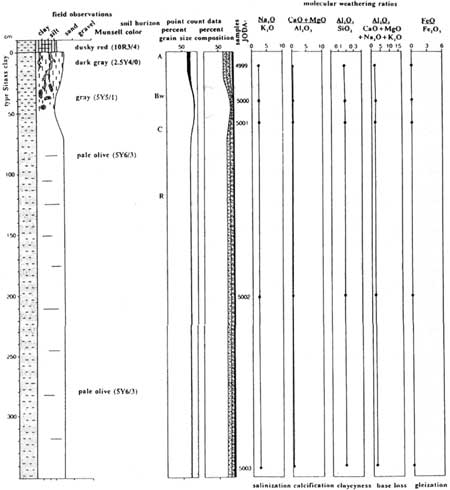|
JOHN DAY FOSSIL BEDS
Geology and Paleoenvironments of the Clarno Unit John Day Fossil Beds National Monument, Oregon |

|
CHAPTER III:
PALEOSOLS AND PALEOENVIRONMENT OF THE CLARNO AREA
INTRODUCTION
The Clarno Formation is largely andesitic volcanic and volcaniclastic rocks but fossil soils are locally conspicuous. Thick red clayey fossil soils have long been used to subdivide the formation (Waters and others 1951; Noblett, 1981). In recent years, paleosols also have been used to try to reconstruct the fossil record of Eocene ecosystems (Retallack, 1981a, 1991a,b, Smith, 1988; Pratt, 1988). Both approaches are part of the work presented in this chapter, which is a comprehensive account of the variety of paleosols found in the Clarno Formation in its type area around Hancock Field Station. Each distinctive paleosol type or pedotype (of Retallack, 1994b) has been given a name in the Sahaptin Indian language, which will be defined and described in due course, but are summarized in Table 3.1. Before proceeding with characterization of the paleosols, we consider various features by which they have been identified and likely alteration of the profiles after burial. For this preliminary discussion the paleosol names merely provide convenient labels.
TABLE 3.1 - Diagnoses and identifications of pedotypes from the Clarno area
| PEDO- TYPE | INDIAN MEANING | ORTHO- GRAPHY |
TYPE PROFILE | DIAGNOSIS | U.S. | F.A.O. MAP | AUSTR- ALIAN | NORTH- COTE |
| Acas | eye | acas | Hancock Canyon | Purple, slickensided, subsurface clayey (Bt) horizon | Plinthic Haplohumult | Ferric Acrisol |
Lateritic Podzolic | Gn3.21 |
| Cmuk | black | cmúk | below "Black Spur" | Black lignite on gray claystone with local iron-manganese nodules | Hemist | Eutric Histosol | Acid Peat | O |
| Lakayx | shine | la.kày X | "Red Hill" | Red (2.5YR-10R), clayey, thick, abundant slickensided cutans, deeply weathered | Hapludult | Ferric Acrisol | Krasnozem | Gn3.11 |
| Lakim | soot | la.ki'm | Painted Hills | Brown to olive, with large black iron-manganese nodules | Aquandic Placaquept | Eutric Gleysol | Humic Gley | Uf6.61 |
| Luca | red | lucá | Maurer's Ranch | Red (2.5YR-10R), thick, clayey to silty, with remnant weatherable minerals | Hapludalf | Chromic Luvisol | Red Podzolic | Gn4.41 |
| Luquem | decayed fire | luq'em | "Fern Quarry" | White bedded volcanic ash with root traces | Typic Udivitrand | Vitric Andosol | Alluvial | Um1.21 |
| Micay | root | míeay | "Mammal Quarry" | Brown to olive bedded claystone with root traces | Hapludand | Ochric Andosol | Grey Clay | Uf1.41 |
| Pasct | cloud | pásct | "Red Hill" | Olive gray to orange, slickensided, subsurface clayey (Bt) horizon | Sombrihumult | Humic Acrisol | Grey Brown Podzolic | Gn3.94 |
| Patat | tree | pátat | Hancock Canyon | Bedded sandstone with root traces, mildly leached and ferruginized | Psammentic Eutrochrept | Eutric Cambisol | Brown Earth | Um5.51 |
| Pswa | stone, clay | pswá | below "Black Spur" | Purple clayey subsurface (Bt) with core-stones and gradational contact down to andesite | Lithic Hapludalf | Orthic Luvisol | Brown Podzolic | Gn2.01 |
| Sayayk | sand | sayáykw | "Nut Beds" | Bedded siltstone with root traces | Tropofluevent | Eutric Fluvisol | Alluvial | Um1.21 |
| Scat | dark | sc'at | "Red Hill" | Thin gray to green claystone on andesitic conglomerate | Haplumbrept | Humic Cambisol | Alpine Humus | Uf1.41 |
| Sitaxs | liver | siráXs | "Red Hill" | Olive-purple silty claystone, with relict bedding, and iron manganese skins and nodules | Placaquand | Eutric Gleysol | Humic Gley | Uf6.41 |
Detailed petrographic and geochemical studies of the paleosols have focused on a reference measured section through the upper Clarno Formation near the well known fossil "Nut Beds" and a few other measured sections on Hancock Field Station (Figs 3.1 - 3.10, Tables 3.2-3.3), but the paleosol types can be recognized more widely in the region.
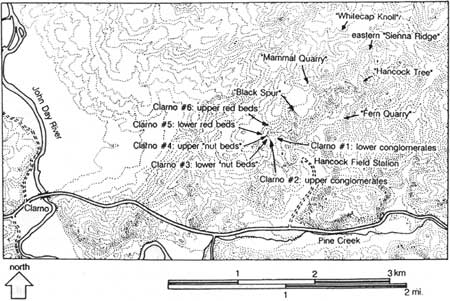
|
| Figure 3.1. Location of measured sections of paleosols in the Clarno Unit of the John Day Fossil Beds National Monument. (click on image for an enlargement in a new window) |
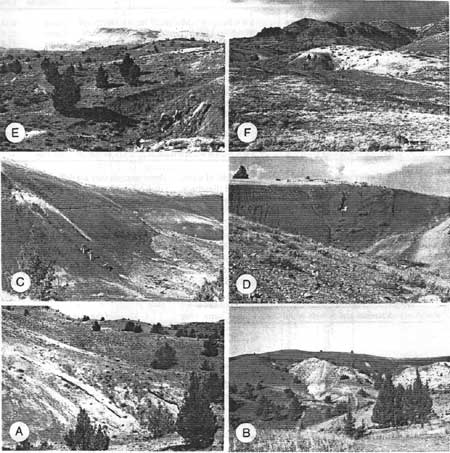
|
| Figure 3.2. Trenches used for detailed study of paleosols in the upper Clarno and lower John Day Formation near Hancock Field Station, Clarno: A, lower conglomerate trenches of reference section viewed from south; B, upper conglomerate trench of reference section is visible in central bluff and both "Nut Beds" trenches were in that southernmost outcrop of these silicified conglomerates and sandstones, viewed from east along trail to "Red Hill" on skyline: C, lower "Red Hill" trench of reference section from south; D, upper "Red Hill" trench of reference section from south; E, "Mammal Beds" trench in foreground viewed from north toward "Red Hill" and John Day Valley in distance; E, "Whitecap Knoll" section viewed from south with Iron Mountain in the distance. |
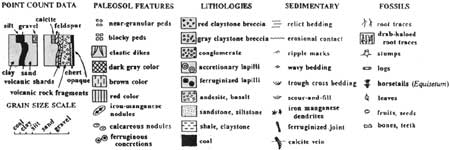
|
| Figure 3.3. Lithological symbols for columnar sections of paleosols. (click on image for an enlargement in a new window) |
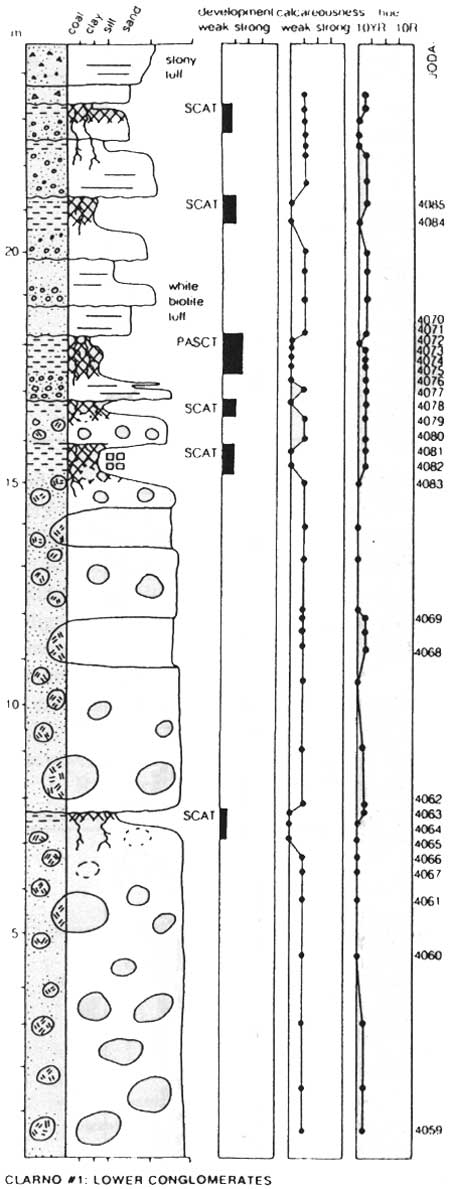
|
| Figure 3.5. Lower conglomerates or subsection 1 of the reference section through upper Clarno Formation near Hancock Field Station. Lithological symbols after Fig. 3.3. Degree of development, calcareousness after Retallack (1988) and hue from Munsell color (1975) chart. |
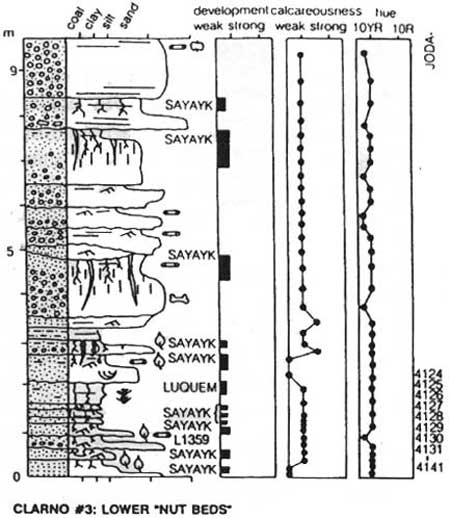
|
| Figure 3.7. Lower "Nut Beds" or subsection 3 of the reference section through the upper Clarno Formation near Hancock Field Station. Lithological symbols after Fig. 3.3. Degree of development, calcareousness after Retallack (1988) and hue from Munsell color (1975) chart. |
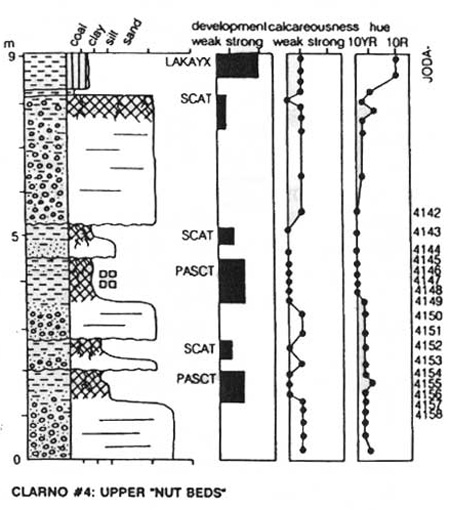
|
| Figure 3.8. Upper "Nut Beds" or subsection 4 of the reference section through the upper Clarno Formation near Hancock Field Station. Lithological symbols after Fig. 3.3. Degree of development, calcareousness after Retallack (1988) and hue from Munsell color (1975) chart. |
TABLE 3.2. Component measured sections of the reference section (1-6) and other measured sections (A-G) of paleosols in the Clarno and John Day Formations, near Clarno.
| No. | Name | Location | Formation | Level (m) |
| 1 | lower conglomerates | SW1/4 SW1/4 SW1/4 SE1/4 sec.27 702782E 4977306N | Clarno | 0-14 |
| 2 | upper conglomerates | SE1/4 SW1/4 SW1/4 SE1/4 sec.27 702894E 4977348N | Clarno | 12-53 |
| 3 | lower "Nut Beds" | SW1/4 SW1/4 SW1/4 SE1/4 sec.27 702748E 4977295N | Clarno | 52-62 |
| 4 | upper "Nut Beds" | SE1/4 SE1/4 SE1/4 SW1/4 sec.27 702744E 4977294N | Clarno | 61-67 |
| 5 | lower "Red Hill" | NE1/4 SE1/4 SE1/4 SW1/4 sec.27 702695E 4977388N | Clarno | 67-97 |
| 6 | upper "Red Hill" | SW1/4 NW1/4 NW1/4 SE1/4 sec.27 702783E 4977537N | Clarno | 94-150 |
| A | Hancock Canyon | NE1/4 SW1/4 NW1/4 SW1/4 sec.26 704022E 4978153N | Clarno | 28-30 |
| B | "Fern Quarry" | SE1/4 NW1/4 SE1/4 SW1/4 sec.26 703986E 4977651N | Clarno | 17-18 |
| C | middle "Black Spur" | SW1/4 NW1/4 SW1/4 SE1/4 sec.27 703112E 4977736N | Clarno | 39-40 |
| D | lower "Black Spur" | SW1/4 NW1/4 SW1/4 SE1/4 sec.27 703112E 4977736N | Clarno | 36-39 |
| E | "Sienna Ridge" | SW1/4 SE1/4 NE1/4 NW1/4 sec.26 704106E 4978605N | Clarno | 120-122 |
| F | "Mammal Quarry" | NE1/4 NW1/4 NE1/4 SE1/4 sec.27 703283N 4978117N | Clarno | 122-124 |
| G | "Whitecap knoll" | SW1/4 NE1/4 NW1/4 NW1/4 sec.26 703741E 4978852N | John Day | - |
FEATURES OF THE PALEOSOLS
Recognition of paleosols in sedimentary rocks is an interpretation similar to recognizing paleochannels or tuffs. In our studies of Eocene and Oligocene paleosols in the Clarno area, we used three main kinds of evidence to recognize paleosols: traces of land life, soil horizons and soil structures.
Traces of land life
To many soil scientists (Buol and others, 1980), it is life that distinguishes soils from sediments and rocks. Traces of land life, such as root traces and burrows, are the best possible evidence for the existence of paleosols. This is not to say that paleosols or soils must show traces of life. Because of chemical and other conditions prevailing during burial of a soil, very little of their original life is preserved (Retallack, 1984a). Few Precambrian paleosols or Antarctic soils show much trace of life, because little life was present (Retallack, 1990a). In the case of Eocene and Oligocene paleosols from Oregon, research has been directed toward their rich fossil record of plants and mammals (Retallack, 1991a,b). These paleosols also contain a variety of fossil root traces, burrows, and other useful paleontological features indicating that they were soils.
Root traces. Both burrows and root traces are abundant and diverse in paleosols of the Clarno area. In some cases they are difficult to distinguish, as in drab colored backfilled burrows seen in some Lakayx paleosols (Smith, 1988). In other cases root traces are obscured by nodular overgrowths, as in the iron-manganese nodules and septaria of Lakim paleosols (Pratt, 1988). In general, root traces are irregularly shaped, branching and tapering downward (Fig. 3.11). Burrows on the other hand are parallel sided, branching systematically, if at all, and nodules are rounded to ellipsoidal masses. In some cases fossil root tissues are preserved by cellular permineralization (Fig. 3.12).

|
| Figure 3.11. Fossil root trace (black) in a vertically-oriented petrographic thin section of a cobble similar to a Sayayk paleosol within colluvial breccia above the type Pswa paleosol in the late Eocene upper Clarno Formation below "Black Spur" (rock specimen JODA5055). Scale is 1 mm. |
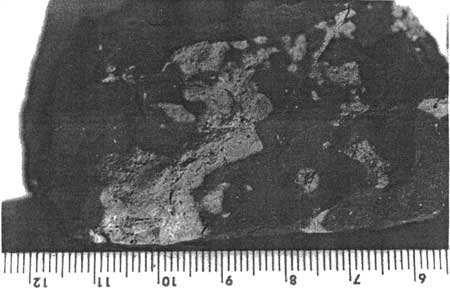
|
| Figure 3.12. Downward branching fossil root with remnants of central conducting strand and marginal epidermis in A horizon of type Luquem paleosol in the middle Eocene Clarno Formation in the "Fern Quarry" (rock specimen JODA5095). Scale is 1 mm. |
Many of the root traces in these paleosols show drab haloes: diffuse zones of green-gray to blue-gray carbonate or clay extending outward from the sharp inner boundary of the root hole (Fig. 3.13). Such drab-haloed root traces are common in red paleosols of the Clarno area (Lakayx, Luca, Acas paleosols). Drab haloed root traces are sparse and simple in most Lakayx paleosols, but the last paleosol of this type below a major erosional disconformity in "Red Hill" shows associated haloes of iron-manganese, or mangans in the terminology of Brewer (1976). Chemical study of these indicates significant iron depletion within the drab haloes, which is most extreme in examples with complex double haloes (Fig. 3.14). These data indicate open system alteration typical of gleization in the original profile. Considering the highly oxidized matrix this was more likely local slow drainage than pervasive waterlogging. Observations of the drab haloes as diffuse areas of discoloration around deeply penetrating root traces in a red matrix is evidence against their origin as holes filled with drab-colored material from overlying layers (krotovinas in soil terminology) or as areas unaffected by burial reddening of the paleosols. The way in which the haloes extend out from stout parts of the root traces, as well as from fine rootlets, is incompatible with the idea that the drab haloes represent an ancient rhizosphere depleted of iron and other nutrients. The active rhizosphere is at the tips of the rootlets where there are abundant root hairs, not on the old main roots (Russell, 1977). Thus, the most likely of the various possible origins for these drab haloes around root traces (discussed by Retallack, 1990a, 1991d) is as products of anaerobic decay during early burial of organic matter of the root in Luca and Acas paleosols, perhaps with some chemical reduction and transport of iron and manganese due to local or seasonal waterlogging in Lakayx paleosols. Pervasive waterlogging of Lakayx paleosols is ruled out by their strong development, deeply penetrating root traces and burrows and highly oxidized chemical composition. Because dead roots in these well-drained lowland soils would already have decayed aerobically before burial, the drab-haloed root traces represent the last crop of vegetation and humus before burial. Thus, drab-haloed root traces can be a guide to the nature of former vegetation.
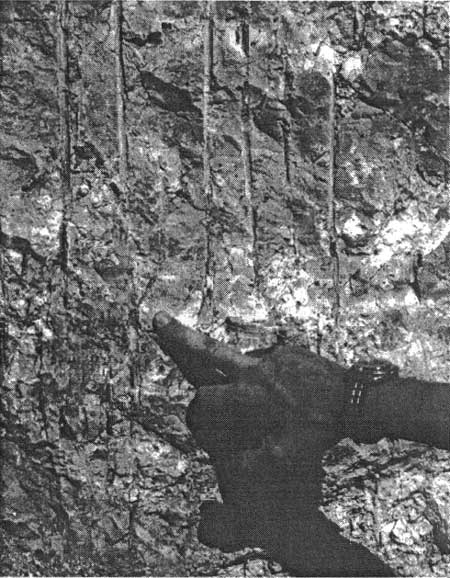
|
| Figure 3.14. Microprobe traverses through drab-haloed traces, from root (or), to halo (dh) and red matrix (rm), in the Lakayx clay manganiferous variant paleosol at 85 m in references section. Specimens analyzed are from left to right JODA4185, 4186, 4187. Data from Smith (1988). |
Several different patterns of root traces were observed during excavation of these paleosols. Patterning and ecology of modern roots now is increasingly well documented (a summary is given by Jackson, 1986). Most of the fossil root traces seen were deeply penetrating, and most of them were near vertical. In contrast, tabular root systems were found with root traces deflected by boulders of volcanic lava in Pswa paleosols and in underclay below lignites of Cmuk paleosols. Tabular root systems are found in permanently waterlogged soils (Jenik, 1978) and low-nutrient soils of tropical rain forest (Sanford, 1987).
Plant remains. Paleosols of the Clarno area contain diverse plant fossils in addition to the root traces already discussed. Both the nature and style of preservation of these remains are compatible with interpretation of these rocks as sequences of fossil soils.
Fossil pollen, leaf impressions and silicified wood are known from the Clarno and John Day Formations near Clarno mainly from drab-colored weakly-developed paleosols (Retallack, 1981a: Cmuk, Luquem, Micay, Patat, Sayayk paleosols). The plant fossils show a bias toward wet and mesophytic vegetation types, whereas red paleosols represent vegetation of seasonally wet and well-drained sites in which plant remains were seldom preserved, as is usual for paleosol sequences (Retallack, 1984a, 1990a). Preservation of the leaves is primarily as impressions, as would be expected on moderately aerated weakly developed soils. In Cmuk paleosols, which include coaly surface horizons, some of the fossil leaves have cuticle, presumably preserved under the anaerobic conditions of a local swamp.
Many of the fossil plant beds in the Clarno lahars have the character of fossil leaf litters, especially in Sayayk and Patat paleosols (localities L750, L1359, L1730, L1732, L1753, L1754, L1755, L1756, L1759, L1760, L1761, L1854, L1855, L1856, L1857, L1858, L1859, L1860, L1861, L1873 of Appendix 9). The leaves are crowded into a thin bedding plane between sparsely fossiliferous overlying sediments and sediment with large root traces below. The leaves are commonly fragmented, skeletonized, and covered with scribbling marks like those of fungal hyphae and insect feeding trails. In some cases leaves are preserved in high relief, as if dried and curled in a leaf litter. In the Patat paleosol preserved below a 11 m lahar underlying a distinctive amygdaloidal basalt in Hancock Canyon (L1750, L1733), the leaf litter layer also has rooted within it large permineralized stumps, including the "Hancock Tree" (Retallack, 1981a, 1991a). Other paleosols preserve plants in growth position arching up into overlying strata: for example, horsetails (Equisetum clarnoi) in a Luquem paleosol and ferns (Saccoloma gardneri) in a Luquem paleosol in the Clarno "Nut Beds" (Fig. 3.15) and in a Sayayk paleosol in Hancock Canyon (L1650), and ferns (Saccoloma gardneri) in a Luquem paleosol in the "Fern Quarry" (L1099). Rapid burial within lahars and hyperconcentrated flows, followed by permineralization in warm muddy volcaniclastic sediments may explain this remarkable record of early successional and herbaceous Eocene vegetation. Comparable burial and preservation of forests and fossil leaf litters in volcanic airfall ash was observed following the 1980 eruption of Mt St Helens in Washington (Karowe and Jefferson, 1987) and the 1982 eruption of El Chichon volcano in Mexico (Burnham and Spicer, 1986).
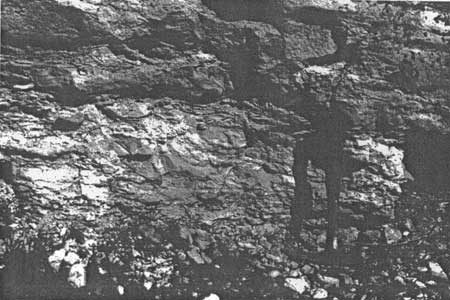
|
| Figure 3.15. Fossil horsetails (Equisetum clarnoi) in growth position in a Luquem paleosol in the central outcrop of the "Nut Beds" of the middle Eocene Clarno Formation. The example indicated by finger is branching upwards. |
Plant remains also have been found in a fluvial conglomerate, perhaps partly hydrothermally sintered, at the well known "Nut Beds" locality of the Clarno Formation (L685, L977; Manchester, 1981, 1994), and in lacustrine varved shales at the "Slanting Leaf Beds" (L743) and correlative strata of the John Day Formation on Knox Ranch (L1352, L1352: Manchester and Meyer, 1987; Meyer and Manchester, 1994) as well as from a new locality of lacustrine shales in the lower John Day Formation (L1568). Few of these abundant and diverse fossil remains are of fully aquatic plants: with the possible exception only of monocot leaves similar to reeds.
Invertebrate fossils. The rarity of invertebrate fossils in the Clarno area is not surprising considering the non-calcareous nature of most the paleosols in which shells would not be preserved and their red well-oxidized composition unsuitable for preservation of organic remains (Retallack, 1984a). Nevertheless, insect galls and nibble marks on leaves are known from fossil leaf litters of the Clarno lahars and one piece of permineralized "Nut Beds" preserved a boring beetle within its hole (S. Manchester pers. comm. 1981). In these cases, rarity of invertebrates may be due to the overwhelming abundance of plants among these fossils of lahars.
Fossil terrestrial snails are found in paleosols of the middle John Day Formation, that have yielded also fossil bones and teeth (locality L1541 of Appendix 9). Their occurrence here can be predicted from the calcareous nature of these paleosols (Retallack, 1984a).
A more copious record of invertebrates is known from lacustrine shales of the John Day Formation, which have yielded aquatic snails (L1568, L1354) and a variety of terrestrial insects (L1568, L743; Manchester and Meyer, 1987). These records provide assurance that insects were abundant and diverse despite taphonomic obstacles to their widespread preservation in paleosols.
Burrows and other trace fossils. A variety of burrows and other invertebrate trace fossils were found in many of the paleosols. Their abundance and diversity in some paleosols explains in part their massive bioturbated appearance. For example Lakayx paleosols at the base of the red bed sequence in "Red Hill" include at least three different kinds of structures of probable biogenic origin (Smith, 1988). The most distinctive are near-vertical unbranched tubular burrows some 3-4 mm in diameter, filled with grey silty clay divided by meniscate seams of red clay. These backfill structures are like those of a burrowing insect, and overall these burrows are most like those of burrowing beetles, perhaps a root feeder. Also notable in Lakayx paleosols are rounded clasts of sand to granule size of strongly ferruginized claystone, similar to clayey "pseudosand" and "spherical micropeds" common in tropical soils (Mermut and others, 1984). These structures are commonly interpreted as oral and fecal pellets of ground-dwelling termites (Retallack, 1991c). Both Lakayx and some Sitaxs paleosols include brown to yellow ferruginized ellipsoidal to globose clusters some 2-5 cm in diameter with each nodular unit 4-7 mm in diameter, and commonly associated with slender burrows or drab-haloed root traces. The origin of these distinctive and abundant structures is uncertain: possibilities include calies of fungus-gardening ants or termites, or root nodules from either rhizobial symbionts or fungal mycorrhizae.
In contrast with this distinctive trace fossil assemblage of Clarno red beds are calcareous trace fossils associated with green volcaniclastic paleosols of the middle John Day Formation (at locality L1541 of Appendix 9). These include small calcareous balls some 11-13 mm in diameter, similar to Pallichnus dakotensis from Oligocene paleosols of South Dakota (Retallack, 1984b, 1990b). Pallichnus has been interpreted as the internal mold of a geotrupine dung beetle larval cell, but comparable study of these traces have not been undertaken. Other trace fossils from the John Day Fonnation in the Clarno area are irregular sheets or nodules composed of ellipsoidal units of calcareous siltstone some 5-6 mm in length, similar to Edaphichnium lumbricatum from Eocene paleosols in Wyoming (Bown and Kraus, 1983). Edaphichnium has been interpreted as the chimney of a large earthworm. Much could be learned about these ancient terrestrial ecosystems by further study of their trace fossil assemblages.
Fossil bones. The Clarno area is well known for mammal fossils. Detailed studies of bones in Micay paleosols in the "Mammal Quarry" (L775: Pratt, 1988) showed that the bones had no particular orientation, indicating little or no sorting by water. The bones were disarticulated, cracked and in some cases merely a group of splinters. Several large skulls of titanotheres, rhinoceroses, oreodons and a creodont carnivore were preserved more or less intact. This kind of preservation would be expected during the natural accumulation of dead animals or large carcass fragments in a soil, followed by rotting, weathering and trampling.
Less is known about bones from the "Nut Beds" (L1359) but our field inspection of such remains and their known sites indicates that they are preserved as clasts in fluvial and laharic conglomerates. The bones are relatively equant, robust teeth, maxillae or fragments. This kind of preservation would be expected from river abrasion and reworking of loose bones washed into streams (Hanson, 1980).
Even in paleochannels of the Clarno Formation most of the fossil vertebrates are of terrestrial creatures. This includes the alligators (Pristichampsus) which belong to an extinct group with distinctive cursorial limb structure (Langston, 1975) and the tortoise (Hadrianus) which is more closely allied to Galapagos tortoises than pond turtles (Hay, 1908). This leaves fish bones and scales in the "Mammal Quarry" as the only definite aquatic vertebrates in the Clarno Formation in its type area.
Fossil fish, including mudminnows are more common in lacustrine shales of the lower John Day Formation (L743, L1568, L1354), but these shales also have yielded terrestrial to semi-terrestrial vertebrates including frogs, salamanders and a bat (Manchester and Meyer, 1987). None of these aquatic elements have been found in paleosols of the John Day Formation. Fossil bone is locally common in calcareous paleosols of the middle and upper John Day Formation (as at L1541), but only a single poorly preserved fragment of a very robust tusk of an extinct hoglike entelodon was found in a non-calcareous paleosol of the lower John Day Formation (L1358). This pattern of preservation has been predicted from general models for fossil preservation in paleosols (Retallack, 1984a), because the calcium apatite of bone is soluble in acidic solutions of non-calcareous soils. The lack of a fossil record of vertebrates in red beds of the lower John Day and Clarno Formations does not reflect a scarcity of game, but merely a lack of preservation in forest soils.
Soil horizons
A second general category of features diagnostic of paleosols, as opposed to other geological phenomena, is gradational alteration down from the ancient land surface, or soil horizons. Soil horizons usually are truncated abruptly at the land surface but show gradational contacts downward into their parent material (Retallack, 1990a). Sedimentary beds, on the other hand, are in general sharply bound and often more numerous and thin. These general differences were used in conjunction with other features, such as root traces and soil structure to recognize paleosols in these mid-Tertiary volcaniclastic sequences (Fig. 3.16, 17). A few paleosols (especially Luquem and Sayayk) are intermediate in showing additions to the surface that include root traces indicating persistence of vegetation. These cumulic horizons (of Soil Survey Staff, 1975) or cumulative horizons (of Birkeland, 1984), nevertheless show sedimentary structures distinctly different from the massive and pedogenically altered material of the ancient soil profile below.
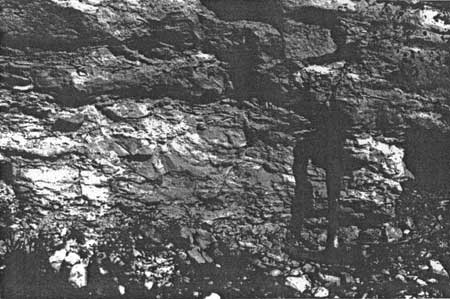
|
| Figure 3.16. Type Luquem silty clay loam paleosol in the middle Eocene Clarno Formation in the "Fern Quarry". Within the paleosol relict bedding is extensively disrupted by fossil root traces that are not found above its sharp upper surface. This is a weakly developed paleosol. The hammer handle for scale is 25 cm long. |
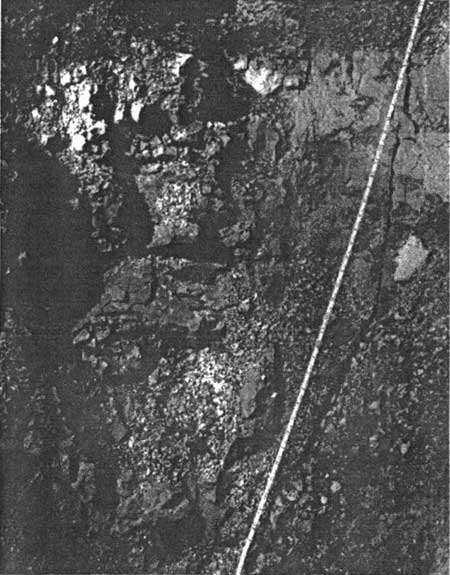
|
| Figure 3.17. Luca clay pisolitic variant paleosol at 87 m in reference section of late Eocene Clarno Formation. The top of the paleosol is the sharp top to the light gray band or A horizon which passes gradationally downward through an horizon of drab-haloed root traces into a red clayey Bt horizon. This is a moderately developed paleosol, with little trace of the relict bedding seen in Fig. 3.14. Tape for scale is graduated in inches. |
Clayey surface horizons. In some of the paleosols (Micay, Scat, Patat) the most clayey part of the profile is the uppermost 20 cm or so. Was this clayey layer formed by weathering of a more silty parent material? Or was it a separate clayey bed of a fining-upwards sequence of the parent material? These alternatives are not mutually exclusive: some component of each is likely in a soil, but no weathering in place would be detectable if it were only a sedimentary bed. For these paleosols, the contribution of weathering is most obvious in thin sections, where etched and deeply weathered minerals and rock fragments are common.
Although surface clayey horizons are unlikely to be only a fine-grained upper part of a graded bed, some sedimentary additions to them are likely. Chemical analyses, particularly of materials stable in soils such as titania and zirconium, demonstrate that the upper horizon of some of the paleosols had a parent material different from the lower horizon. In the type Patat paleosol, soil formation added a finer grained upper horizon to several distinctly different sandy beds of its parent material. In all these cases, the rate of influx of new material was slow enough for material to be incorporated into the soil fabric. Eolian and fluvial influx are now recognized as common in soils (Brimhall and others, 1988; Muhs and others, 1987).
Subsurface clayey horizons. Many of the paleosols (Lakayx, Luca, Pasct) have a diffuse zone of clay enrichment below the less clayey, truncated top of the profile (Fig. 3.15). These paleosols are all in alluvial to piedmont sequences. Could these clayey zones represent merely finer-grained beds within their parent material? There is no suggestion of this in the field: no stone lines, relict bedding or other sedimentary structures. These clayey subsurface horizons are well homogenized by root traces, burrows, and fecal pellets and have gradational boundaries into coarser-grained material above and below. Nor were any subtle discontinuities revealed by point counting for mineral composition or chemical analysis of trace elements. In thin section, pedogenic clay is visible as thin rims around grains from which it was hydrolyzed and as highly birefringent wisps in a less oriented clayey matrix (Fig. 3.18). Banding and colloform structures in these highly birefringent fine-grained clays are evidence for illuviation from higher horizons in the profiles. Abundant and conspicuous bioturbation in these paleosols has mixed and altered original sedimentary layering and igneous crystal structure beyond recognition, and imposed pedogenic horizonation. This is not to say that there was no clay in the parent materials. Clay was probably at least as abundant in the parent alluvium as it is in associated very weakly developed paleosols (Luquem, Patat and Sayayk paleosols). However, the clay bulge in their depth functions for grain size includes significant amounts of pedogenic clay.
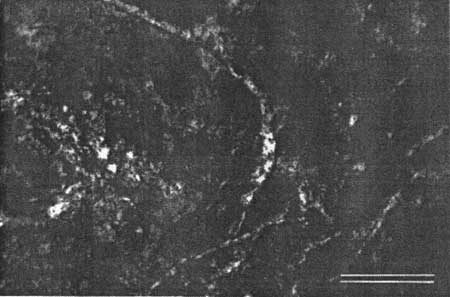
|
| Figure 3.18. Thick illuvial clay skins formed around a volcanic rock fragment to right in the A horizon of the type Scat paleosol in the middle-late Eocene upper Clarno Formation in lower "Red Hill". Scale is 0.1 mm. |
Conventionally, the formation of clayey subsurface horizons in soils has been regarded as a process of formation of clay in place by weathering of primary minerals and its washing down into the cracks and root holes in the soil. An alternative view has recently been suggested to accommodate the widespread role of eolian dust in soil formation (Muhs and others, 1987). Soils can be considered very slowly accumulating eolian sediments within the zone of weathering, so that subsurface horizons are more clayey because they have weathered for longer than surface horizons. In addition, fine clays transported by wind easily penetrate soil cracks, and their high surface-to-volume ratio allows more thorough weathering than that found in coarser grains of parent material. Not only are these processes widespread in desert soils (McFadden, 1988), but they also have been proposed to produce lateritic and bauxitic soils under humid forests (Brimhall and others, 1988), in a manner analogous to the accumulation of brown clays in the deep ocean (Clauer and Hoffert, 1985). For these Eocene-Oligocene paleosols, there is in addition to wind, a steady input of sediment from flooding and airfall volcanic ash. As indicated by Simonson (1976), such slow sedimentary additions to soils should be considered a process of soil formation rather than of sedimentation. The thorough incorporation of this material in the soil fabric is an indication that it is well under the control of the soil system, as opposed to the wider depositional system that occasionally overwhelms soils with thick deposits or destroys soils by eroding them away.
Evidence of continued sediment influx during formation of those paleosols with subsurface clayey horizons is not difficult to find, in the form of rare fresh feldspars and volcanic rock fragments in otherwise deeply weathered clayey parts of paleosols. Thus it is likely that the subsurface clayey horizons of these paleosols were formed partly by weathering in place and partly by the addition of dust, volcanic ash, and flood-borne silt. There are no indications that these diffuse, clayey, subsurface horizons were inherited from a preexisting clayey bed in the parent material of the paleosols.
Subsurface horizons rich in iron-manganese. Many of the paleosols contain small (1-2 mm), dark brown to bluish-black, opaque patches of noncrystalline iron-manganese on slickensided argillans, as nodules or concretions in the matrix, or as void fills after root traces. They are a minor component of many of the paleosols, which contain low overall amounts of manganese, in some cases depleted from the amount in underlying parent materials. Similar features are common in soils, especially those with clayey texture, free carbonate, or imperfectly drained (Sidhu and others, 1977b; Brewer, Sleeman, and Foster, 1983; Rahmatullah and others, 1990). Considering the virtual absence of carbonate in these paleosols, iron-manganese nodules can be taken as evidence of waterlogging, either during soil formation or burial.
Lakim paleosols are noteworthy in showing unusual accumulations of manganese in prominent septaria and nodules up to 13 cm in diameter (Pratt, 1988). Such extensive mobilization of iron and manganese is evidence for open-system alteration, unlikely during deep burial in such impermeable claystones. These iron-manganese horizons are similar to those found in modern seasonally waterlogged soils (Kanagarh Series of Kooistra, 1982; Gujranwala and Satghara Series of Rahmatullah and others, 1990), and may be an early stage in the development of a manganese-cemented horizon or placic horizon in the terminology of Soil Survey Staff (1975).
Chemical depth functions. Soil horizons, with few exceptions (Retallack, 1988), are distinct from sedimentary or volcanic beds in showing gradational changes in texture, mineral weathering, color, and other features downward from a sharp erosional plane that represents the ancient land surface. Such gradational depth functions also can be seen in chemical data and are particularly well expressed in moderately to strongly developed paleosols (Acas, Lakayx, Pasct, Pswa paleosols) (Fig. 3.19). In contrast, very weakly to weakly developed paleosols show little chemical change or abrupt changes reflecting differences in beds of parent material (Patat paleosols). In most cases these differences are less marked than those between sedimentary beds.
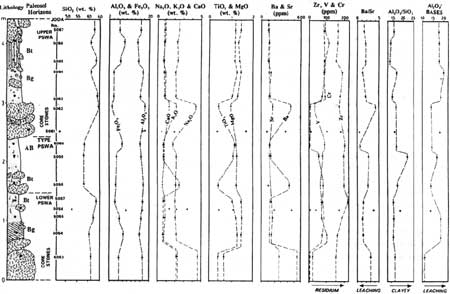
|
| Figure 3.19. Chemical variation in the type Pswa clay and an overlying Pswa paleosol in the trench below "Black Spur" near Hancock Field Station. (click on image for an enlargement in a new window) |
The down-profile variation in most of these elements is probably a function of soil formation, but some elements such as titanium, zirconium, and gold are relatively unaffected by weathering. Their uniformity in most of the paleosols is an indication of a single parent material.
It could be argued that even gradational depth functions reflect parent material variation, such as fining-upwards sequences deposited with waning flood flow in alluvial sequences (Allen, 1965) or the grain size sorting that may accompany emplacement of pyroclastic flows (Gas and Wright, 1987). If these were the cause, however, it is difficult to understand the divergent behavior of easily weathered oxides (lime and soda) versus resistate oxides (titania), and the other details of the variation so much like modern weathering. Also difficult to understand as parent material effects are bulges in chemical abundance.
Another possibility is that the observed chemical depth functions reflect merely porosity-dependent passage of ground-water (Pavich and Obermeier, 1985) or composition-dependent alteration during burial or metamorphism (Palmer and others, 1989). These can be serious objections to interpretation of much older and more altered rocks (Retallack, 1989). Most of these paleosols were clayey and thus low in porosity. Sandy layers within and between paleosols do not show alteration of a kind distinctly different from that in more clayey parts of the profiles. These paleosols also are highly oxidized, as indicated by elevated amounts of ferric iron compared with their parent materials, whereas environments of burial alteration are chemically reducing (Thompson, 1972). Nor are there any unusual high-temperature minerals, recrystallization textures, schistosity, or other features of alteration during deep burial or metamorphism. This is not to say that these paleosols were unaltered by burial. Many changes after burial are outlined in the next chapter. However, the chemical depth functions observed are consistent with evidence from root traces, soil horizons and soil structures that these are indeed paleosols.
Soil structure
Beds now known to be paleosols commonly have been described in geological reports as massive, featureless, blocky, jointy, hackly, nodular, or mottled. Such descriptions make the point well that paleosols lack sedimentary, igneous, and metamorphic structures and have distinctive structures of their own. For an adequate terminology for these structures one must turn to soil science (Brewer, 1976). Some structures of soils, such as nodules and mottles, are found also in marine sediments and hydro-thermally altered rocks (Retallack, 1990a). Other structures are produced by the randomly oriented expansion and contraction of materials under low confining pressures and temperatures that are virtually unique to soil environments. Such structures include peds and cutans visible in the field, and displacive and sepic plasmic fabric seen in thin section. These structures are diagnostic of soils as opposed to other kinds of geological phenomena, and are richly represented in Eocene and Oligocene paleosols near Clarno.
Cracking and veining. Many of the paleosols show complex systems of clay-filled cracks that have disrupted remains of original bedding and grains of their parent material. For example, hackly surficial clayey layers of Pasct and Micay paleosols in the Clarno area are very distinct from enclosing bedded rocks. The hackly appearance is due to small (6-15 mm in diameter) equant nuclei of claystone surrounded by irregular slickensided and ferruginized clayey surfaces. In soil terminology these are fine granular peds defined by diffusion ferri-argillans. These granular peds are not so well developed, nor so regular in shape and roundness, as those found in some modern grassland soils (Duchafour, 1982). Their formation nevertheless probably reflects similar processes of comminution and weathering of the upper part of the soil by roots of herbaceous plants and activities of a variety of worms, insects and other soil creatures.
Soil peds at a larger scale (5-10 cm) are common in other paleosols (Acas, Lakayx, Luca, Sitaxs). These are similar to coarse angular-blocky peds, defined by slickensided ferri-argillans (Fig. 3.20), and are a typical subsurface structure of soils (Duchafour, 1982). In no case was this expressed in these clayey paleosols to the extent of tepee structures, conjugate shears or mukkara structure found in seasonally cracking soils such as Vertisols (Allen, 1986a; Paton, 1974).
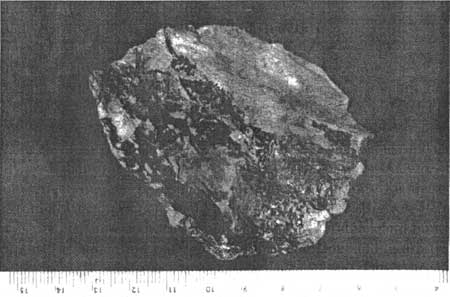
|
| Figure 3.20. Blocky angular ped, broken on top face, but defined on sides by slickensided black surfaces (mangans) from the Sitaxs clay paleosol at 88 m reference section of the late Eocene Clarno Formation. Scale graduated in millimeters and centimeters (Retallack specimen R130). |
Claystone grains. In many of the paleosols examined in thin section there are abundant claystone grains of sand to granule size. These vary considerably in the sharpness of their outer boundary and in the degree to which they are darkened by sesquioxide stain. Only those with sharp outer boundaries and staining or other fabric that set them apart from the matrix were counted as clay clasts during petrographic studies. Claystone nuclei with ragged and diffuse margins, on the other hand were counted as paleosol peds of the matrix.
In some of the paleosols (Acas), rounded to ellipsoidal claystone grains commonly are ferruginized to a near-opaque reddish-brown color, as seen in thin section under plane light. Some of them include indistinct transparent areas shaped like rectangles, squares, or triangles. These are interpreted as relict or pseudomorphed phenocrysts of feldspar or pyroxene in the highly altered fine-grained groundmass of what was once a granule of andesite. Little-weathered examples of these rock fragments also are widespread in these paleosols and their parent materials. Intermediate stages of granules with moderately fresh cores but a wide ferruginized weathering rind also are found. Not all this weathering necessarily occurred within the paleosol now containing them. Both preweathered and fresh grains were present in the parent materials of some of the paleosols of weak development (such as Patat paleosols). Weathering of volcanic clasts in place within the paleosols also was widespread, as can be seen from the many grains with gradational and irregular, deeply weathered margins (in Acas paleosols). It could be argued that this alteration in place occurred entirely after burial, and was the work of intrastratal solution or hydrothermal injection. This is unlikely because the most highly altered grains are within the most clayey and least porous parts of the profiles. The freshest grains were found in sandy lower parts of the profiles, with fewer roots, burrows, or other signs of soil formation than higher in the profiles. None of these horizons had extensive veining or mineralization with talc, tremolite, pyrrhotite, or other minerals that would be expected in hydrothermally altered rocks. In contrast, the altered grains were smectitic and ferruginized, as is usual during weathering of volcanic rocks.
A striking feature of thin sections of Lakayx paleosols are spheres of sand to granule size of near-opaque ferruginized claystone. Usually they have abrupt outer boundaries. Some sharply broken rounds also were seen. Thus they do not appear to have formed as nodules. Nor do they look like parts of cavities filled with clay or rolled-up parts of thick clay skins, because they show no internal lamination. Some of these spherical claystone grains may be redeposited parts of soils, but clear examples of redeposited soil clasts also are found and are less ferruginized and more varied in size and shape. These "spherical micropeds" (Stoops, 1983) or "claystone pseudosands" (Mohr and Van Baren, 1954) are widespread in tropical soils. Most of them probably formed as fecal and constructional pellets of termites (Mermut and others, 1984). No clear examples of termite mounds were seen, but these may have contributed to claystone breccias found in the uppermost horizons of some Lakayx paleosols.
Destruction of mineral grains. An additional line of evidence for paleosols are mineral grains altered by weathering to a delicate skeleton that could not withstand transport (Fig. 3.21). These are very common in strongly developed paleosols (Acas, Lakayx, Luca). Their skeletal and embayed appearance rule out transport and deposition of the grains in this condition, but not their formation during deep burial (as has been argued for other comparable cases by T. R. Walker and others, 1967). Deep-burial alteration of the grains seems unlikely in this case because altered grains were seen mainly in clayey matrix rather than in sandy or pebbly intervening beds, interpreted as less weathered lower parent material that also would have been more permeable to intrastratal solution. The considerable expansion of some grains would not be expected under the confining pressures in deep burial environments. Ferruginized clay skins around the grains in the Clarno Formation indicate oxidizing conditions, whereas groundwater flowing through rocks as rich in mafic minerals as these volcaniclastics would be chemically reducing. In very deep burial environments, the thermal cracking of organic matter to hydrocarbons and carbon dioxide can generate acidic solutions capable of dissolving grains and matrix to produce secondary porosity (Schmidt and McDonald, 1979). Vuggy, cross-cutting porosity of this kind was not seen in the paleosols. Nor would it be expected considering their likely depth of burial, discussed in detail in a later section.
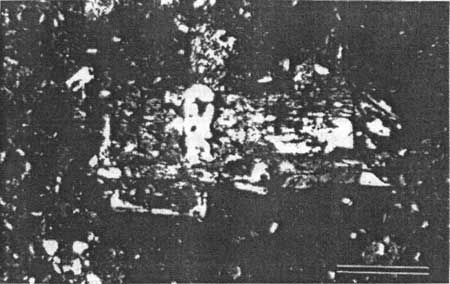
|
| Figure 3.21. Deeply weathered crystal of zoned plagioclase in subsurface (Bt) horizon of type Patat clay paleosol near "Hancock Tree" in the middle Eocene Clarno Formation, viewed under crossed nicols. Scale bar is 0.1 mm.. |
Microfabric of clayey matrix. Additional features of the paleosols seen in thin section under crossed polarizers are highly birefringent streaks of oriented clay within the generally flecked clayey matrix (Fig. 3.22). This distinctive soil microfabric can be called "bright clay" (Retallack, 1990a) or "sepic plasmic fabric" (Brewer, 1976). Many good examples of this were seen in paleosols from Clarno. The concentration of highly birefringent clay around mineral grains could have been due in part to original rolling of the grain during deposition in the parent material, or perhaps rocking of the grain during thin-section preparation, as much as to stresses generated during shrinking and swelling of the original soil. Other more complexly arranged streaks of birefringent clay are indications of a highly deviatoric system of local stresses under low temperature and confining pressure; that is to say, in a soil rather than in a depositional or deep burial environment.
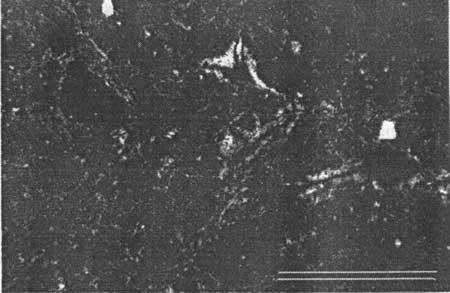
|
| Figure 3.22. Clinobimasepic plasmic fabric, with some areas of bright illuvial clay skins, viewed under crossed nicols of the surface (A) horizon of the type Pswa clay paleosol in the trench below the "Black Spur" in the middle Eocene Clarno Formation. Scale is 1 millimeter (rock specimen JODA5060). |
Sepic plasmic fabrics are best expressed in well or seasonally drained, clayey, and moderately developed soils (Brewer and Sleeman, 1969; Collins and Larney, 1983). Their expression is inhibited in weakly developed or waterlogged soils, in soils dominated by amorphous weathering products of volcanic ash, and in soils whose clayey fabric is masked by abundant near-opaque sesquioxides. These trends also were noted in paleosols of the Clarno area, where weakly developed paleosols (Micay, Patat, Scat) have incipient to streaky bright clay (insepic to mosepic), but moderately developed paleosols (Pasct, Acas) have criss-crossing bright clay (clinobimasepic) and strongly developed paleosols (Lakayx) have criss crossing to woven fabric (masepic to omnisepic).
Clay minerals. The nature of clays in paleosols of alluvial and volcaniclastic sequences are uncertain as guides to whether they actually were soils, because clays from windblown dust or flood-borne alluvium originally present in the parent material of a paleosol also are derived from soils of sedimentary source regions. As a generalization, however, base-poor clays (such as kaolinite) reflect deeper weathering than base-rich clays (illite, smectite: Jackson and others, 1948). These trends are apparent in paleosols near Clarno, with smectite more common in weakly developed paleosols (Micay, Lakim) and kaolinite prominent in strongly developed paleosols (Lakayx, Luca: Fig. 3.23).
In addition, soil clays tend to have broader and less distinct peaks on an x-ray diffractogram, reflecting their finer grain size and poor crystallization compared with metamorphic or hydrothermal clays (Townsend and Reed, 1971). Smectite, and to a lesser extent kaolinite peaks in x-ray diffractograms of Clarno paleosols have this relatively broad and diffuse character of poorly crystallized soil clays.
Conclusions. Interpretation of many of the beds in Eocene and Oligocene sequences near Clarno as paleosols is well supported by many lines of evidence gathered in both the field and the laboratory. For this study, the best indicators of paleosols were root traces, the diffuse contacts, mineral and textural segregations typical of soil horizons, and the cracking, veining, and other soil structures that obliterated preexisting structures of the parent material.
BURIAL ALTERATION OF THE PALEOSOLS
Alteration of paleosols during burial and metamorphism can seriously compromise their recognition and interpretation. The effects of extreme metamorphic alteration are often clear from the development of such structures as schistosity or high-temperature minerals such as garnet. More troublesome in the interpretation of paleosols are modifications during burial that fall short of metamorphism, that is to say, diagenetic changes. Especially problematic are changes that occur soon after burial when the paleosol is still within the reach of surficial processes. These modifications in aqueous solutions, with the aid of microbes and under low temperatures and pressures, are not always distinct from soil formation. Indeed, if diagenesis is defined as alteration of sediments after their deposition, then diagenesis includes both soil formation and alteration after burial. Research on the distinction between these two kinds of diagenesis now is progressing apace (Retallack, 1990a, 1991d). The following sections constitute an assessment of the degree to which specific kinds of diagenetic alteration affected the studied paleosols from near Clarno.
Loss of organic matter. Studies of Quaternary paleosols and equivalent surface soils in central North America have shown that soon after burial, soils lose up to an order of magnitude of organic carbon as determined by the Walkley-Black technique, but they preserve the general trend of their depth function for organic matter (Stevenson, 1969). This loss of organic matter has been found in paleosols similar to well drained soils but not in paleosols similar to peaty, waterlogged soils (Retallack, 1983, 1991d, 1994c). The lost organic matter was probably metabolized by aerobic microbial decomposers of the ecosystem from the soil that formed on a sedimentary increment that buried the paleosol.
Loss of organic matter in paleosols from values similar to those in comparable surface soils may have caused changes in color of the paleosols so that they have more pure colors (higher Munsell chroma). Loss of organic matter also would make the paleosols more prone to badlands weathering in the modern outcrop, compared with the original soils stabilized by organic coatings and roots.
Burial gleization. Drab haloes around root traces in some of these paleosols (Fig. 3.12) are best interpreted as products of the anaerobic decay of organic matter buried with the soil. This phenomenon of burial gleization is widespread and well known in paleosols (Retallack, 1976, 1983, 1988, 1990a), soils (de Villiers, 1965), and sediments (Allen, 1986b). In some paleosols (Acas, Sitaxs) there also are drab layers within the profile of a similar greenish-gray or bluish-gray color unusual for surface soils. These may reflect areas chemically reduced in association with anaerobic decay of organic matter buried in the paleosol. More pervasive burial gleization may be responsible for the overall greyish color of some paleosols (Acas, Lakim, Lakayx), but iron-manganese concretions and ferric mottles are evidence that these paleosols were prone to seasonal waterlogging as they formed (Fig. 3.14).
A critical question for interpretation of these paleosols is the extent to which burial gleization has altered more than just the redox state of iron and the color of the paleosols within drab mottles and root haloes. Could it be responsible also for the ferric mottles, concretions, and manganese stringers in these paleosols? This applies especially to Lakim and Acas paleosols, which have these structures. A hallmark of drab-haloed root traces attributed to burial gleization is conservation of amounts of iron and manganese despite their chemically reduced state, compared with amounts of these elements in the surrounding paleosol matrix (Retallack, 1976, 1983). This may be interpreted as evidence of chemical reduction in a closed system, unlike losses of large amounts of iron typical of gleyed soils. Pervasive burial gleization of most of these paleosols also is unlikely in view of their negligible analytical values for ferrous iron compared with ferric iron. Many of these paleosols are very highly oxidized.
There are thus grounds for regarding the effects of gleization as locally restricted to the discolored areas. The bulk of the physical and chemical properties of the paleosols were little affected, even in paleosols originally gleyed. Effects of burial gleization were probably much less in paleosols with only scattered drab-haloed root traces and were negligible in paleosols lacking even these.
Burial reddening. Another widespread effect of burial of paleosols is dehydration of ferric hydroxide minerals such as goethite to oxide minerals such as hematite (Walker, 1967). This change results in reddening of color from yellow or brown to brick red. In the few Quaternary paleosols and comparable surface soils of central North America for which this change has been assessed, the change in color during shallow burial for only a few tens to hundreds of thousands of years amounted to two to three Munsell hue units, from 10YR to 7.5YR or from 7.5YR to 5YR (Ruhe, 1969; Simonson, 1941). No change in hue was noticed in drab-colored (5Y) paleosols compared with similar gleyed surface soils. These changes in color compromise the interpretation of paleosols because dehydration of ferric hydroxides to ferric oxides also occurs with increasing age and climatic temperature during the formation of surface soils (Birkeland, 1984). Such changes in hue are especially likely for the red paleosols from Clarno, but other evidence of good drainage from root traces, soil horizons and soil structure, are indications that their oxidation was mainly in the original soil.
Zeolitization. Zeolites are a common component of some of these volcaniclastic paleosols, especially in lower horizons of weakly developed paleosols of the lahars of Hancock Canyon and of the "Nut Beds" (Sayayk and Patat paleosols). Heulandite, laumontite and stilbite have been indentified from the John Day Formation (Hay, 1963). These minerals are common hydrothermal alteration products of tuffs and lavas 1990 (Bargar, 1990, 1994). No zeolites were seen in contact with unqeustionably pedogenic features, such as root traces or burrows. Furthermore, all the paleosols analyzed chemically have low soda/potash ratios that decline up the profile, so that zeolitization during soil formation is unlikely. From these relationships, zeolites probably were formed during warm deposition and local hydrothermal alteration of tuffs and lahars. Zeolites were often progressively destroyed by subsequent soil formation and alteration after burial.
Compaction. Burial of paleosols results in compaction as the void spaces, organisms, and water are crushed by the weight of overburden. The resulting changes in thickness can be of importance for interpreting degree of chemical soil development of paleosols (Brimhall and others, 1991). Fortunately, paleosols from the Clarno area are geologically young enough that their burial history can be reconstructed. The Clarn Formation here has been buried by 929 m of John Day Formation, 305 m of Columbia River Basalt, and potentially as much as 610 m of Mascall Formation, 244 m of Rattlesnake Formation (Oles and others, 1973) for a total of 2088 m. From these data compaction can be calculated using the formula of Sclater and Christie (1980) advocated by Baldwin and Butler (1985) as follows.
C = -0.5/[{0.49/e(D/3.7)}-1]
In this equation C is the degree of compaction as a fraction and D is the depth of burial in km. The constant 0.5 is for solidity (the complement of fractional porosity). This value is representative for soils, which have an average bulk density of 1.3 gm/cm3 (Retallack, 1990a). Computed compaction for the lowermost Scat paleosol in the reference section is 70% of its former thickness and for the uppermost Pasct paleosol in the reference section is 71%. A figure of 70% compaction is reasonable for the entire upper Clarno Formation.
Thermal maturation of organic matter. Coalification and cracking of hydrocarbons at depth can produce acidic reducing brines capable of considerable chemical alteration and the development of secondary porosity in deeply buried sedimentary rocks (Schmidt and McDonald, 1979). This is unlikely to have affected these paleosols at the depths of burial already outlined.
These theoretical predictions of the likely state of organic matter in these paleosols agree with direct observations of what little organic matter remains. Lignites and compressed remains of the woody portions of roots seen in some of the paleosols are dark brown and fibrous in thin section, rather than opaque and broken into coal cleat. None of the paleosols were seen in thin section to have the inflated and invasive vugs with multiple generations of cement that are characteristic of secondary porosity developed during deep burial by carboxylic acid and hydrocarbon cracking. Thus significant alteration of these paleosols due to thermal maturation of organic matter is considered unlikely.
Illitization. Another potential alteration of clayey paleosols is destruction of smectite and growth of illite by transfer of potassium in groundwater from dissolution of potassium-bearing minerals such as microcline and muscovite (Eberl and others, 1990; Weaver, 1989). For marine shales, this mineralogical transformation is common when burial depths reach 1200 to 2300 m and burial temperatures are from 55° to 100°C, but the transformation slows dramatically once easily mobilized pore water is lost (Morton, 1985). Theoretically, however, the transformation of smectite to illite could occur at much lower temperatures over very long periods of geological time (Bethke and Altaner, 1986). Indeed, illitization of smectite may occur to a limited extent during shrink-swell behavior of swelling clay soils, such as Vertisols (Robinson and Wright, 1987).
There were traces of potash feldspar in many of the paleosols studied, and thus a potential for illitization of their clays. Several of the paleosols show a slight surficial increase in potash, along with an up-section decline in soda (unlike comparable surface soils). This is much less marked than in profoundly illitized and sericitized paleosols (Feakes and Retallack, 1988; Retallack, 1986a). Taken together with the scarcity of illite in these paleosols, these are indications of negligible illitization of these paleosols.
Feldspathization. Authigenic feldspars form in a variety of rocks during deep burial (Duffin and others, 1989), and replacement of sanidine by K-feldspar has been observed in the John Day Formation in the Painted Hills (Hay, 1963). Enrichment in feldspar by a process called fenitization is commonly associated with the emplacement of carbonatite intrusions (Le Bas, 1977).
None of the feldspars seen in thin sections of paleosols of the Clarno Formation in the Clarno area showed the abrupt, euhedral crystal faces or cut across preexisting textures as is usual for authigenic crystals. Nor was feldspar abundant or associated with the veining and other injection features of fenites. In contrast, the feldspars seen were etched or coated in ferruginized clay (Fig. 3.21), as is usual in soils. Fenitization can extend for a few hundred meters around carbonatite intrusions (Le Bas, 1977), but geological mapping on this fine scale (Fig. 2.2) failed to reveal such intrusions anywhere near the studied paleosols. Alteration of these paleosols of the Clarno Formation by feldspathization is thus unlikely.
Conclusions. From this assessment of the burial alteration of Eocene and Oligocene paleosols near Clarno, these paleosols can be considered little altered by, feldspathization, zeolitization or thermal maturation of organic matter. Their burial depths (2088-2216 m) resulted in compaction that was significant enough (70% percent of original thickness) to make it difficult to follow clastic dikes within these paleosols, but compaction is not always evident from root traces or burrows. The paleosols were not discernably illitized during their burial.
The most profound changes to these paleosols resulted not from deep burial, but from a variety of alterations that occurred soon after burial and near the surface, in part aided by groundwater flow and microbial activity. These changes include depletion of organic matter to as much as a tenth of its original abundance, chemical reduction of oxidized iron in minerals near buried organic matter, and dehydration of ferric hydroxides to oxides. These changes significantly affected the color of the paleosols, altering them to purer color (lower chroma, perhaps by one or two Munsell units), to blue-gray hue in formerly organic parts of the profiles (to Munsell 5Y to 5G from original brownish-gray 10YR to 5Y) and to red hue in weakly organic parts of formerly well-drained paleosols (to Munsell 5YR to 7.5YR from original 10YR to 7.5YR). Some of the profiles once dark brown over orange brown are now red with blue-gray surface horizons and root mottles. Other paleosols once gray now have a distinctive bluish-gray cast. Other paleosols now brown (Munsell 5YR to 10YR) do not seem to have been altered greatly in color, and can be matched with similar surface soils.
DESCRIPTION AND INTERPRETATION OF PEDOTYPES
In the following pages are detailed descriptions and interpretations of the different kinds of paleosols so far recognized in the master sections and selected other sections measured near Hancock Field Station. These have been named as pedotypes, that is, as recognizable kinds of paleosols. Pedotype is a new term used for paleosol series (Retallack, 1990a), which has problematic alternative connotations in both geological and soil science (Retallack, 1994b).
Pedotypes are named after localities, but many of the local place names are already in use for surface soil series, rock formations, and fossil localities. All of the pedotypes recognized here have been named from simple descriptive terms of the southern Sahaptin Indian language (DeLancey and others, 1988), and particularly the Umatilla dialect (Rigsby, 1965) spoken by the John Day and Tenino bands that foraged during the summer into this region. Sahaptin may be cognate with Cayuse and Nez Perce languages to the east, but is distinct from the Paiute language to the south in the Basin and Range and from the Salishan languages of the Pacific coast and lower Columbia Basin. Names of paleobotanists and flowers have been used for paleosols near Clarno in unpublished theses (Smith, 1988, Pratt, 1988), but this potential confusion is avoided here.
A standardized graphic and descriptive format has been used for representing the salient data and interpretation of each paleosol (following Retallack, 1988a). Colors were estimated by comparison with the charts of Munsell Color (1975), taken within a few minutes of exposure of the naturally moist samples. Lithological sections were logged using a scheme that includes a graphic representation of mean grain size, in order to represent field assessment of likely clayey subsurface (Bt) horizons. The grain size scale of soil science has been used (Soil Survey Staff, 1975), rather than the Wentworth scale commonly used in geological studies. Quantitative grain size and mineral compositional data were obtained from 500 points counted in petrographic thin sections using a Swift Automatic Point Counter by G.J. Retallack, G.S. Smith, J. Pratt, and E.A. Bestland. This gives an abundance of common components with an error (2&gama;) of about 2 percent by volume (Friedman, 1958; van der Plas and Tobi, 1965; Murphy, 1983). The point count data are portrayed in columns that may seem narrow and cramped in some cases, so that only components approaching 2 percent or more can be plotted and only differences of 2 percent or more will appear as significant trends. Clay has been placed to the left in both textural and mineral plots to give visual assessment of how well the two counts agree. In the mineral composition plots, easily weathered minerals in the schemes of Goldich (1938) and M. L. Jackson and others (1948) are placed to the left, and progressively more weather-resistant minerals are placed to the right. In comparing these results with similar data for modern soils it is well to beware of changes during burial, as already discussed. There also is a systematic overestimation of clay in thin sections compared with sieve analysis for grain size of soils (Murphy and Kemp, 1984), because of edge effects in thin sections and the persistence of clay aggregates in sieve analysis commonly used for soils.
A selection of molecular weathering ratios based on whole-rock chemical analyses also are plotted, and their likely pedogenic significance is indicated (following Retallack, 1990a). Chemical analyses were performed using XRF by Diane Johnson (Washington State University, Pullman) and using AA by Christine McBirney (University of Oregon, Eugene), with error calculated from replicate analyses of standard rocks. Bulk density was calculated from weight difference suspended in water of paraffin-coated clods by G.J. Retallack and T. Tate, with error estimated from replicate analyses.
Descriptions of the paleosol profiles follow the conventions and terminology of Roy Brewer (1976) and the Soil Survey Staff (1951, 1962, 1975) of the U.S. Soil Conservation Service. These technical descriptions are important to future classification of these paleosols. Only a concise interpretation of likely alteration of each kind of paleosol after burial is given for each paleosol, because of the general discussion offered above. Other interpretations also are offered in the following pages: a reconstruction of the paleosol as it may have been during formation; attempts to identify the paleosols in classifications for surface soils; their former ecosystem as indicated by their fossil content and other features; and their paleoclimate, topographic setting, parent materials, and duration of soil formation. The pedotypes are listed in alphabetical order.
Acas paleosols
Diagnosis. Purple slickensided clayey (Bt) horizon with red nodules or mottles.
Derivation. Acas is Sahaptin for "eye" (Rigsby, 1965), in reference to the red mottles and nodules scattered through these profiles.
Description. The type Acas clay (Fig. 3.24) was measured in a trench excavated on the flanks of the ridge 300 m northeast of the "Hancock Tree" in badlands of "Sienna Ridge" (SW1/4 NE1/4 NW1/4 sect. 26 T7S R19E Clarno 7.5' Quad. UTM zone 10, 704106E 4978605N). This can be correlated to a stratigraphic level of about 113 m in the reference section (Fig. 3.4) through the "Nut Beds" and "Red Hill", in the "claystones of Red Hill" of the upper Clarno Formation, of late Eocene (Uintan) age.
+15 cm: overlying sediment: silty claystone: greenish gray (5GY6/1), weathers light yellowish brown (2.5Y6/4): faint relict bedding: non-calcareous: intertextic skelmosepic in thin section, common feldspar laths: abrupt, smooth contact to
0 cm: A1 horizon: claystone: dark greenish gray (5BG4/1), weathers light yellowish brown (2.5Y6/4): abundant drab-haloed root traces of greenish gray (5GY6/1), common mottles dark reddish gray (10R4/1): abundant slickensides defining crude platy peds: non-calcareous: porphyroskelic clinobimasepic, with deeply-weathered volcanic rock fragments: gradual wavy contact to
-4 cm: A2 horizon: silty claystone: light greenish gray (5GY7/1), weathers light yellowish brown (2.5Y6/4): common mottles dusky red (10R3/2) and deeply weathered volcanic clasts, 3 mm diameter, of reddish brown (5YR4/4): non-calcareous: clinobimasepic porphryoskelic, with deeply-weathered volcanic rock fragments: gradual irregular contact to
-25 cm: Bt horizon: claystone: dark reddish gray (10R4/1), weathered light yellowish brown (2.5Y6/4): common drab haloed root traces of greenish gray (5G5/1): abundant slickensided clay skins defining coarse angular blocky peds: non calcareous; porphyroskelic clinobimasepic in thin section: gradual irregular contact to
-125 cm: C horizon: silty claystone: dusky red (10R3/2), weathers light yellowish brown (2.5Y6/4): common drab-haloed root traces of greenish gray (5GY5/1) to bluish gray (5B5/1): non-calcareous: porphyroskelic mosepic, with ferruginized volcanic rock fragments, scattered clay skins (illuviation argillans): clear smooth contact to
-143 cm: A horizon of another Acas paleosol: greenish gray (5GY6/1), weathers light yellowish brown (2.5Y6/4): prominent mottles of dusky red (10R3/2): scattered sand to granule sized volcanic clasts of bluish gray (5B5/1), greenish gray (5G5/1) and dusky red (10R3/2): non-calcareous.
Further examples. Additional Acas paleosols were seen within red beds at or above the stratigraphic of the "Nut Beds" in a trench excavated some 500 m to the southwest, but none were seen in the master section through the "Nut Beds" and "Red Hill".
Alteration after burial. The Acas clay paleosols have probably lost organic matter to burial decomposition and burial gleization, but even burial gleization was not profound considering the high oxidation of iron revealed by ferrous to ferric iron ratios. Burial dehydration of iron oxides also is likely for red mottles, although most of the red patches appear to be deeply weathered volcanic rock fragments reddened during an earlier cycle of soil formation. Each of these changes would have created a purple mottled paleosol from a presumed originally dark grayish brown soil. Compaction also may have been significant: some 70% of original thickness for the type profile using the standard formula of Sclater and Christie (1980).
Reconstructed soil. The original Acas profile was probably a thick (1.5m) clayey soil including common rusty rounded fragments of weathered volcanic rocks. Its A horizon of dark gray loamy clay probably passed down to a dark brown clayey subsurface horizon. Its pH was probably acidic to neutral, which weathered volcanic minerals and leached bases (ratio of alumina/bases). Depth functions are very muted in chemical data on these paleosols, which presumably acquired their chemical and mineralogical composition more from parent alluvium than from soil formation in place. Neither gleization, salinization nor calcification is in evidence from chemical data (soda/potash, alkaline earths/alumina and ferrous/ferric iron ratios).
Classification. Acas paleosols have a marked but irregular subsurface accumulation of clay and common clay skins that qualify as an argillic horizon in the U.S. soil taxonomy (Soil Survey Staff, 1990). They have very few weatherable minerals and the alumina/bases ratio of about 2.5 indicate that they were Ultisols. Despite the somber color of these profiles, the lack of clear mottles, nodules or reduced iron that would indicate waterlogging, rules out Aquults. Acas paleosols with their scattered ferruginized redeposited volcanic rock fragments are best regarded as Plinthic Haplohumults. In the F.A.O. classification (1974), Acas paleosols are most like Ferric Acrisols. In the Australian classification (Stace and others, 1968) they are most like Lateritic Podzolic Soils, and in the Northcote (1974) key Gn3.21.
Paleoclimate. The lack of carbonate and marked leaching of alkalis and alkaline earths from the Acas paleosols are compatible with a humid climate, in excess of a mean annual precipitation of 1000 mm. However, the ratio of alumina/bases is marginally higher in the C than Bt horizon of the type Acas paleosol, as an indication that this chemical indication of humid climate was to a considerable extent inherited with parent material from a pre-existing humid climate soil.
Common ferruginous nodules and ferruginized volcanic rock fragments provide evidence of locally, and perhaps seasonally, oxidizing conditions. If there was a dry season it was not especially marked, and probably much less than 3 months in duration, because Acas paleosols lack the system of cracking and veining found in Vertisols.
The strong bioturbation of these paleosols, despite only moderate textural differentiation and chemical depth functions, is compatible with a productive tropical to subtropical ecosystem. Their sombre color may be due to preservation of organic matter, considering contra-indications against gleization in ferrous/ferric iron ratios. Such organic soils in tropical regions are generally found in the cooler climes of montane sites.
Ancient vegetation. Acas profiles with their stout drab-haloed root traces and subsurface horizon of clay accumulation are most like forested modern soils. The size of root traces and depth of clay illuviation indicate a forest of considerable stature, perhaps 30 m or more. The distinctive sombre color of Acas paleosols and clear burial gleization are evidence of dense ground cover. This did not include grasses or other sod-forming plants, because peds in the surface horizon are platy to angular blocky, rather than granular. Ferns and mosses were more likely ground layer plants. Although these would have required shade, the deep shade of multistratal tropical rain forest is unlikely. Acas paleosols probably supported an oligotrophic tall tropical forest with a single canopy layer.
No fossil plants were found in Acas paleosols, so that the floristic composition of their forests cannot be known with certainty. Some of these paleosols were found at a stratigraphic level along strike from the "Nut Beds", and could have supported some of the species of plants known from fossil fruits and seeds there (Manchester, 1981, 1994). However, Acas paleosols are not so common in the upper Clarno Formation as other kinds of paleosol, such as Lakayx and Luca, and it is likely that Acas paleosols represent a local unique ecosystem of tropical humic soils.
Former animal life. No fossil animals were found in Acas paleosols, nor in the sedimentary sequence containing them. The chances of finding fossil vertebrates in these non-calcareous paleosols are close to zero (Retallack, 1984a). Fossil mammals of the basal Duchesnean North American Land Mammal "Age" have been found in the disconformably overlying siltstones of the "Mammal Quarry" (Hanson, 1973, 1989), and fossil mammals of the Bridgerian North American Land Mammal "Age" have been found in the underlying "Nut Beds" (C.B. Hanson, pers. comm. 1990). From our sequence stratigraphic correlation and radiometric dating of the lower red beds with Acas paleosols, we predict faunas of the Uintan North American Land Mammal "Age".
Paleotopographic setting. Acas paleosols are deeply weathered with no evidence of gleization and so occupied well drained positions on the landscape. Their granule-sized deeply weathered volcanic rock fragments mixed with silty clay matrix and somewhat irregular grain size distribution are similar to colluvial deposits. The conundrum of very highly oxidized volcanic rock fragments in a somber and probably originally organic-rich soil could be taken as indications of a slowly drained footslope to steeper more highly oxidized soils. Such a geomorphic setting is compatible with the occurrence of Acas paleosols near major erosional breaks within the upper Clarno Formation. The type Acas paleosol is just below the rubbly andesite flow that was locally deeply eroded into gullied topography subsequently filled with the brown siltstones of the "Mammal Quarry". Other Acas paleosols were found near another sedimentological discontinuity between clayey red beds and conglomeratic "Nut Beds." In both cases Acas paleosols formed on hilly landscapes destabilized by soil erosion.
Parent material. Muted depth functions of molecular weathering ratios and deep weathering throughout Acas paleosols, particularly in the ratio of alumina/bases, is evidence that the parent material was deeply weathered soils of humid climates. These were presumably soils further upslope eroded by sheet wash, rainstorm mudflows and creek flooding. This parent material is chemically and mineralogically far evolved from any local primary volcanic ash, flow or lahar. This kind of parentage makes it difficult to determine how much of the observed weathering was in place and how much inherited.
Time for formation. The degree of subsurface enrichment in clay is somewhat irregular and may in part be a reflection of different colluviation events that created the parent material of the type Acas paleosol. Nevertheless, the clay bulge is coincident with the distribution of drab-haloed root traces and abundant clay skins, and relict bedding has been destroyed by bioturbation. From these indications that the creation of the clay bulge or destruction of relict bedding occurred in place, this paleosol can be judged moderately developed, rather than strongly developed as is apparent from its degree of chemical weathering. In well drained Quaternary floodplain soils reviewed by Birkeland (1990) and Walker and Butler (1983), this degree of clay accumulation takes 10,000 to 60,000 years. Even gleyed soils can accumulate as much clay as Acas profiles within 12,000 years (Smith and Wilding, 1972).
Cmuk paleosols
Diagnosis. Black lignite over greenish gray claystone.
Derivation. Cmuk is Sahaptin for "black" (Rigsby, 1965), in reference to the color of the lignite of these paleosols.
Description. The type Cmuk paleosol (Fig. 3.25) was found in a trench below the basalt of "Black Spur" above the trail to the "Mammal Quarry" from Hancock Field Station (NW1/4 NE1/4 NW1/4 Sect. 27 T7S R19E Clarno 7.5' Quad., UTM zone 10, 703112E 4977736N). In that trench it was at an elevation of 11.6 m, 11 m stratigraphically above the basal porphyritic andesite and 16.6 m below the scoriaceous base of the ridge-forming basalt. This can be correlated to a level of about 20 m in the reference section through the "Nut Beds" and "Red Hill" (Fig. 3.4), in the "conglomerates of Hancock Canyon" of the upper Clarno Formation of Middle Eocene (Bridgerian-Uintan) age.
+80 cm: overlying siltstone: olive (5Y5/3), weathers grayish brown (2.5Y5/2): persistent relict bedding: common fossil leaf impressions (L1757): non-calcareous: clear smooth contact to
+5 cm: overlying siltstone: pale yellow (5Y6/3) to pale olive (5Y7/3), weathers grayish brown (2.5Y5/2): with common coalified logs and twigs in vertical to oblique position: non-calcareous: unistrial porphyroskelic skelmosepic, with clear relict bedding and carbonaceous debris, including fine root traces: abrupt wavy contact to
0 cm: O horizon: clayey lignite: black (5Y2.5/1), with interbeds of yellowish brown (10YR5/8) claystone. weathers grayish brown (2.5Y5/2): common coalified plant debris: non-calcareous: porphyroskelic skelmosepic in thin section, with abundant layered plant cuticle: abrupt smooth contact to
-25 cm: A horizon: sandy claystone: yellowish brown (10YR5/8). weathers grayish brown (2.5Y5.2): common black (5Y2.5/1) root traces and lensoidal relict laminae of sand, including white (5Y8/2) grains of feldspar: non-calcareous: porphyroskelic clinobimasepic in thin section, with clay filled root traces and burrows; clear wavy contact to
-30 cm: Bg horizon: clayey conglomerate: very dark grayish brown (2.5Y3/2), weathers grayish brown (2.5Y5/2): common black (5Y2.5/1) root traces and nodules up to 4 mm diameter of iron-manganese: medium blocky peds defined by sparse slickensided argillans: non-calcareous: porphyroskelic clinobimasepic in thin section, with common volcanic rock fragments: gradual wavy contact to
-50 cm: C horizon: clayey conglomerate: dark gray (5Y4/1), weathers grayish brown (2.5Y5/2): common rounded boulders of porphyritic andesite up to 16 cm diameter: noncalcareous: porphyroskelic clinobimasepic in thin section, with common volcanic rock fragments and feldspars. and clear relict bedding.
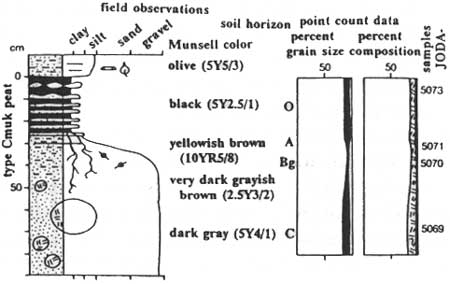
|
| Figure 3.25. Measured section, Munsell colors, soil horizons, grain size, and mineral composition of the type Cmuk paleosol below the "Black Spur", which is within the middle Eocene Clarno Formation and correlated to a level of 20 m in the reference section (Fig. 3.4). Lithological key as for Fig. 3.3. |
Further examples. Cmuk paleosols were only found in the trench excavated below the basalt of "Black Spur", and are not visible in outcrop because entirely covered by brown silt in addition to the type Cmuk profile at 11.6 m in this trenched section, others were found at 14.9 m, at 16.4 m and at 23.7 m.
Alteration after burial. This green-gray lignite-bearing paleosol has suffered no obvious loss of organic matter, burial gleization or dehydration of ferric hydroxides. There has been only modest thermal maturation of the coaly surface horizon. Its lignitic rank is apparent from its friable nature, low bulk density and abundant recognizable plant fiber in thin section. Compaction of this clayey profile and especially its surficial lignite was probably considerable. Compaction of black lignites of this kind to 25% of former peat thickness is considered normal (Ryer and Langer, 1980; Cherven and Jacob, 1985), but in this case the lignite is rich in clay which is a little more compaction resistant than pure plant debris.
Reconstructed soil. Cmuk paleosols originally consisted of thick (50 cm or more) impure peat overlying carbonaceous silt with leaves, roots and relict bedding. This surface rooted horizon passed down in some profiles into massive boulder clay of volcanic mudflows little altered by soil formation beyond small local nodules and skins of black amorphous iron-manganese. Their soil reaction was probably acidic and their Eh reducing, and this placed constraints on plant growth despite evidence of nutrients from abundant well easily weathered plagioclase grains.
Classification. Although now thinned by compaction, the peaty surface horizons of these paleosols would formerly have been thicker than 40 cm, and so qualify as Histosols in the U.S. soil taxonomy (Soil Survey Staff, 1990). Abundant planar clay partings within the lignite and preservation of relict bedding in the surface of the mineral horizons are evidence that this was a permanently waterlogged swamp prone to flooding, and so rules out Folists. The mix of decomposed and recognizable plant debris in the lignite is most like that of Hemists. In the F.A.O. classification (1974) Cmuk paleosols were probably Eutric Histosols. These are most similar to Humic Gleys of the Australian classification (Stace and others, 1968). Organic soils are not subdivided in the Northcote (1974) key.
Paleoclimate. Peat accumulation is encouraged by local waterlogging rather than climatic conditions, but in general peat accumulates in non-seasonal climates in which precipitation exceeds evaporation (McCabe and Parrish, 1992). The high clay content of the lignite and numerous claystone partings in one of the Cmuk paleosols indicate conditions marginal for peat accumulation and rule out extremely wet (more than 2000 mm mean annual rainfall) tropical climates of the kind that encourage the development of raised bogs (ombrotrophic mires of Moore and Bellamy, 1971). There is also some evidence of seasonal draining of the swamp, in the form of burrows within both the coal and its underclay. The burrows are simple krotovinas 1-4 mm in diameter and filled with clayey matrix from above (meta-isotubules in the terminology of Brewer, 1976). Such burrows are made by beetles and other air-breathing insects in soils, and show no marginal concretions or internal spreiten of the kind formed by creatures of waterlogged soils.
Also of paleoclimatic significance are fossil plants found within the type Cmuk paleosol. The leaves of Meliosma are of leathery texture and show a clear drip tip as is common in tropical wet climates, where modern relatives of this genus thrive today (Manchester, 1981, 1994). In addition the dominance of this swamp by dicots is most like swamps of central America south of Mexico (Breedlove, 1973; Porter, 1973, Hartshorn, 1983). In northern Mexico and the United States in contrast, swamps are dominated by conifers such as bald cypress (Taxodium distichum: Best and others, 1984), and the dominance of swamps of temperate to subtropical climates by taxodiaceous conifers can be traced back in the fossil record at least into Late Cretaceous times (Retallack, 1994b).
Ancient vegetation. The thick peaty surface horizon, associated fossil logs and tabular systems of thick carbonaceous fossil roots are evidence of swamp forest for Cmuk paleosols. This vegetation was dominated by dictotyledonous angiosperms, which are preserved in the paleosols as compressed leaves with cuticles and include laurels (Litseaphyllum presanguinea) and aguacatilla (Meliosma sp. cf. M simplicfolia), as well as fragments of a broad-leaved grass or sedge (Graminophyllum sp.: from locality L1757). This fossil flora deserves more ambitious collecting because some of the leaves have preserved cuticles, which are rare for the Clarno Formation. Although current understanding of this vegetation is incomplete, its lower diversity and shared elements with the fossil flora of Sayayk paleosols confirm that Cmuk paleosols were marginally swampy, and perhaps seasonally drained. Permanent swamps are difficult anaerobic and oligotrophic substrates for plants, and commonly support vegetation distinct from nearby vegetation of dry land (Lind and Morrison, 1974).
Former animal life. No fossil bones were found in Cmuk paleosols, which are in any case insufficiently calcareous to allow bone preservation (Retallack, 1984a). Fossils of the Bridgerian North American Land Mammal Age are known from the "Nut Beds" at this stratigraphic level (Hanson, pers. comm. 1990), and aquatic creatures such as the alligator may have ventured into these swamp woodlands.
Paleotopographic setting. Cmuk paleosols were found within a restricted stratigraphic interval low in the sequence of conglomerates below a marker bed of basalt and above the top of a dome of porphyritic dacite and its colluvial cover of boulders weathered to clayey Pswa paleosols. The dome and its clayey paleosols in the "Mammal Quarry" are at a stratigraphic level less than 10 m below the basal ash-flow tuff of the John Day Formation (Pratt, 1988). Thus some 100 m of sediment overlying the Cmuk paleosol was banked against this ancient hill, which had at least that much topographic relief above the Cmuk swamps. Furthermore this prominent weathered dome would have blocked lahars from the large volcanic edifice to the southwest that supplied mudflows of the "conglomerates of Hancock Canyon". This local barrier appears to have excluded coarse debris from a local swamp or lake, which was presumably impounded by lava flows or other hilly volcanic terrane to the west.
Although there are indications of hilly terrane and even large stratovolcanoes nearby, Cmuk paleosols represent locally waterlogged bottom lands. At least locally these would have been flat and slowly subsiding so that peat could accumulate below water table faster than it could decay.
Parent material. Sandstones and siltstones associated with Cmuk paleosols include abundant grains of little weathered feldspar and volcanic rock fragments of andesitic composition like those associated with Patat and Sayayk paleosols of the "conglomerates of Hancock Canyon". Their ripple marks, plane bedding and lack of large andesitic boulders are similar to fluvial deposits, in contrast to volcanic mudflows responsible for the nearby and coeval "conglomerates of Hancock Canyon" (White and Robinson, 1992). Claystone partings within the Cmuk peats indicate deposition from suspension, probably from ponded floodwaters. Very few weathered clasts derived by erosion of pre-existing strongly developed soils were seen, so that most of this material was either delivered by airfall ash or from very weakly developed soils high on the volcanic edifice, so that its parent material is one of the least weathered of the Clarno paleosols.
Time for formation. These paleosols include well preserved plants and show little evidence of weathering either before or during accumulation of the overlying lignite. The excellent preservation of relict bedding in the underclays is evidence that their sedimentary parent material has been little altered. Better estimates of the time for formation of Cmuk paleosols can be gained from the thickness of their lignites. Peats formed under trees, like the O horizon of the Cmuk paleosol, accumulate at rates of 0.5 to 1 mm/yr (Retallack, 1990a), unlike peats of Sphagnum moss or certain kinds of oligotrophic raised tropical bogs which can accumulate at rates of up to 4 mm/yr (McCabe and Parrish, 1992). Rates of peat accumulation are constrained by the need to bury organic matter beyond the reach of aerobic decay without starving trees roots of oxygen on the one hand, and on the other hand the need to maintain tree growth against inundation by water and clay. Using the more conservative rates and a compaction of peat to lignite of 25% gives estimates of 1,000-2000 years for the type Cmuk paleosol, and 1,000-2000, 400-800 and 2,000-4,000 years for Cmuk profiles successively above that level. These are likely maximum times for formation, considering the high content of clays in these lignites.
Lakayx paleosols
Diagnosis. Red (2.5YR-10R) claystone, thick, abundant shiny slickensided cutans, deeply weathered.
Derivation. Lakayx is Sahaptin for "shine" DeLancey and others, 1988), and refers to the abundant slickensided surfaces of these paleosols.
Description. The type Lakayx clay (Fig. 3.26) was found in the lower part of a trench in lower "Red Hill", above the "Nut Beds", Hancock Field Station (NE1/4 SE1/4 SE1/4 SW1/4 Sect. 21 T7S R19E Clarno 7.5' Quad. UTM zone 10, 702695E 4977388N). This is the lowest red paleosol in the measured section and was called the "Chaney red clay paleosol" by Smith (1988). It is at a stratigraphic level of 70.5 m in the reference section (Fig. 3.4) in the claystones of "Red Hill" and in the late Eocene (Bridgerian-Uintan) upper Clarno Formation.
+23 cm: C horizon of overlying Lakayx paleosol: silty claystone; dark red (10R3/6), weathers weak red (10R4/4): sparse fine root trace of dark red (5R3/2) and granules of white (5Y8/1): faint relict bedding: non-calcareous: porphyroskelic isotic in ferruginized areas and clinobimasepic in drab haloes in thin section, with relict volcanic rock fragments and spherical micropeds: abrupt smooth contact to
0 cm: A horizon: silty claystone, a little more clayey than above; dark red (10R3/6), weathers weak red (10R4/4): common drab-haloed root traces of light gray (5Y7/2), with an additional 2 mm diffuse halo of weak red (5YR4/6): very weakly calcareous: porphyroskelic mosepic to isotic in ferruginized areas and clinobimasepic in drab haloes in thin section, with common spherical micropeds and clay skins (illuviation ferriargillans): diffuse wavy contact to
-30 cm: Bt horizon; claystone; dark red (2.5YR3/6), weathers weak red (10R4/4): sparse drab-haloed root traces of olive yellow (2.5Y6/8); coarse blocky subangular structure, defined by abundant slickensided clay skins (ferriargillans) of very dusky red (10R2.5/2) to dark reddish brown (5YR3/5): few relict grains of weak red (10R4/3): non-calcareous: porphyroskelic isotic in ferruginized areas and clinobimasepic in drab haloes in thin section, with common clay skins (illuviation ferriargillans): gradual smooth contact to
-60 cm: C horizon: silty claystone: dusky red 10R3/4), weathers weak red (10R4/4): sparse root traces of light olive gray (5Y6/2) with 1 mm outer halo of dusky red (7.5YR3/2): slickensided argillans less common than above, so that relict bedding is distinct in places: common ferruginous concretions and lithorelicts up to 2-3 mm diameter of dusky red (10R3/4) and reddish black (10R2.5/1): very weakly calcareous: porphyroskelic isotic to mosepic in thin section, with common deeply-weathered volcanic rock fragments.
Further examples. Lakayx paleosols are much more deeply weathered than otherwise similar Luca paleosols, with very few remaining primary minerals and abundant slickensided clay skins. Lakayx paleosols are known primarily from the lower red beds of "Red Hill" and correlative strata of the upper Clarno Formation. There are 10 successive Lakayx paleosols at this level in the reference section in lower "Red Hill". The Lakayx clay manganiferous variant is the last of these paleosols immediately below a major erosional disconformity, and is distinguished by a drab surface horizon and prominent drab-haloed root traces with additional haloes of iron-manganese (Fig. 3.14, 3.27)
Alteration after burial. Lakayx paleosols have probably been modified by burial decomposition and gleization of organic matter and burial reddening. This is indicated by their common drab-haloed root traces, however, no detectable organic matter or fossil leaf litters were found. Some of the drab-haloed root traces in one of these paleosols (Fig. 3.27) immediately below a major erosional disconformity show evidence of manganese accumulation and depletion of iron (Fig. 3.14), indicative of original rather than burial gleization, but even in that profile the effects of waterlogging were local. They are very strongly oxidized, with no detectable ferrous iron and a brick red color (Figs. 3.26, 27). Compaction of these very clayey paleosols was probably some 70% using the standard equation of Sclater and Christie (1980), and this may account in part for the abundant slickensides in Lakayx paleosols. Illitization has not affected these soils which have clays overwhelmingly of kaolinite and smectite (Smith, 1988).
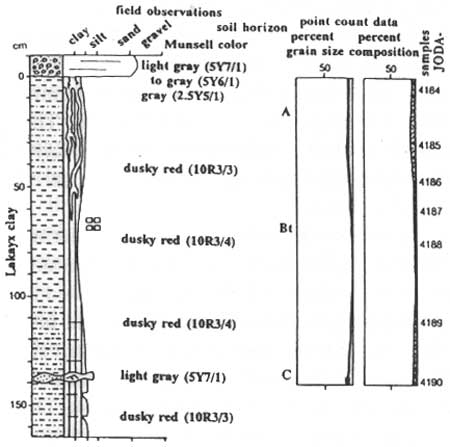
|
| Figure 3.27. Measured section, Munsell colors, soil horizons, grain size, and mineral composition of the Lakayx clay manganiferous variant paleosols in lower "Red Hill", within the middle-late Eocene Clarno Formation at level 85 m in the reference section (Fig. 3.3). Lithological key as for Fig. 3.4. |
Reconstructed soil. Lakayx soils were probably thick, clayey, red and low in fertility. There is a marked increase in clay skins and total clay in the subsurface (Bt) horizon. This trend is reflected in only a muted bulge in the ratio of alumina/silica (Fig. 3.26). In the case of the type Lakayx clay, profile differentiation may have been limited by a strong contribution of deeply weathered parent material, as indicated by common very deeply ferruginized volcanic rock fragments in the parent material. Such clayey profiles would have been slow to drain, but all appear highly oxidized. Only in the case of the Lakayx clay manganiferous variant is there evidence from iron and manganese mobility around root traces (Fig. 3.14) for local seasonal ponding. High ratios of alumina to bases indicate deep weathering and this is also indicated by the near total lack of weatherable minerals or volcanic rock fragments in thin section (Figs 3.26, 27). Soils of this degree of weathering commonly are red rather than brown (Birkeland, 1984), though a dark brownish red surface horizon is likely considering the abundance of fossil root traces, burrows and other evidence of biological activity. There is no evidence of salinization or calcification from the ratios of soda/potash or alkaline earths/alumina. This together with the mixed smectite and kaolinite clay composition is evidence of mildly acidic pH and low base saturation.
Classification. Spherical micropeds and deep oxidation of Lakayx paleosols are similar to Oxisols of the U.S. soil taxonomy (Soil Survey Staff, 1990), however, their alumina/bases ratio of about 4 is not far beyond that typical for Alfisols. The persistence of smectite in these profiles also indicates base status higher than usual for Oxisols. These features together with abundant clay skins and subsurface increase in total clay make Ultisols the most similar soils to Lakayx paleosols. Among Ultisols, the local gleization of the Lakayx clay manganiferous variant is insufficient for Aquults, nor is there evidence for organic matter of Humults or cracking and carbonate of Ustults and Xerults. Among Udults, the most likely suborder, the persistence of appreciable amounts of smectite rule out Kandiudults or Kanhapludults, nor is there plinthite or fragipans of Plinthudults or Fragiudults. Rhodudults are generally even redder than the paleosol after some burial reddening and Paleudults much thicker than Lakayx paleosols. This leaves typic Hapludults as the most similar soil. In the F.A.O. (1974) classification Lakayx paleosols show some similarity with the Oxisol-like Nitosols and Ferralsols, but their clayey subsurface (Bt) horizons mark them as Ferric Acrisols. In Australia such a soil would be classified as a Krasnozem (Stace and others, 1968) or Gn3.11 in the Northcote (1974) key.
Paleoclimate. Lack of carbonate in Lakayx profiles is an indication of rainfall in excess of 1000 mm per year (Retallack, 1994). Smectite is destroyed in favor of kaolinite and gibbsite in tropical Hawaiian soils in climates of more than 2000 mm mean annual rainfall and in temperate Californian soils more humid than 1500 mm (Sherman, 1952; Barshad, 1966). The coexistence of kaolinite and smectite in Lakayx paleosols thus probably reflects a humid climate of 1000-2000 mm per year.
Tropical paleotemperature is likely considering the spherical micropeds common in Lakayx paleosols. These sand-size clay clasts are generally attributed to the activity of termites (Stoops, 1983; Mermut and others, 1984). Termites today are almost exclusively tropical. "In no case are the climatic areas with cold winters and cool summers occupied by termites. The 49°F [8°C] annual isotherm line of both hemispheres encloses almost all native species" (Emerson, 1952, p. 172). The few termite species penetrating temperate regions are primitive species that nest in wood, rather than in the ground. Termites have been found in middle Eocene lake beds near Republic, Washington (Lewis, 1992), and their fossil record of wings and borings goes back into the Cretaceous (Burnham, 1978; Rohr and others, 1986). A search for termite mounds in Lakayx paleosols would be warranted, as a variety of these distinctive trace fossils are now known (Tessier, 1959; Bown, 1982, Sands, 1987), including examples from early Eocene paleosols of Wyoming (T.M. Bown, pers. comm, 1990) and the late Eocene Interior paleosol of South Dakota (Retallack unpublished field notes and D. Terry, pers. comm., 1989).
Some degree of seasonality could be inferred from pisolitic ironstone concretions in the type Lakayx clay, but observation in thin section confirms that these are volcanic clasts with thick weathering rinds and their distribution in the lowest parts of the profile supports interpretation of these as resorted clasts from pre-existing soils. Nevertheless some degree of seasonality of rainfall is indicated by the abundant slickensided clayskins in these profiles. These are not organized into festooned or radiating structures like those of Vertisols, but a dry period of several weeks a year would be compatible with observed cracking of Lakayx paleosols.
Ancient vegetation. The thick, deeply penetrating root traces and well differentiated subsurface clayey horizon with thick clay skins in these paleosols are typical for old growth forest. The high ratios of alumina/bases and pervasive alteration of feldspars and volcanic rock fragments are evidence of oligotrophy of the sort found in rain forest vegetation (Smith, 1988). Also compatible with such an interpretation are the spherical micropeds in Lakayx paleosols (Stoops, 1983) and their high oxidation (negligible values of ferrous/ferric iron: Birkeland, 1984). Nevertheless, there are also indications that these were not so extremely oligotrophic rain forests as many known from modern Amazonia, which unlike Lakayx paleosols are entirely kaolinitic, lack a subsurface zone of clay accumulation and have root traces largely confined to surface horizons (Sanford, 1987; Lucas and others, 1993). Lakayx paleosols thus supported old-growth tropical forest.
No fossil plants have been found in Lakayx paleosols, nor are any likely to be considering their high degree of oxidation (Retallack, 1984a). Nevertheless, Lakayx paleosols are the kinds of profiles expected to support old growth paratropical rain forest assemblages of plants like those known from the underlying Clarno "Nut Beds" (Manchester, 1981, 1994). Red claystones with Lakayx paleosols abruptly overlie conglomeratic paleochannels of the "Nut Beds", and although we are not convinced that there is an angular unconformity separating them (contrary to Hanson, 1973), they do represent a very different sedimentary environment. Nevertheless a number of fossil plants of tropical rain forest affinities are found in the geologically younger Micay paleosols and interbedded fluvial deposits of the "Mammal Quarry" (McKee, 1970; Retallack, 1991a: Manchester, 1994). Because these same species also are known from the "Nut Beds", it is likely that some of them also vegetated Lakayx paleosols.
Former animal life. No vertebrate or invertebrate fossils have been found in Lakayx paleosols which are insufficiently calcareous for preservation of bone and shell (Retallack, 1984a). Fossils of the Bridgerian North American Land Mammal Age are known from the "Nut Beds" which directly underlie the lowest of the Lakayx paleosols (Hanson, pers. comm. 1990). This is generally regarded as a forest adapted fauna and was probably more at home on soils like Lakayx paleosols than the coarse fluvial conglomerates in which the rolled and fragmented bones and teeth were found. As noted above, we do not interpret the contact between Lakayx paleosols and the "Nut Beds" to represent a geologically significant time gap, merely a change in depositional regimen with the cessation of local mudflow deposition.
Paleotopographic setting. Lakayx paleosols are strongly oxidized with deeply penetrating root traces and abundant clay skins, all features of well drained soils. The Lakayx clay manganiferous variant shows some local areas of gleization, but such locally slow drainage would be expected in soils as clayey as these. Thus Lakayx paleosols probably formed in parts of the landscape elevated above regional water table, unlike associated Scat paleosols. The red beds which include Lakayx paleosols thin dramatically to the north and east, and appear to mantle a depression in slopes of the extinct volcano that earlier delivered the thick sequence of mudflows and gravels of the "Nut Beds". Within the sequence of red Lakayx paleosols is a Sitaxs paleosol which developed on ripple-marked silts and claystone breccias similar to those of a small creek channel. The environment of Lakayx paleosols can thus be envisaged as small floodplains and terraces of local creek drainage of a piedmont to an eroding volcanic edifice, or as a post-eruptive volcanic apron in the terminology of Pickford (1986).
The nature of sedimentary processes on this heavily forested piedmont are difficult to discern due to the near total destruction of sedimentary structures by successive buried soils. There are very few fresh volcanic shards or crystals of feldspar in Lakayx paleosols, so that airfall volcanic ash must have been delivered at sufficiently long intervals that it was destroyed by weathering. Thus distant volcanism is not likely to have been an important mechanism of sediment accumulation. There are ferruginized volcanic rock fragments in Lakayx paleosols, derived from pre-existing soils. These observations suggest that creek flooding and colluvial sheetwash, perhaps during unusually destructive storms or earthquakes, were the main mechanism for accumulation of these thick red soils foot slopes of an eroding volcanic edifice.
Parent material. Deep weathering of Lakayx paleosols has destroyed much evidence of parent material. The weakly developed type Scat paleosol beneath the type Lakayx clay could be used as a model for earlier stages in the development of Lakayx profiles, and indicates a parent material of sand and gravel of andesitic volcanics, perhaps with some inputs also from volcanic airfall ash. By this standard the degree of development of Lakayx paleosols is extreme, because very little is left of such clasts in Lakayx paleosols. The lower horizons of the type Lakayx paleosol include very deeply weathered ferruginized volcanic clasts that were presumably derived from erosion of pre-existing soils on these forested slopes of a moribund andesitic volcano. By this standard, Lakayx paleosols are not so deeply weathered from their parent material, but have inherited their low fertility from pre-existing soils higher on the volcano. The true parent material of Lakayx paleosols is probably between these extremes a moderately weathered andesitic colluvium.
Time for formation. With their well differentiated subsurface clayey (Bt) horizons and abundant clay skins Lakayx paleosols are strongly developed in the qualitative scheme of Retallack (1990a). Such soils are normally the product of some tens to hundreds of thousands of years of weathering. Comparable Ultisols of the North American States of Georgia and the Carolinas are on high terraces and other landforms thought to be late Pleistocene in age (Buol and others, 1980). Lakayx paleosols show clay enrichment and other characteristic similar to Sangamon paleosols of Illinois, which began forming between 122 Ka and 132 Ka and were covered in many areas by Wisconsinan tills some 50 to 30 Ka (Follmer and others, 1979). Sangamon paleosols that have been exposed for the full 120 Ka or so since inception have much thicker Bt horizons than the 86 cm estimated before burial compaction of the type Lakayx paleosol, and so do lateritic paleosols and Oxisols that represent landscapes stable for millions of years. Even at 100 ka for each Lakayx paleosol, the sequence of 10 such paleosols in the lower part of "Red Hill" represents a million years of soil formation under wet tropical forests.
Lakim paleosols
Diagnosis. Brown to olive with prominent large black iron-manganese nodules.
Derivation. Lakim is Sahaptin for "soot" (DeLancey and others, 1988) and refers to the black iron-manganese nodules that distinguish these paleosols.
Description. The type Lakim paleosol is at a stratigraphic level of 7 m in a trench excavated by G.J. Retallack, A. Mindszenty, E.A. Bestland and T. Fremd on the eastern side of "Painted Ridge" (section no. 10 of the reference section, SE1/4 NE1/4 NW1/4 NW1/4 Sect 6, T11S R21E Painted Hills 7.5' Quad., UTM zone 10, 717417E 4947425N), in the Painted Hills Unit of the John Day Fossil Beds National Monument. This is at 242 m in the reference section of the John Day Formation, and in the upper part of the upper Big Basin Member, which accumulated during the late Oligocene Whitneyan North American Land Mammal "Age."
+18 cm: sandy claystone: pale olive (5Y6/4), weathers yellowish brown (10YR5/4): indistinct relict bedding and common feldspar of white (5Y8/2) and volcanic rock fragments of olive (5Y5/3): few joints stained strong brown (7.5YR5/8): very weakly calcareous: intertextic skelmosepic in thin section, with common volcanic rock fragments, feldspar and quartz: abrupt wavy contact to
0 cm; A horizon: sandy claystone: olive (5Y4/3), weathers yellowish brown (10YR5/4): with abundant fine (1 mm diameter) root traces of pale yellow (2.5Y8/4): fine subangular blocky structure defined by clay skins (argillans) of olive (5Y4/4): common sand-size volcanic rock fragments of dark olive gray (5Y3/2) and pale yellow (5Y7/4): few joints stained strong brown (7.5YR5/6): very weakly calcareous: agglomeroplasmic clinobimasepic in thin section, with fresh rock fragments and common feldspar and opaques: gradual wavy contact to
-26 cm: Bg horizon: silty claystone; dark olive gray (5Y3/2), weathers dark grayish brown (10YR4/2): these dark colors form large (10-20 cm) diffuse mottles and layers in olive (5Y4/3) matrix: common small (2-3 mm) mottles of reddish black (10R2.5/1): few root traces of pale olive (5Y6/4) and yellow (5Y7/6): very weakly calcareous: intertextic skelmosepic, with abundant fresh feldspar and volcanic rock fragments: gradual wavy contact to
-35 cm: C horizon: sandy claystone: pale olive (5Y6/4), weathers dark grayish brown (10YR4/2): massive to indistinct bedding: common sand-size volcanic rock fragments of olive (5Y4/4) and yellow (5Y7/6): very weakly calcareous: intertextic skelmosepic, with abundant fresh feldspar and volcanic rock fragments: abrupt wavy contact to
Further examples. These yellow to brown paleosols with their prominent large black mottles and nodules are common in the John Day Formation in the Painted Hills, but rare in the Clarno Formation, and confined to beds of the "Mammal Quarry" both at its type locality and in the reference section. The Lakim clay septarian variant (Fig. 3.28) of the Clarno Formation in the "Mammal Quarry" is distinct from Lakim paleosols of the John Day Formation in its relatively small (2-3 cm diameter) iron-manganese nodules often with the distinctive radial cracks called septaria. Also distinctive for the Clarno paleosols are iron-manganese replacements of root traces.
Alteration after burial. Lakim paleosols have clearly lost organic matter after burial, because their root traces show little remnant of organic carbon and extensive replacement with iron and manganese. No drab haloes or red color were seen so that burial gleization and reddening are unlikely to have been significant. The yellow color of exposures in the "Mammal Quarry" are likely due to oxidation in modern outcrop, but even fresh rock there and in the 1.5 m deep trench excavated into the crest of "Red Hill" has a gray color in relatively warm (Munsell 2.5Y) rather than greenish or blue hues (5Y,5G,5B). These grayish brown siltstones of the "Mammal Quarry" are near the top of the sequence and using the formula of Sclater and Christie (1980) have been compacted to about 71% of their former thickness. There is no mineralogical or chemical evidence for illitization, or zeolitization of these smectitic siltstones with amorphous iron-manganese oxides.
Reconstructed soil. The Lakim soils were probably weakly developed clayey silts with a thin zone of rooting and litter accumulation (A horizon) over bedded siltstone with nodules of iron-manganese (Bg) horizon. Their original color was probably gray with black mottles similar to the paleosols. Iron-manganese nodules form in waterlogged or slowly draining soils. Lakim paleosols were thus prone to waterlogging and stagnation. The lack of red mottled and tabular systems of root traces in Lakim paleosols are indications that water table seldom fell far below the ground surface. Despite these problems for plant growth, Lakim paleosols were relatively fertile, with adequate reserves of nutrient bases and near neutral pH (low values of alumina/bases) and no problems with salt efflorescence or carbonate hardpans (low values of soda/potash and alkaline earths/alumina).
Classification. Lakim paleosols lack diagnostic horizons of most soil orders of the U.S. taxonomy (Soil Survey Staff, 1990), yet show nodules of iron-manganese indicating a greater degree of soil differentiation than Entisols such as the associated Micay paleosols. This leaves Inceptisols as the most likely order and the waterlogged Inceptisols or Aquepts as the most likely suborder. The iron-manganese nodules indicating waterlogging together with their clear relict bedding distinguish Lakim paleosols as Aquentic Placaquepts. Within the F.A.O. (1974) classification, waterlogged soils like Lakim paleosols are included within the Gleysols, and given their abundance of weatherable minerals and lack of other diagnostic features, Eutric Gleysols are the most similar soils. In the Australian classification (Stace and others, 1968), Lakim paleosols are most like Humic Gleys, but are not typical because there is little evidence in the paleosols of the high levels of organic matter found in some of these Australian soils. In the Northcote (1974) key Lakim soils are Uf6.61.
Paleoclimate. Lakim paleosols are so weakly developed that they were not exposed for long enough to register climatic influences. The septarian nodules of the Lakim paleosol in the "Mammal Quarry" could be taken as evidence of climatic drying and cracking of iron-manganese colloids in the soil. The dry season could not have been severe however, because there is no indication of oxidation of these reduced nodules.
Ancient vegetation. Considering the tabular root systems, iron-manganese nodules and relict bedding of Lakim paleosols, their vegetation can be envisaged as bottomland forest taller than vegetation early in the ecological succession of disturbed ground but not so impressive as old growth forest. Poorly aerated soils like Lakim paleosols commonly support trees with buttressed trunks, peg roots (Jenik, 1978), a relatively open canopy, and thick ground cover of ferns or reeds (Hartshorn, 1983).
The distinctive black nodules of Lakim paleosols may reflect a particular species of manganese accumulating plant, as Pickford (1974) has noted circular areas of manganese staining under trees locally called "kuresstin" in the Lukeino area of Kenya. "Kuresstin" is the so-called toothpick tree (Dobera glabra) in the family Salvadoraceae (Dale and Greenway, 1961; Verdcourt, 1968). This plant may explain paleosols similar to Lakim profiles in the Miocene Ngorora Formation of Kenya (Bishop and Pickford, 1975), but neither this genus nor family has been recognized among fossil plants of the Clarno Formation (Manchester, 1981, 1994).
No plant fossils were found in Lakim paleosol of the "Mammal Quarry". Underlying Micay paleosols and interbedded fluvial deposits have yielded a small fossil flora of fruits and seeds (McKee, 1970; Manchester, 1994). A small fossil flora of leaves also has been found in the surface horizon of the Lakim clay green variant paleosol in the middle Big Basin Member of the John Day Formation below the eastern mound of Chaney's leaf beds (L1871). This included dawn redwood (Metasequoia occidentalis), nutmeg tree (Torreya sp. indet.), grass (Graminophyllum sp. indet.), laurel (Cinnamomophyllum bendirei) and walnut (Juglans cryptata). Remains of walnuts were most common in both the "Mammal Quarry" and Chaney's leaf bed assemblages.
Former animal life. No animal body or trace fossils have been found in Lakim paleosols. The underlying Micay paleosols and fluvial deposits have yielded a diverse mammalian fauna of the early Duchesnean North American Land Mammal "Age" (Mellett, 1969; Hanson, 1973, 1989; Schoch, 1989). Although this assemblage includes fish and alligators, the large fish would have required better aerated waters than those ponded on Lakim paleosols. The alligators are of an extinct type (Pristichampsus) that show more fully terrestrial limb structure than living alligators (Langston, 1975), and may have been well suited to swampy ground like Lakim paleosols.
Paleotopographic setting. Lakim paleosols were poorly drained soils of stagnant ponded bottomlands, where iron and manganese was redistributed into nodules but not oxidized by contact with air. The paleosol in the "Mammal Quarry" overlies a sequence of Micay paleosols interbedded with siltstone and a thick paleochannel conglomerate. Pratt (1988) has plotted the distribution of fossil bones in these Micay paleosols and fluvial deposits and found that the orientation of long bones swung progressively up section from east-west to north-south. She interpreted this together with preserved sedimentary structures to reflect the migration and accumulation of a point bar of a meandering stream that filled a local valley into pre-existing volcanic rocks. Within such a setting, Lakim paleosols may have formed in depressions or swales of the point bar system, such as chutes excavated within the upper point bar by flood flow (McGowan and Garner, 1970).
Parent material. Lakim paleosols are not much altered from their parent materials, and associated Micay paleosols and fluvial sediments are altered even less. Both kinds of paleosols in the "Mammal Quarry" developed on silt and sand derived from the erosion of an extinct volcanic center to the east. Both contain common fresh laths of feldspar derived from volcanic ash fall, and there is a bed 20 cm thick of weathered sanidine tuff high in the sequence exposed within the "Mammal Quarry". Both also contain abundant clay and weathered silt grains similar to those seen in Patat paleosols, which may have remained high on the volcanic edifice as a source of sediment. Large volcanic rock fragments are rare and few of them show strongly ferruginized weathering rinds, so that red Pswa paleosols developed on the underlying dacitic dome were probably largely covered as a source of sediment by the time the sequence of the "Mammal Quarry" was accumulating. Even cobbles and pebbles of porphryitic dacite in the basal paleochannel of the "Mammal Quarry" show relatively little weathering and were probably derived from deeply eroded parts of the underlying dome or higher on the volcanic edifice.
Time for formation. Lakim paleosols are weakly developed in the qualitative scale of Retallack (1990a), and thus represent some hundreds to few thousands of years of soil development. Time estimates for Lakim paleosols are tentative because waterlogging evident from iron-manganese nodules can suppress biological activity that would more rapidly form soil from sediment in better drained sites. On the other hand, waterlogging also preserves root traces from aerobic decay, and from this perspective the bedding of Lakim paleosols has not been disrupted by more than a few generations of tree growth.
Luca paleosols
Diagnosis. Red (2.5YR-10YR), thick, claystone, with remnant weatherable minerals.
Derivation. Luca is Sahaptin for "red" (Rigsby, 1965), the color of these paleosols.
Description. The type Luca clay (Fig. 3.29) is the red paleosol immediately below a prominent white tuff, forming a feature here called "Whitecap Knoll", in rolling country between the "Mammal Quarry" and the "Slanting Leaf Beds" 1.2 miles northeast of Hancock Field Station, near Clarno (SE1/4 NW1/4 NE1/4 NW1/4 NW1/4 Sect. 26 T7S R19E Clarno 7.5' Quad. UTM zone 10, 703741E 498852N). The locality and profile has been described by Getahun and Retallack (1991), and the description here includes additional unpublished observations by Paul Drake. Following our current stratigraphic scheme, it is in the upper part of the lower Big Basin Member of the John Day Formation. It probably formed during the Duchesnean North American Land Mammal "Age" considering the single-crystal 40Ar/39Ar radiometric date of 38.19+0.06 Ma obtained by Carl Swisher from the overlying tuff during the course of this work.
+80cm: vitric tuff overlying paleosol: white (5YR8/1), weathers pinkish white (7.5YR8/2): indistinct relict bedding: very weakly calcareous: clear wavy contact to
0 cm: A horizon: clayey siltstone: pale yellow (5Y8/3), weathers pinkish white (7.5YR8/2); common mottles of dark reddish brown (2.5YR3/4) in areas distant from common stout (6-8 mm diameter) woody root traces: few burrows up to 14 mm diameter of white tuff: fine subangular blocky peds defined by slickensided clay skins (sesqui-argillans) of dark reddish brown (2.5YR3/4): porphyroskelic skelinsepic in thin section, with scattered grains of plagioclase, volcanic rock fragments, glass shards and opaques: non-calcareous: diffuse irregular contact to
-47 cm: Bt horizon: silty claystone: dusky red (10R3/4), weathers weak red (10R4/4): common stout (up to 4 mm diameter) root traces of pale yellow (5Y7/4), with drab haloes up to 16 mm diameter of light gray (5Y7/2): angular blocky peds defined by slickensided clay skins (sesqui-argillans) of dark red (10R3/6): few small (1-2 mm diameter) iron-manganese nodules of reddish black (10R2.5/1): non-calcareous: porphyroskelic skelmasepic in thin section, with sparse grains of plagioclase, volcanic rocks, opaques and quartz: diffuse irregular contact to
-141 cm: C horizon: clayey siltstone: reddish brown (2.5YR4/4), weathers weak red (10R4/4): few small iron-manganese nodules and dendrites, as above: indistinct relict bedding: non-calcareous: porphyroskelic skelmasepic in thin section, with common grains of plagioclase, volcanic rock fragments, opaques and quartz.
Further examples. These red clayey paleosols differ from Lakayx paleosols primarily in their persistent pyrogenic minerals, as well as a more silty texture and less common slickensided clay skins. Luca paleosols are common in the lower John Day Formation as well as the upper Clarno Formation. There are 15 successive Luca paleosols in the reference section through the upper part of "Red Hill" (Merriam paleosols of Smith, 1988). The lowest of these above a major erosional discontinuity in "Red Hill" is the Luca clay concretionary variant (Fig. 3.30), characterized by redeposited rounded clasts up to 12 mm in diameter of strongly ferruginized red claystone presumably derived from underlying Lakayx paleosols. These clasts are neither so abundant nor dominantly volcanic, as in Acas paleosols.
Alteration after burial. Luca paleosols, like similar Lakayx paleosols, have probably been altered considerably by decomposition of organic matter, gleization, reddening and compaction (at least 70%) during burial. X-ray diffractograms show no evidence of illitization, recrystallization or zeolitization of these paleosols. Thus their chemical and mineralogical composition largely reflects the original soils, even though their color and mottling has been greatly altered.
Reconstructed soil. Luca soils were probably thick reddish brown profiles with clay-enriched subsurface (Bt) and dark gray surface (A) horizons. Included ferruginized volcanic clasts and claystone clasts may have added to red color of these highly oxidized and presumably well drained profiles. Lack of carbonate and generally deep weathering is compatible with acidic pH, but low alumina/bases ratio, smectite and persistent feldspar laths indicate moderate base saturation. In comparison with Lakayx paleosols which have a similar overall profile form, Luca paleosols would have been more fertile and less sticky with clay when wet. There is no evidence from the ratios of soda/potash or alkaline earths/alumina for salinization or calcification.
Classification. Clearly defined subsurface clayey (Bt) horizons together with chemical and petrographic evidence for moderate base status distinguish Luca paleosols as Alfisols of the U.S. soil taxonomy (Soil Survey Staff, 1990). Luca paleosols are best regarded as Hapludalfs, largely on the rather unsatisfactory basis of negative evidence: they lack fragipans, calcareous nodules, deep cracking, abundant kaolinite and other differentiae of other groups. In the F.A.O. (1974) classification, this would have been a Luvisol. Iron and clay enrichment and base depletion are not so marked as in Plinthic and Ferric Luvisols. Orthic Luvisols would be a possibility if much of the current red color were produced by burial reddening that gives the paleosol the appearance of a Chromic Luvisol. The common red claystone clasts in these paleosols inherited from pre-existing soils and their moderate-strong development are most compatible with Chromic Luvisols. Using similar reasoning, they are more likely to have been Red Podzolics than Grey-Brown Podzolics in the Australian classification (Stace and others, 1968) and Gn4.41 in the Northcote (1974) key.
Paleoclimate. As for Lakayx profiles, the co-occurrence of kaolinite and smectite in Luca paleosols indicates mean annual rainfall between 1000-2000 mm. Unlike the Lakayx clay, however, the Luca clay pisolitic variant has only small amounts of kaolinite, but large amounts of smectite (Smith, 1988). The proportions are so markedly changed that mean annual precipitation in the range 1000-1300 mm is likely. This is not compromised by development of the Lakayx clay, which is comparable with development of the Luca clay pisolitic variant. Furthermore, a Sitaxs paleosol interbedded with Lakayx paleosols has comparable morpholigical development but is more deeply weathered chemically than Sitaxs profiles interbedded with Luca paleosols. Thus there was an abrupt decline in weathering intensity across the major erosional disconformity in the middle of "Red Hill".
No spherical micropeds were noted in Luca paleosols, but it is uncertain whether this means termites inferred for Lakayx paleosols were excluded by lower temperature or other factors. The comparable reddish hue of matrix and redeposited volcanic clasts in the Luca profile immediately above the last Lakayx profile could be taken as an argument for an original color at least as red as Lakayx soils, little reddened during burial. Considering the generally red color of modern tropical soils (Birkeland, 1984), this could be taken as an indication of warm temperatures. The profound bioturbation of Luca paleosols is evidence of high biological productivity found in warm climates.
As in Lakayx paleosols, ferruginized volcanic clasts and patterns of cracking are evidence of a relatively short dry season. This is not expressed as such prominent slickensided clay skins as in Lakayx paleosols, but this difference may be related to a less sticky overall texture of Luca paleosols rejuvenated by volcanic airfall ash.
Ancient vegetation. Luca paleosols show several indications that they supported tall tropical forest: large deeply penetrating drab-haloed root traces, well differentiated clayey subsurface (Bt) horizon with stable (non-slickensided) blocky structure and adequate reserves of nutrient bases and fresh volcanic minerals. The drab surface horizon of many of these profiles may have formed by burial gleization from a reserve of soil humus there, and this is indicated by the finer ped structure in that horizon. These were thus eutrophic forests, so most likely broad-leaved, with good ground cover and thus a single canopy layer. Lakayx paleosols in contrast show little evidence of ground cover or fertility, and true multitiered tropical rain forest grows on soils with even less evidence of ground cover or fertility than Lakayx paleosols (Sanford, 1987; Lucas and others, 1993).
No fossil plants have been found in any Luca paleosols, but a variety of tropical dicotyledonous remains have been found in strata both overlying and underlying the Luca paleosols of "Red Hill" as recounted for Lakayx paleosols. Interpretation of broadleaf semi-evergreen forest with vines and epiphytes is compatible with this local paleobotanical record (Manchester, 1981, 1994). Vegetation may have been different for the geologically younger type Luca clay of the basal Big Basin Member of the John Day Formation on "Whitecap knoll". A small collection of leaves and fruits from late Eocene lake beds (L1568) underlying these red paleosols was dominated by wind-dispersed fruits of walnut-like forms (Cruciptera simsoni, Palaeocarya clarnensis), with common leaves of elm (Ulmus sp. indet.) and dawn redwood (Metasequoia occidentalis). Although this collection is inadequate in size, there are suggestions in this flora of forests more open and deciduous than earlier in the Eocene. Vegetation may have changed again into the early Oligocene Big Basin Member of the John Day Formation, where Luca paleosols are less common among a suite of less deeply weathered soils. Lacustrine beds at this stratigraphic level in several localities (L743, L1352, L1353) have yielded a very different fossil flora similar to that of deciduous single-tiered temperate forests, and dominated by alder (Alnus heterodonta) and dawn redwood (Metasequoia occidentalis; Manchester and Meyer, 1987; Meyer and Manchester, 1994). These lacustrine basins were sampling a variety of vegetation types, as can be seen from our ongoing studies of the Painted Hills where dawn redwood dominated vegetation of swamps on Yanwa paleosols and alder dominated early successional vegetation on Micay paleosols. Nevertheless the lake beds also include a variety of species similar to those found in geologically older deposits associated with Luca paleosols, including walnut (Juglans sp. indet.), laurel (Cinnamomophyllum bendirei) and icacina vines (Palaeophytocrene sp. indet.). Although there were clearly changes in regional vegetation sampled by large lakes, the few Luca paleosols found in the early Oligocene may have supported vegetation with a greater component of tropical and evergreen plants.
Former animal life. Only one vertebrate fossil was found from the red slopes of the type Luca clay in the late Eocene lower John Day Formation (locality L1358). It is a fragment of a tusk, probably of the extinct family of hog-like Entelodontidae. Entelodont tusks also have been found in sequences of Luca paleosols in the lower Big Basin Member on Cant Ranch near Dayville (Coleman, 1949a,b). Such non-calcareous paleosols are unlikely to preserve bone (Retallack, 1984a), but massive enamel of tusks is relatively more resistant to dissolution in soils than most kinds of bone.
Animal life of Luca paleosols at lower stratigraphic levels can be inferred from fossils found in interbedded stream deposits and from geological dating using radiometry and sequence stratigraphy. Carl Swisher has determined a geological age of the 38.19±0.06 Ma for the ash above the type Luca clay and 39.22±0.03 Ma for the basal ash-flow tuff of the John Day Formation overlying the Clarno "Mammal Quarry". Thus the stratigraphic interval from the tuff above the type Luca clay to the base of the beds of the "Mammal Quarry" was deposited during the Duchesnean North American Land Mammal "Age", as dated elsewhere in North America (Swisher and Prothero, 1990). Thus Luca paleosols of the lower Big Basin Member of the John Day Formation probably supported a Duchesnean fauna like that of the "Mammal Quarry" (Mellett, 1969; Hanson, 1973, 1989; Schoch, 1989). This is the geologically most ancient fauna of the "White River Chronofauna" (of Clark and others, 1967), a fauna including many Asiatic immigrants that displaced archaic North American creatures (Retallack, 1985). The "Mammal Quarry" is the geologically most ancient known example of the Duchesnean faunas (Lucas, 1992) and these brown siltstones disconformably overlie a sequence of Luca paleosols. Thus Luca paleosols of the upper Clarno Formation probably supported Uintan faunas with greater similarity to the Bridgerian-Uintan fossil mammals found in the Clarno "Nut Beds" than to the Duchesnean mammals of the "Mammal Quarry" (Retallack, 1991a).
Paleotopographic setting. Luca paleosols were well drained and formed in geomorphic settings well above the water table, as can be seen from their thorough oxidation (low ferrous/ferric iron ratios) and subsurface clay enrichment. As for Lakayx paleosols, we could find little evidence of fluvial paleochannels within the sequence of Luca paleosols in the upper Clarno Formation or lower John Day Formation. There is a unit of fossiliferous lacustrine brown shale within the sequence of Luca paleosols in the lower John Day Formation. There are also several volcanic tuff beds within these shales and between Luca paleosols. The Luca clay pisolitic variant and many other Luca paleosols include common ferruginized clasts redeposited from pre-existing red soils, indicating that colluvial slope wash remained important in these soils. In general however, these are less prominent than feldspars and other indications of additions from volcanic airfall. Thus Luca paleosols formed on volcanic ash and colluvium accumulating on toeslopes of hilly country and terraces of small creek systems. Slopes were probably quite gentle during accumulation of the John Day Formation, because its basal ashflow tuff shows little local thickness change and overlying sequences of Luca paleosols included lakes. These gentle slopes of thick red soils presumably were drained by a local network of creeks unconnected to different source terrains that would have delivered lithologically distinctive materials to form recognizable paleochannels.
Parent material. Luca profiles developed on a mix of colluvially resorted soil and volcanic airfall ash, with more emphasis on the latter than generally comparable Lakayx paleosols. Because some ash beds are preserved with little weathering within sequences of Luca paleosols, their composition can be evaluated with greater accuracy than for sequences of Lakayx paleosols. Especially notable is a thick lithic tuff in the upper Clarno Formation in "Red Hill" and the basal ash flow tuff of the John Day Formation that caps "Red Hill". These appear to be rhyolitic to dacitic in composition (Walker and Robinson, 1990), unlike the andesitic ultimate source of the colluvial component of Luca paleosols.
Time for formation. Luca paleosols show comparable to greater textural differentiation of subsurface clayey (Bt) horizon than Lakayx paleosols. This is moderately to strongly developed in the qualitative scale of Retallack (1990a), and represents tens to perhaps hundreds of thousands of years for each profile. On terraces of the Merced River in the San Joaquin Valley of California, under mean annual precipitation of 410 mm and mean annual temperature of 16°C, Alfisols with subsurface clay accumulation comparable to Luca paleosols are found in lower Modesto and upper Riverbank geomorphic surfaces dated at between 40,000 and 130,000 years old (Harden, 1982, 1990). Similar age can be inferred by comparison with Alfisols of more humid and cool climate (943 mean annual precipitation and 9.8°C mean annual temperature) near Millport, Ohio (Lessig, 1961). Also comparable are Alfisols on phonolitic colluvium less than 40,000 years old in the cool humid climate high on the Kenyan volcano, Mt Kenya (Mahaney, 1989; Mahaney and Boyer, 1989). None of these are ideal comparisons because of differences in climate and parent material, but the consistency of estimates indicates that they are within the correct order of magnitude.
Luquem paleosols
Diagnosis. White bedded volcanic ash with root traces.
Derivation. Luquem is Sahaptin for a fire that has gone out (DeLancey and others, 1988), and refers to the volcanic ash parent material of this paleosol.
Description. The type Luquem (Fig. 3.31) silty clay loam is exposed for some 100 m in the "Fern Quarry", on the hill south of a stock pond 0.5 miles northeast of Hancock Field Station, near Clarno (SE1/4 NW1/4 SE1/4 SW1/4 Sect. 26 Clarno 7.5' Quad. UTM zone 10, 702748E 4977295N). This locality correlates to a level of 18 m in the reference section (Fig. 3.4) and is in the "conglomerates of Hancock Canyon" of the upper Clarno Formation of middle-late Eocene age or Bridgerian-Uintan North American Land Mammal "Ages". This age is supported by a fission track age of 43.0 Ma from a pumice in the Luquem paleosol in the "Fern Quarry" and of 44.3 Ma from a dacite cobble from an overlying lahar (Vance, 1988, pers. comm. 1990).
+93 cm: overlying silty tuff: pale yellow (2.5Y7/4), weathers strong brown (7.5YR5/6): clear relict bedding, with common fossil leaves of pale brown (10YR6/3) and brownish yellow (10YR6/8), arching up from paleosol below: fossil plants mainly fern (Saccoloma gardneri) with some horsetail (Equisetum clarnoi): non-calcareous: intertextic silasepic in thin section, with abundant feldspar and altered shards, and scattered ferri-organans after fossil plants: abrupt slightly wavy contact to
0 cm: A1 horizon: siltstone: pale yellow (2.5Y7/4), weathers yellow (10YR7/6): common plant fragments, including fragmented debris as well as complete rhizomes and roots of dark yellowish brown (10YR4/4): clear relict bedding: non-calcareous: intertextic silasepic in thin section, with abundant plagioclase and altered shards, and scattered ferri-organans after plant debris and ferrans along fine-grained relict laminae: clear smooth contact to
-13 cm: A2 horizon: siltstone: white (10YR8/2), weathers yellow (10YR7/8): sparse root traces and iron stain (ferrans) of yellowish brown (10YR5/8): clear relict bedding: non-calcareous: intertextic silasepic in thin section of sandy laminae grading up to shaly laminae that are insepic agglomeroplasmic some fine ferri-organans after root traces: abrupt wavy contact to
-22 cm: C horizon: siltstone: white (10YR8/2), weathers yellow (10YR7/8): sparse iron stain (ferrans) of yellowish brown (10YR5/8): non-calcareous: intertextic silasepic in thin section, with common feldspar and devitrified volcanic shards, faint relict bedding.
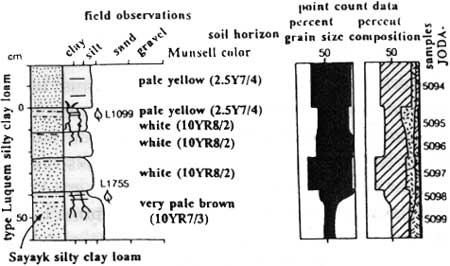
|
| Figure 3.31. Measured section, Munsell colors, soil horizons, grain size, and mineral composition of the type Luquem silty clay loam and Sayayk paleosol in the "Fern Quarry", within the middle Eocene Clarno Formation and correlated to level of 18 m in the reference section (Fig. 3.4). |
Further examples. The tuff that buried the type Luquem silty clay loam paleosol shows no signs of rooting or soil formation in the reference section, which includes the Luquem silty clay paleosol at 56 m (Fig. 3.32). This other profile contains horsetails (Equisetum clarnoi) in place of growth and is strongly permineralized with silica, so crops out strongly within the central exposure of the "Nut Beds."
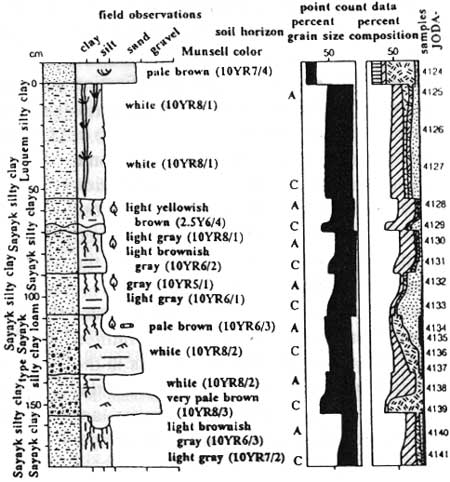
|
| Figure 3.32. Measured section, Munsell colors, soil horizons, grain size, and mineral composition of a Luquem silty clay loam and the type Sayayk silty clay loam paleosol in the "Nut Beds", which is within the middle Eocene Clarno Formation and correlated to a level of 54 m in the reference section (Fig. 3.4). Lithological key as for Fig. 3.3. |
Alteration after burial. Luquem paleosols have the appearance of volcanic tuffs not much altered from their original condition. The accumulation of organic matter, clay and iron hydroxides was not sufficient for burial decomposition, gleization, illitization or reddening to have been important processes. They are however now hard rocks, rather than loose tuffs and this change can be attributed to compaction and cementation after burial. The compaction of such crystal rich silty and sandy materials is evident at some grain contacts in thin section and from small-scale concertinalike deformation of included fossil ferns and horsetails, but was not nearly so marked as the 70% compaction calculated for clayey paleosols such as Luca and Lakayx. Luquem paleosols are also cemented with silica, which clearly post dated the growth of fossil horsetails preserved as cellular permineralizations in the "Nut Beds". However, permineralization could not have been long after plant growth, or tissue structure would have decayed substantially. Thus permineralization within a silica charged hot spring is likely, rather than silicification entirely during burial. Silicification late during burial is also negated by the uncompacted form of permineralized plant remains. Nevertheless some addition of silica during burial is a likely explanation for chalcedony filling pores and vugs in these paleosols, and these soils were certainly not cemented to the hard rocks of today when they supported the growth of ferns and horsetails.
Reconstructed soil. Luquem soils were probably white volcanic crystal tuffs, with limited accumulation of litter and penetration of roots in the surface (A horizon) and much relict bedding in a little-altered subsurface (C horizon). Root traces are generally deeply penetrating, indicating good drainage. The abundance of little weathered minerals indicate potentially high fertility and alkaline to neutral pH. Fossil plant debris is well preserved and for the most part identifiable, so that these soils had not fully exploited their potential mineral reserves or built humus and clay reserves to dampen fluctuations in water availability.
Classification. Volcanic ash soils are Andisols in the U.S. soil taxonomy, and those with abundant recognizable volcanic clasts are the Vitrands (Soil Survey Staff, 1990). Given the lush growth of pteridophytes in Luquem soils, they were presumably well supplied with moisture, and thus most likely Typic Udivitrands. Similar arguments can be used to identify Luquem paleosols as Vitric Andosols in the F.A.O. (1974) classification. Such volcanic soils are not well accommodated within the Australian classification (Stace and others, 1968), but best accommodated as Alluvial Soils because of the relict bedding that is evidence of some fluvial redeposition after volcanic airfall. In the Northcote (1974) key Luquem paleosols are Um1.21.
Paleoclimate. These paleosols are too weakly developed to be regarded as reliable indicators of paleoclimate. The lush growth of fossil horsetails and large-leaved ferns in them is however an indication of a warm wet climate.
Ancient vegetation. Vegetation of Luquem paleosols is unusually well preserved in growth position within the paleosols themselves and arching up into overlying tuffaceous sediments. This extraordinary preservation can be attributed to what Seilacher and others (1985) have called obrution, or rapid burial, in these cases by volcanic airfall ash. In the "Nut Beds" the fossil plants have been preserved as cellular permineralizations, perhaps by silica-charged volcanic hot springs. The type Luquem silty clay loam paleosol supported vegetation mainly of large ferns (Saccoloma gardneri) with lesser amounts of horsetails (Equisetum clarnoi), and the Luquem paleosol in the "Nut Beds" has yielded only horsetails. These particular plants and low specific diversity of these assemblages are typical for vegetation early in the successional colonization of disturbed surfaces (Burnham and Spicer, 1986). Luquem paleosols preserve the very earliest stages in plant succession around these middle Eocene tropical volcanoes. Later stages in the colonization of disturbed ground are recorded in the fossil plant assemblages of Sayayk paleosols which represent pole woodlands and even later stages by Patat paleosols with their fossil stumps and leaf litters of forest.
Former animal life. No animal fossils have yet been found in Luquem paleosols. Fossil mammals are known from paleochannel deposits in the "Nut Beds" overlying the Luquem paleosol there. Although the type Luquem silty clay loam paleosol is stratigraphically 50 m lower in the sequence, it probably is not greatly different in geological age, considering the generally weak development of paleosols and other evidence for rapid accumulation of this sequence of volcanic mudflows. The known fauna includes forest-adapted archaic mammals of the Bridgerian North American Land Mammal "Age" (Retallack, 1991a).
Paleotopographic setting. Both known Luquem paleosols are in sequences of sandstones and grain-supported conglomerates that show cross bedding, ripple marks and graded bedding characteristic of fluvial depositional environments (Retallack, 1991a). They are within thick sequences of such rocks, representing deposition by high energy streams with gravel bedload during periods between influx of sequences of massive volcanic mudflows. Some of the energy of these streams may have been boosted by distal outwash of lahar, though the immediate facies surrounding Luquem paleosols do not have the character of deposits from hyperconcentrated flow (as described by Scott, 1988). The coarse-grained nature of associated paleochannels may be more related to a geomorphic position on foot slopes flanking steep volcanic stratocones. Low angle heterolithic cross-stratification including a Luquem paleosol exposed laterally for several hundred meters of the "Nut Beds" can be interpreted as a deposit of a levee of a moderately sinuous stream (Retallack, 1991a). A similar paleotopographic setting is compatible with what can be observed around the type Luquem paleosol in the "Fern Quarry", where a cross-bedded fluvial paleochannel overlies ash covering the type Luquem silty clay loam. This would imply a lowland near-stream setting within a floodway relatively barren of forest vegetation that would disrupt and disperse ash.
Parent material. The parent volcanic ash of Luquem paleosols is a relatively well preserved mix of silt-sized crystals of sanidine and partly devitrified volcanic shards. The shards are much less abundant in the surface compared with subsurface of the type Luquem silty clay loam, and both shards and crystals are locally obscured by silicification in the Luquem horsetail variant paleosols. Nevertheless these materials remain very similar to other rhyolitic to dacitic tuffs from both the upper Clarno and John Day Formations (Walker and Robinson, 1990).
Time for formation. These soils of minimal profile development are very weakly developed in the relative scale of Retallack (1990a). Their low diversity fossil plant assemblages indicate that they were buried at a very early stage in the successional recolonization of the volcanic ash beds. In a tropical climate that supported regional vegetation as lush as indicated by fossil plants in the Clarno Formation (Manchester, 1981, 1994) and the various paleosols described here, this would be a matter of only a few years. Luquem paleosols show comparable development to Chova paleosols of Guatemala, which formed on thick pumiceous ash from the October 1902 eruption of Volcan Santa Maria (Simmons and others, 1959).
Micay paleosols
Diagnosis. Brown to olive claystone with root traces and relict bedding.
Derivation. Micay is Sahaptin for plant root (Rigsby, 1965), traces of which distinguish these paleosols from sedimentary rocks.
Description. The type Micay clay (Fig. 3.28) is the upper profile in a measured section made by Pratt (1988) in the west wall of the "Mammal Quarry," 0.8 miles north of Hancock Field Station, Clarno area (SW1/4 NW1/4 NE1/4 NE1/4 SW1/4 Sect. 27 T7S R19E Clarno 7.5' Quad., UTM zone 10, 703283E 4978117N). Micay is a new name for the "Chaenactis clay paleosol" of Pratt (1988). This is 400 m north of the reference section of the upper Clarno Formation, but can be correlated to a level of about 126 m in that section. Associated mammal fossils in the quarry indicate that this paleosol formed during the late Eocene Duchesnean North American Land Mammal "Age" (Hanson, 1973, 1989; Lucas, 1992). It is only a few meters stratigraphically below the welded tuff of member A of the John Day Formation dated here using the single-crystal 40Ar/39Ar technique by Carl Swisher at 39.22±0.03 Ma.
+15 cm; clayey siltstone overlying paleosol; pale olive (5Y6/3), weathers light olive brown (2.5Y5/4); indistinct relict bedding; non-calcareous; porphyroskelic argillasepic in thin section; abrupt wavy contact to
0 cm; A1 horizon; silty claystone; pale yellow (5Y7/4), weathers light olive brown (2.5Y5/4); with common stout (up to 5 mm) dark gray (5YR4/1) woody root traces; medium platy peds outlined by few clay skins (sesqui-argillans) of reddish brown (5YR4/4); porphyroskelic skelinsepic in thin section, with abundant (30%) fecal pellets and common large volcanic rock fragments with pilotaxitic andesine (An35) laths; non calcareous; gradual wavy contact to
-6 cm; A2 horizon; clayey siltstone; pale yellow (5Y7/3), weathers light olive brown (2.5Y5/4); with few stout dark gray (5YR5/4) root traces; indistinct relict bedding, broken by sparse clay skins (sesqui-argillans of strong brown (7.5YR4/6) and yellowish red (5YR5/8); non-calcareous; porphyroskelic skelinsepic in thin section, with common volcanic rock fragments and rare quartz; gradual wavy contact to
-10 cm; C horizon; siltstone; pale yellow (5Y7/3), weathers light olive brown (2.5Y5/4); relict bedding; weakly calcareous; argillasepic skelinsepic in thin section with common volcanic rock fragments.
Further examples. Micay paleosols were found also in the uppermost Clarno Formation within the reference section, and are common in the overlying John Day Formation. Micay paleosols are weakly developed like Scat paleosols, which are comparable gray paleosols interbedded with lahars in the Clarno Formation. Unlike Scat paleosols however, Micay profiles are developed on silty to clayey redeposited tuffs, rather than volcaniclastic gravels.
Alteration after burial. The green-gray color of Micay paleosols may be due in part to burial gleization of organic matter that probably decomposed during burial to leave clayey to manganiferous root traces. These clayey paleosols probably also were compacted by 70% typical for paleosols in this area. There is no indication from color or mineral composition for burial reddening or illitization.
Reconstructed soil. Micay paleosols would originally have been gray clays with some surface accumulation of organic matter and root penetration of the surface (A horizon) above a massive to faintly bedded subsoil (C horizon). This subsoil was not so clearly ashy as in Luquem paleosols, and shows weathering of a mixed volcanic airfall component that has largely destroyed evidence of volcanic shards. Considering its relatively fresh feldspar crystals and fluvially redeposited andesitic rock fragments, Micay paleosols probably had relatively low bulk density, high base saturation, near neutral pH and other andic properties. Root traces, though fine are deeply penetrating, as in well drained soils. There is no mottling or mineral accumulations suggestive of waterlogging, calcification, or salinization.
Classification. In the U.S. soil taxonomy (Soil Survey Staff, 1990) such very weakly developed soils are best classified as Entisols. Micay profiles are drab colored with shallow root traces, indicating some waterlogging, so are best identified as Aquandic Fluvaquents. In the F.A.O. (1974) classification, Micay paleosols are most like Eutric Fluvisols. In the Australian classification (Stace and others, 1968), they are similar to Alluvial Soils. They can also be described as Uf1.41 in the Northcote (1974) key.
Paleoclimate. Micay paleosols are insufficiently developed to be useful indicators of paleoclimate, although the evident deep weathering of volcanic shards in them is compatible with a warm humid climate.
Ancient vegetation. The fine root traces found within Micay paleosols and their persistent relict bedding are features of soils that support vegetation early in ecological succession of disturbed ground. However, weathering of Micay paleosols is clearly in excess of that seen in Luquem paleosols and short of that seen in Scat and Pasct paleosols. The vegetation of Micay paleosols can be envisaged as open mid-successional pole woodlands with good herbaceous ground cover.
Micay paleosols and underlying fluvial deposits of the "Mammal Quarry" have yielded a small fossil flora of fruits and seeds (McKee, 1970; Manchester, 1994), including a variety of tropical vines (Odontocaryoidea nodulosa, Diploclisia sp. indet., Eohypserpa sp. indet., Iodes sp. indet., Palaeophytocrene sp. cf. P. foveolata, Vitis sp. indet., Tetrastigma sp.), sycamores (Platananthus synandrus), dogwoods (Mastixioidiocarpum oregonense), alangiums (Alangium sp. indet.), cashews (Pentoperculum minimus), and walnuts (Juglans clarnensis). Some of these fossils may have been derived from the Pswa paleosol at the base of the sequence exposed in the Clarno "Mammal Quarry" (Pratt, 1988). In open near-stream settings envisaged for Micay paleosols, many of these seeds could also have been derived from other nearby communities. However, living sycamore is known to be an early successional colonizer of streamsides and such a role is likely also for the extinct Clarno species (Peattie, 1950; Manchester, 1986; Retallack, 1991a).
Former animal life. Micay paleosols and closely associated fluvial deposits in the Clarno "Mammal Quarry" have yielded an array of fossil animals: alligators (Pristichampsus sp. indet.), creodont carnivores (Hemipsalodon grandis), sabre-tooth cats (Nimravinae gen. et sp. indet.), rodents (gen. et sp. indet.), anthracotheres (Heptacodon sp. indet), oreodons (Diplobunops sp. indet.), rhinoceroses (Teletaceras radinskyi and Procadurcodon sp. indet.), tapirs (Plesiocolopirus hancocki and Protapirus sp. indet.) and horses (Epihippus gracilis and Haplohippus texanus: Mellet, 1969; Hanson, 1973, 1989; Schoch, 1989). Some of these creatures, particularly the common small rhinoceros (Teletaceras radinskyi) evidently lived on Micay paleosols, because they are represented by moderately complete though disarticulated specimens. One could make similar arguments for the alligator, creodont and oreodon which are represented by complete and fragile skulls that would not withstand long-distance transport. The other taxa could have come from further afield, considering Pratt's (1988) conclusion that they accumulated on a fluvial point bar as isolated elements or groups of bones still united by flesh.
Paleotopographic setting. Pratt (1988) has shown that Micay paleosols of the Clarno "Mammal Quarry" formed on siltstones capping an overall fining-upwards sequence from a basal conglomerate. This thin (10-35 cm) basal clast-supported conglomerate of porphyritic andesite pebbles (0.8-9 cm diamter) and well rounded fossil bone and wood, is similar to the channel lag of a mountain stream. It is overlain by 10-45 cm of massive silty sand with up-section decrease in pebbles and increase in bedding. This and the overlying bedded silty sands with carbonaceous stringers yielded most of the fossil bone and plants. Fossils persist, but are less common in an overlying sequence of Micay and Lakim paleosols. The orientation of fossil long bones in Micay paleosols and underlying fluvial deposits swings progressively up section from east-west to north-south. This can be explained by migration and accumulation of a point bar of a meandering stream that filled a local valley into pre-existing volcanic rocks. Micay soils would have formed the better drained vegetated surfaces of the point bar, only slightly elevated from Lakim soils of local swales.
Parent material. Micay paleosols formed on silt and sand derived from the erosion of an extinct volcanic center to the east as well as from volcanic ash fall. They contain abundant fresh laths of feldspar but only rare volcanic shards, and there is a bed 20 cm thick of white little-weathered rhyodacitic tuff high in the sequence exposed within the "Mammal Quarry". Compared with the tuffaceous component, grains of porphyritic andesite are less common, and few of them have ferruginized weathering rinds. Although both components were probably mixed and redeposited by river action, the rhyodacitic tuffaceous component dominated the andesitic alluvial component.
Time for formation. Micay paleosols are weakly developed in the qualitative scale of Retallack (1990), lacking clear relict bedding as well as diagnostic horizons of soils more differentiated than Inceptisols of the U.S. soil taxonomy (Soil Survey Staff, 1990). Volcanic soils in humid tropical New Guinea form fine crumb structure and discernible pedogenic clay within 300-2000 years (Bleeker and Parfitt, 1974; Bleeker, 1983) and have completely lost volcanic glass by 8,000 to 27,000 years (Ruxton, 1968). These are upper limits on the time for formation of Micay which have relict shards and little pedogenic clay. On the other hand, Micay paleosols represent more than just a few growing seasons as for Luquem paleosols. Micay profiles probably formed over a few hundred years.
Pasct paleosols
Diagnosis. Olive-gray to orange, thick, slickensided, subsurface, clayey (Bt) horizon.
Derivation. Pasct is Sahaptin for "cloud" (Rigsby, 1965), and refers to the gray subsurface horizon of these paleosols.
Description. The type Pasct clay paleosol (Fig. 3.33) is high in the reference section (128 m) immediately below the basal ash-flow tuff (member A) of the John Day Formation in the northern corner of "Red Hill", Hancock Field Station, near Clarno (SW1/4 NW1/4 NW1/4 SE1/4 Sect. 27 T7S R19E Clarno 7.5' Quad. UTM zone 10, 702783E 497753N). The brown clays including it can be correlated with similar deposits in the nearby "Mammal Quarry", which has yielded fossils of the late Eocene, Duchesnean North American Land Mammal "Age" (Hanson, 1973, 1989; Lucas, 1992). This paleosol is immediately below the welded tuff using the single-crystal 40Ar/39Ar technique by Carl Swisher at 39.22±0.03 Ma.
+930 cm: granule tuff: pale yellow (2.5Y7/4), weathers brown (10YR5/3); with common small (2 mm) bipyramidal quartz crystals and rock fragments of brownish yellow (10YR6/6) and red (10YR4/6): weakly calcareous: agglomeroplasmic argillasepic in thin section, with sand-size grains of volcanic quartz and feldspar, each with a thick oxidation rind (diffusion sesquan): abrupt smooth contact to
0 cm: A1 horizon: silty claystone: dark brown (7.5YR3/2), weathers brown (10YR5/3): common carbonaceous plant debris very dark brown (7.5YR3/1), including root traces and twigs up to 3 cm wide: non-calcareous: fine granular peds, with dark clay skins (organans) in places: porphyroskelic mosepic in thin section, with root traces lined with carbonaceous and ferruginous clay: gradual irregular contact to
-2 cm: A2 horizon: silty claystone: light gray (5Y6/1), weathers brown (10YR5/3): common carbonaceous root traces of dark brown (7.5YR3/2): medium granular peds, defined by clay skins of brownish yellow (10YR6/6): few krotovinas up to 20 cm diameter filled with sandy ash from above: non-calcareous: porphyroskelic mosepic in thin section, with common clay skins (ferri-argillans) defining granular peds and clasts mainly of feldspar: gradual irregular to
-18 cm: Bt horizon: claystone: dark gray (5Y4/1), weathers brown (10YR5/3); common carbonaceous root traces of dark brown (7.5YR3/2) and sesquioxide mottles of brownish yellow (10YR6/6): coarse blocky angular peds, defined by slickensided clay skins of dark gray (5Y4/1) or brownish yellow (10YR6/6): non-calcareous: porphyroskelic clinobimasepic in thin section, with scattered feldspar and deeply weathered porphyritic volcanic rock fragments: gradual irregular contact to
-72 cm: C horizon: silty claystone: dark gray (5Y4/1), weathers brown (10YR4/3): common clay skins of light yellowish brown (10YR6/4): non-calcareous: porphyroskelic clinobimasepic in thin section, with common feldspar and volcanic rock fragments.
Further examples. There is another Pasct paleosol in the claystones of the "Mammal Quarry" immediately below the type Pasct clay paleosol, but none within the underlying red beds of the upper Clarno Formation. Pasct paleosols also are found at various levels of the "Nut Beds" and in the "conglomerates of Hancock Canyon" within the reference section, and these range from middle to late Eocene or Bridgerian-Uintan North American Land Mammal "Age." For example the Pasct clay brown variant is within the reference section in the sequence of lahars underlying the "Nut Beds" (Fig. 3.34).
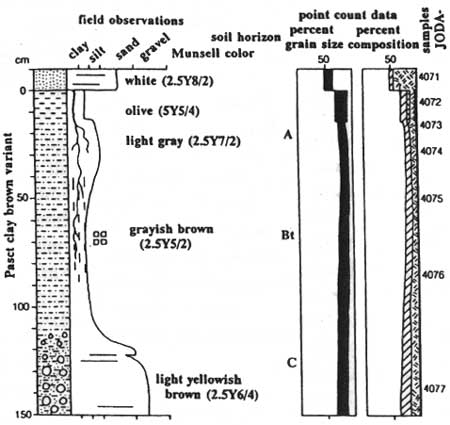
|
| Figure 3.34. Measured section, Munsell colors, soil horizons, grain size, mineral composition and selected molecular weathering ratios of the Pasct clay brown variant paleosol in the conglomerates underlying the "Nut Beds", of the middle Eocene Clarno Formation at a level of 18 m in the reference section (Fig. 3.4). Lithological key as for Fig. 3.3. |
Alteration after burial. Pasct paleosols present a conundrum of clay illuviation, base loss and low ferrous/ferric ratios of a well drained soil but have dark gray color of a gleyed soil. The color of the profile may be in part a product of burial gleization and decomposition of soil organic matter. Some Pasct profiles have orange-stained slickensided clay skins, but these do not persist into the outcrop with further excavation. Their orange to yellow hue is indicative of goethite or other iron hydroxides from weathering in the modern outcrop. There are few dark red mottles or other color that would indicate burial reddening. These clayey profiles probably suffered at least 70% compaction calculated from the formula of Sclater and Christie (1980). No mineral or chemical evidence of recrystallization or illitization was seen.
Reconstructed soil. Pasct paleosols were probably clayey soils with dark gray loamy surface (A) horizons over brownish gray subsurface (Bt) horizons, with substantial accumulations of pedogenic clay (alumina/bases ratios). They were moderately well drained as indicated by dominance of oxidized iron (ferrous/ferric iron ratios), and yet not strongly leached except near the surface (Ba/Sr ratios). Nevertheless, some reduced iron near the surface may indicate slow drainage of these clayey soils. The dark clay skins seen in thin section indicate illuviation of humus as well as clay, as in seasonally waterlogged soils. These paleosols have been significantly leached of nutrients (alumina to base ratios are moderate), and were probably acidic to neutral in pH. Abundant feldspar crystals indicate a tuffaceous parentage, but the lack of preserved shards is evidence against andic properties. Ratios of both soda/potash and alkaline earths/alumina show simple leaching depth-functions, and no evidence of salinization or calcification.
Classification. The type Pasct paleosol shows subsurface differentiation of alumina and clay sufficient to qualify as the argillic horizon of the U.S. soil taxonomy (Soil Survey Staff, 1990). Alumina/bases ratios of 1.5-2.4 straddle the Alfisol-Ultisols dividing line, but the abundance of feldspar is more like Alfisols. Pasct paleosols with their tuffaceous parent materials and gray color are best regarded as Aquandic Umbraqualfs. In the F.A.O. (1974) classification they are matched best by Gleyic Luvisols. In the Australian classification (Stace and others, 1968) Pasct paleosols are most like Humus Podzols. In the Northcote (1974) key they are Gn3.94.
Paleoclimate. The leaching of alkalis and alkaline earths and total destruction of volcanic shards leaving only feldspars of pyrogenic origin are compatible with a humid climate, in excess of a mean annual precipitation of 800 mm (Retallack, 1994a). Extremely rainy climates are unlikely considering moderate leaching and hydrolysis indicated by low barium/strontium ratios and moderate alumina/bases ratios.
Banded dark clay skins evident in thin section provide evidence for climatic seasonality. If there was a dry season it was not especially marked, and probably much less than 3 months in duration, because Pasct paleosols lack the system of cracking and veining found in Vertisols.
The strong bioturbation of these paleosols, despite moderate textural differentiation and chemical depth functions, is compatible with a productive tropical to subtropical ecosystem. The somber color of Pasct paleosols may be due to preservation of organic matter, considering ferrous/ferric iron ratios that are too low for permanently waterlogged soils. Pasct paleosols were probably much richer in organic matter than for Acas paleosols, which share this feature of drab color without associated evidence of waterlogging. In tropical regions such well drained organic soils are found in the cooler climatic belts of mountain plateaus.
Ancient vegetation. Carbonaceous debris and root traces in the type Pasct clay are evidence of forest vegetation. The degree of chemical weathering and textural differentiation of the paleosol is compatible with old-growth forest. The somber color and humus-clay skins of Pasct profiles indicate a lush and productive forest with thick well decomposed litter and probably also a good ground cover of the sort found in cool moist areas under abundant herbaceous angiosperms or ferns.
No recognizable plant fossils were found in Pasct paleosols. A small assemblage of fossil fruits and seeds of tropical vines and mesophytic trees was found in and associated with Micay paleosols of the late Eocene Clarno "Mammal Quarry", along strike from the type Pasct clay (McKee, 1970; Manchester, 1994). Among these fossils the tropical moonseed vines (Diploclisia sp. indet.) and black walnuts (Juglans clarnensis) have living relatives that do well on humic fertile soils like Pasct paleosols (Peattie, 1950; Manchester, 1987). These taxa also are common in the "Nut Beds" (Manchester, 1981, 1994), and may have colonized Pasct paleosols within the middle Eocene conglomeratic sequence of the Clarno Formation. Interestingly, Pasct paleosols of the "Nut Beds" and "Mammal Quarry" do not appear greatly different, despite indications of paleoclimatic change from middle to late Eocene time in Lakayx compared with Luca paleosols. Pasct paleosols may have supported vegetation of local cool moist sites that were found at high elevation around the footslopes of volcanoes during middle Eocene time, but at lower elevation as the volcanic edifice was eroded during the cooler and drier climates of the late Eocene. Such middle Eocene montane origins of much of the latest Eocene and Oligocene flora of North America has been postulated on floristic grounds by Wolfe (1987).
Former animal life. No animal fossils were found in Pasct paleosols, nor would any be expected in such non-calcareous paleosols (Retallack, 1984a). Nevertheless Pasct paleosols represent the lushest forest ecosystems at both the stratigraphic level of the Clarno "Mammal Quarry" and the "Nut Beds" where fluvial deposits and associated weakly developed paleosols (Micay and Sayayk) have yielded a variety of forest-adapted mammals. In the middle Eocene "Nut Beds", forest-adapted forms include small four-toed horses (Orohippus major) and tapirs (Hyrachyus eximius: Retallack, 1991a). In the late Eocene "Mammal Quarry", forest-adapted forms include agriochoere oreodon (Diplobunops sp. indet.), tapir (Plesiocolopirus radinskyi) and four-toed horse (Haplohippus texanus). This is not to say that such creatures definitely lived on Pasct paleosols, but merely that Pasct paleosols represent forest ecosystems for which they appear well suited by virtue of their relatively small size, non-cursorial limb structure and low-crowned molars.
Paleotopographic setting. Pasct paleosols probably occupied geomorphic positions above water table, as indicated by their textural and chemical differentiation and overall lack of unoxidized iron. On the other hand, the drab color and inferred high content of humus together with ferrous iron near the surface as evidence of local puddling or slow drainage are indications of flat imperfectly-drained surfaces, such as fluvial terraces. Such an interpretation is in accord with the likely parent material of Pasct paleosols and the occurrence of Pasct paleosols at similar stratigraphic levels with paleochannel grain-supported conglomerates both in the "Nut Beds" and "Mammal Quarry". Two Pasct profiles in the southern outcrop of "Nut Beds" are sandwiched between paleochannel conglomerates. Within the conglomeratic sequence below the "Nut Beds" Pasct paleosols are found in clayey and tuffaceous intervals, whereas the thick volcanic mudflows are associated with Patat and Scat paleosols. No Pasct paleosols were found in the Clarno "Mammal Quarry", which was evidently a channelway with both paleochannel conglomerates and point bar deposits (Pratt, 1988). At this stratigraphic level two Pasct paleosols were found 400 m to the south in the uppermost part of the reference section through "Red Hill". Compared with paleochannel conglomerates along strike, Pasct paleosols have fine grained lower horizons, indicating deposition from gentle currents and from suspension by largely ponded floodwaters, rather than the raging torrents of river channelways.
Parent material. Pasct paleosols contain a mix of feldspars probably derived from volcanic ash fall and andesitic rock fragments derived from fluvial deposition of eroded volcanic rocks. Their lower horizons also contain a large proportion of clay and show clear relict bedding as evidence of deposition of these materials by flood waters. Because point counted amounts of feldspar dominate those of volcanic rock fragments, the composition of this alluvium was probably more like rhyodacitic airfall than andesitic volcanics.
Time for formation. Pasct paleosols are moderately developed in the qualitative scale of Retallack (1990a), a degree of differentiation that usually corresponds to tens of thousands of years. Such time spans are indicated by comparison with generally similar floodplain soils (Walker and Butler, 1983; Birkeland, 1990), as outlined for Acas paleosols. Another indication of age is the lack of volcanic shards in Pasct paleosols despite their abundant feldspars of tuffaceous airfall origin. In cool humid volcanic highlands of New Guinea the complete destruction of volcanic shards by weathering takes about 8,000 to 27,000 years (Ruxton, 1968).
Patat paleosols
Diagnosis. Sandstone with root traces, thick, mildly leached and ferruginized.
Derivation. Patat is Sahaptin for "tree" (Rigsby, 1965), the permineralized stumps of which have been found rooted in several of these paleosols.
Description. The type Patat clay paleosol (Fig. 3.35) is the paleosol in which the "Hancock Tree" is rooted, but 10 m north of that landmark permineralized trunk, in Hancock Canyon, 0.8 miles north east of Hancock Field Station, near Clarno (SW1/4 NE1/4 SW1/4 NW1/4 SW1/4 Sect. 26 T7S R19E Clarno 7.5' Quad. UTM zone 10, 704022E 4978153N). This paleosol and the overlying Sayayk paleosol was overwhelmed by a thick (10 m) lahar and this sequence can be correlated to a level of 30 m in the reference section, within the "conglomerates of Hancock Canyon" of the upper Clarno Formation of middle to late Eocene age or Bridgerian-Uintan North American Land Mammal "Age."
+6 cm: siltstone overlying paleosol: pale yellow (2.5Y7/4), weathers yellow (10YR7/6): common folded leaf impressions of yellowish brown (10YR5/6), mainly sycamore (Macginitea angustiloba) and katsura (Joffrea speirsii): scattered twigs up to 2 cm across of dark brown (10YR3/3): also large stump 39 cm in diameter and 60 cm high: weakly calcareous: agglomeroplasmic insepic in thin section, with common feldspar laths: abrupt smooth contact to
0 cm: A1 horizon: clayey siltstone: light gray (2.5Y7/2), weathers dark brown (10YR3/3): common root traces of yellowish brown (10YR5/6): abundant iron-stained joints (diffusion ferrans) of yellowish brown (10YR5/6) and light olive brown (2.5Y5/4): uppermost surface shows impressions of leaves like those in overlying sediment: non-calcareous: agglomeroplasmic insepic in thin section, with common volcanic clasts, both fresh and deeply weathered with ferruginized rinds (diffusion sesquans): gradual smooth contact to
-10 cm: A2 horizon: siltstone: yellow (2.5Y7/6), weathers dark brown (10YR3/3): common root traces up to 11 mm wide of yellowish brown (10YR5/6): coarse angular blocky peds defined by ferruginized joints (diffusion ferrans) of dark yellowish brown (10YR4/4) and brownish yellow (10YR6/8): non-calcareous: intertextic skelmosepic in thin section, with common feldspar and volcanic rock fragments: clear smooth contact to
-21 cm: Bw horizon: medium-grained sandstone: light yellowish brown (2.5Y6/4), weathers yellowish brown (10YR5/2) and dark brown (10YR6/4): common root traces of yellowish brown (10YR5/6): scattered volcanic rock fragments up to 3 mm diameter of light olive brown (2.5Y5/4): very coarse blocky peds defined by ferruginized joints (diffusion ferrans) of dark yellowish brown (10YR4/4) and yellowish brown (10YR5/4): non-calcareous: intertextic insepic in thin section with abundant volcanic rock fragments, commonly surrounded with irregular skins of iron-manganese: gradual smooth contact to
-35 cm: BC horizon: coarse-grained sandstone: pale yellow (2.5Y7/4), weathers very pale brown (10YR7/4): weak relict bedding: scattered volcanic rock fragments up to 5 mm in diameter of light yellowish brown (2.5Y6/4): some iron-manganese skins (mangans) of very dark grayish brown (10YR3/2): weakly calcareous: intertextic insepic in thin section, with abundant volcanic rock fragments showing weathering rinds (diffusion sesquans): abrupt wavy contact to
-51 cm: C horizon: granule conglomerate: light yellowish brown (2.5Y6/4), weathers very pale brown (10YR7/3): common volcanic rock fragments of grayish brown (2.5Y5/2) and iron manganese skins of very dark gray (10YR3/1): reverse graded bedding near the base and normally graded bedding near the top enclose an interval of bedding defined by pebble trains: weakly calcareous: intertextic skelmosepic in thin section, with abundant porphyritic andesite volcanic rock fragments, commonly with weathering rinds (diffusion sesquans).
Further examples. Patat paleosols show weak development beyond that found in the more common Sayayk sandy paleosols. Patat paleosols were found only within the "conglomerates of Hancock Canyon" along with Sayayk paleosols.
Alteration after burial. Despite the permineralized stumps in overlying lahars, common leaf impressions in A horizons and woody root traces throughout these profiles, carbonaceous material was not seen in the Patat, and presumably decayed during burial, and perhaps also during oxidation in modern outcrop. This may have been accompanied by burial gleization, because both these and Sayayk paleosols have a distinctive green hue in thicker outcrops of Clarno conglomerates along the John Day River to the south of Hancock Field Station. On the Field Station however, Patat paleosols are yellow to orange in color with ferric hydroxides that may be the result of oxidation in the modern outcrop. Patat paleosols do not have the red hues that result from burial reddening of ferric hydroxides. Compaction of these sandy paleosols was probably minimal, judging from the little deformed fossil stumps and root traces in some of them. However they have been lithified by cementation with silica. The uppermost horizon of the type Patat clay is strongly silicified as are the permineralized trunks rooted within it. Some of this silicification may be related to warm alkaline water associated with emplacement of the overlying 11 m volcanic mudflow. The silicified upper portion of type Patat clay is extensively fractured, with the fractures oxidized with orange to brown ferric hydroxides more likely to have been produced by weathering in outcrop than by Eocene weathering and burial dehydration. This part of the profile has evidently suffered local brittle deformation during unroofing and exposure.
Reconstructed soil. Patat soils probably had sandy surface (A) horizons over subsurface (Bw) horizons only weakly oxidized weathered to clay and with much relict bedding preserved. Weathering had leached alkaline earths from the upper part of the profile (low alkaline earth/alumina ratios), but there is a weak reaction with acid in the lower part. Its pH was probably weakly acidic to neutral. Patat soils were rich in nutrient bases, as is evident from common feldspar and volcanic rock fragments and low alumina/bases ratio. They were also well drained judging from their deeply penetrating root traces, scarce reduced iron and overall profile differentiation. There is no evidence from soda/potash ratios or alkaline earths/alumina for either salinization or calcification.
Classification. Patat paleosols lack clear profile differentiation of soil orders other than Inceptisols and Entisols (of Soil Survey Staff, 1990), but are more weathered than Entisols such as associated Sayayk paleosols and lack feldspar laths and shards of primary volcanic ash falls like Micay paleosols. Tropepts and Ochrepts are the most likely suborders for Patat paleosols, and are usually difficult to distinguish because they are distinguished on the basis of isomesic versus seasonal temperature regime respectively. Fortunately Patat paleosols include permineralized stumps with clear growth rings and identifiable as plants of temperate climatic affinities, such as katsura (Joffrea speirsii) and sycamore (Macginitea angustiloba: Manchester, 1986). In the absence of evidence for deep weathering, fragipans, frost heave structures or aridland caliche, Patat paleosols are best identified as Psammentic Eutrochrepts. In the F.A.O. (1974) classification these are Eutric Cambisols. In the Australian classification (Stace and others, 1968) Patat paleosols are most like Brown Earth soils, although such soils of Australia like the Patat paleosol are more weakly developed than the original European concept of Braunerde. In the Northcote (1974) key Patat paleosols, are best described by Um5.51.
Paleoclimate. Patat paleosols are too weakly developed to be good indicators of paleoclimate. Nevertheless, a humid climate is indicated by the degree of weathering of bases and barium, which is modest but impressive for profiles with such clear relict bedding. Similarly the size of the fossil stumps (up to 39 cm diameter) indicates a substantial forest for such weakly developed soils, and such productivity is found in warm climates. Productivity is even more impressive in view of the evidence from marked growth rings preserved in the stumps for seasonal interruption of growth. This is unlikely to have been a response to a dry season for several reasons. The growth rings are more clearly marked than the nearby ring porous condition of some fossil woods from the Clarno "Nut Beds" (Manchester, 1979, 1994), and the fossil woods of Patat paleosols are similar to temperate climate trees such as katsura (Joffrea spiersii) and sycamore (Macginitea angustiloba: Manchester, 1986). No carbonate or cracking is apparent from the paleosols, which have leaf litters better preserved and are much less oxidized and reddened than would be expected for forests subject to a dry season. The growth rings therefore reflect a cool season of leaf fall among these deciduous forests.
Ancient vegetation. Patat paleosols show much relict bedding and only weak weathering of subsurface (Bw) horizons, as in soils supporting vegetation early in the successional colonization of disturbed ground. It is therefore surprising to find common large permineralized stumps rooted in Patat paleosols. A large stump near type Patat clay is 39 cm in diameter and 60 cm high. The "Hancock Tree" also is rooted in this paleosol to the south. It is 39 cm in diameter and shows a 279 cm length of exposed trunk above a concealed basal portion of 115 cm to the base of the lahar and 28 cm to the top of the Patat paleosol: a total preserved length of 322 cm. Other prone fossil logs within the lahar had diameters of 32, 9, 7, 6, 6, and 3 cm. These were thus colonizing forests, intermediate between secondary regrowth and old-growth forest.
Fossil leaf litters have also have been recovered from Patat paleosols both to the east near the "Hancock Tree" and to the west below the "Nut Beds", where they have a few more tropical elements. Near the "Hancock Tree" (L750, L1731, L1733, L1754) Patat leaf litters consist mainly of temperate elements such as sycamore (Macginitea angustiloba), katsura (Joffrea speirsii), and alder (Alnus clarnoensis), with few tropical elements such as laurel (Cinnamomophyllum sp. cf. "Cryptocarya" eocenica). In contrast, Patat leaf litters in the conglomerates below the "Nut Beds" to the east (L1756) yielded mainly tropical elements such as aguacatilla (Meliosma sp. cf. M simplicifolia) and magnolia (Magnolia sp. cf. M leei), with less common temperate elements walnut (Juglans sp. indet.) and sycamore (Macginitea angustiloba). The climatic significance of these taxa is limited because both sycamore and alder can also be considered pioneering trees that tend to dominate early in ecological succession (Burger, 1983; Peattie, 1950; Manchester, 1986). Nevertheless, these leaf litters may represent an ecotone between two distinct kinds of ancient forest. Vegetation comparable to the eastern Patat Macginitea-dominated fossil leaf litters is deciduous tropical forests dominated by Liquidambar macrophylla found at elevations of 1000-2000 m in tropical Mexico (Gomez-Pompa, 1973). Meliosma- dominated assemblages of eastern Patat paleosols would have been comparable to pioneering forests of lowland evergreen rain forest of Mexico ("selva" of Lauraceae of Gomez-Pompa, 1973). Such a reconstruction of deciduous forest on volcanic footslopes to the west and semi-evergreen forest on volcanic toeslopes to the west is compatible with a reconstructed Clarno paleogeography of an andesitic stratocone source for lahars to the east of the study area (White and Robinson, 1992).
Former animal life. No fossil animals have been found in Patat paleosols and none would be expected in such non-calcareous paleosols (Retallack, 1984a). A small mammalian fauna found in the "Nut Beds" is stratigraphically 35 m higher than the type Patat clay, but this probably represents not more than a few tens of thousands of years considering the thick intervening mudflow deposits and weakly developed paleosols. The Bridgerian-Uintan assemblage of forest-adapted animals known from the "Nut Beds" (Retallack, 1991a) probably lived during the time Patat paleosols were formed, but whether they ranged into these cooler upland deciduous forests is unknown, and unlikely in the case of the large tortoises (Hadrianus sp. indet.).
Paleotopographic setting. The type Patat clay was evidently well drained considering the reach of its woody root traces and lack of ferrous iron. The preserved tree trunks also lack buttresses, knee roots or air roots found in tropical plants of waterlogged ground (Jenik, 1978). There is also evidence for upland habitats from the temperate deciduous nature of its leaf litters dominated by sycamore and katsura, which would have been restricted to higher elevations in a landscape with tropical rain forest of the type preserved in the "Nut Beds".
A variety of grain-supported conglomerates, sandstones with parting lineation, graded beds, and ripple marked siltstones are preserved in an around Patat paleosols and are evidence of a nearstream fluvial environment dominated by traction flow. These largely sandy deposits are interbedded with thick (up to 11 m) mudflows with scattered large boulders of porphyritic andesite, typical for volcanic lahars (White and Robinson, 1992). The bed overlying the type Patat paleosol and the bed forming its Bw horizon are massive clayey sands with scattered pebbles and may be deposits from the hyperconcentrated runout waters of volcanic mudflows, like those described from Mt St Helens by Scott (1988). Their environment can be envisaged as the fluvial braidplain on the toeslopes of a large andesitic stratovolcano with gullies coursed by mudflows. In this kind of environment periodic high flow from especially destructive mudflows and outwash create lowland flood terraces, that are colonized by vegetation to create soils like Patat paleosols during periods of lower discharge.
Parent material. The parent material of Patat paleosols is clayey sand of andesitic composition. Despite evidence of deposition from streams and from distal flow triggered by lahars that drained a forested stratovolcano, the volcanic clasts in lower horizons of these paleosols are little weathered. Although probably derived from soils high on the volcanic edifice, these source soils were also little modified from their parent material, as is usual for soils within cool climate zones of large composite volcanoes, even in tropical regions (Simmons and others, 1959; Mahaney, 1989; Mahaney and Spence, 1989).
Time for formation. Patat paleosols are weakly developed in the qualitative scale of Retallack (1990a), with clear evidence of relict bedding little disrupted by plant growth and mineral weathering. Soils developed on the cool humid volcanoes of New Guinea have considerably more clay skins and ped development than seen in Patat paleosols over only 300 to 2000 radiocarbon years (Bleeker and Parfitt, 1974; Bleeker, 1983). A few hundred years is a likely upper limit for time of formation of Patat soils, and is compatible with information from the annual growth rings of their fossil stumps. A large stump near the type profile is 39 cm in diameter and included 32 annual rings toward the rather deformed center. The "Hancock Tree" also is rooted in this paleosol and shows 59 rings as well as another 12 mm too deformed to count within its 39 cm diameter. To this figure should be added several years or tens of years for development of early successional vegetation comparable to that preserved in Luquem and Sayayk paleosols. Thus it is likely that the preserved fossil trunks represent the first tree crop in these paleosols over the first century or so of plant colonization of these disturbed volcanic land surfaces.
Pswa paleosols
Diagnosis. Purple clayey subsurface (Bt), with corestones and gradational contact down to andesitic breccia.
Derivation. Pswa is Sahaptin for "stone" or "clay" (Rigsby, 1965; Delancey and others, 1988), which form a mixture in these colluvial soils.
Description. The type Pswa clay (Fig. 3.36) paleosol is not exposed, but can be revealed by trenching above the track that links Hancock Field Station and the "Mammal Quarry," below "Black Spur" at a point 0.5 miles north of Hancock Field Station, near Clarno (NW1/4 SW1/4 NW1/4 SW1/4 SE1/4 Sect. 27 T7S R19E Clarno 7.5" Quad. UTM zone 10, 703112E 4977736N). The type profile is developed on a talus of large boulders of porphyritic dacite, and is overlain by boulder breccia of dacite with an additional Pswa paleosol. The dacitic parent material may also have yielded the dacite cobble in the lahar above the "Fern Quarry" dated by fission track at 43.6 Ma (Vance, 1988; pers. comm., 1990). This is at a stratigraphic horizon 25 m below the columnar basalt that forms the ridge of "Black Spur", and thus correlates to a level of about 16 m in the reference section. It is within the "conglomerates of Hancock Canyon" of the upper Clarno Formation, and of middle to late Eocene age, or Bridgerian-Uintan North American Land Mammal "Age".
+90 cm: boulder breccia overlying paleosol: light gray (5Y7/1), weathers grayish brown (2.5Y5/2): has angular boulders of porphyritic andesite up to 50 cm across of pale yellow (2.5Y8/4) and olive (5Y5/2) with slickensided weathering rinds (diffusion sesquans) up to 1 cm thick of brownish yellow (10YR6/8): non calcareous: intertextic mosepic in thin section, with deeply weathered clasts of dacite including phenocrysts altered to clay and partly altered pilotaxitic groundmass: abrupt irregular contact to
0 cm: A horizon: silty claystone: light brownish gray (2.5Y6/2), weathers grayish brown (2.5Y5/2): with sparse drab-haloed root traces up to 1 cm diameter of greenish gray (5G6/1): common distinct coarse mottles of dark reddish gray (10R4/1): few irregular ferruginous nodules of brownish yellow (10YR6/8): coarse angular blocky peds defined by slickensided clay skins (illuviation argillans) of brownish yellow (10YR6/8): non-calcareous: porphyroskelic skelmosepic in thin section, with abundant fine root traces and weathered volcanic rock fragments: gradual irregular contact to
-19 cm: Bt horizon: claystone: dark reddish gray (10R3/1), weathers grayish brown (2.5Y5/2): common large (up to 30 cm) deeply weathered boulders of porphyritic dacite of olive yellow (2.5Y6/6): coarse angular blocky peds defined by slickensided clay skins (illuviation argillans) of brownish yellow (10YR6/8): non-calcareous: porphyroskelic clinobimasepic in thin section, common deeply weathered volcanic rock fragments with clay skins (diffusion argillans): gradual irregular contact to
-120 cm: BC horizon: boulder breccia: gray (5Y6/1), weathers grayish brown (2.5Y5/2): common large (up to 70 cm) deeply weathered boulders of porphyritic dacite of olive (5Y5/4) with weathering rinds (diffusion sesquans) of brownish yellow (10YR6/8): non-calcareous: porphryoskelic skelmosepic in thin section, abundant volcanic rock fragments with clay skins (diffusion argillans): gradual irregular contact to
-150 cm: C horizon: boulder breccia: light gray (5Y7/1), weathers grayish brown (2.5Y5/2): common large (up to 90 cm) deeply weathered boulders of porphyritic dacite of olive (5Y5/4) with weathering rinds (diffusion sesquans) of brownish yellow base (10YR6/8): non-calcareous: porphryoskelic skelmosepic in thin section, abundant volcanic rock fragments with clay skins (diffusion argillans): gradual irregular contact to
-170 cm: R horizon: porphyritic dacite: greenish gray (5Y5/1), weathers grayish brown (2.5Y5/2): non-calcareous: intertextic crystic in thin section, with relict pilotaxitic groundmass and large zoned phenocrysts of plagioclase and hornblende all altered in part to clay and opaque oxides.
Further examples. The type Pswa paleosol is buried by boulder breccia that includes another Pswa paleosol. These are the only profiles of this kind seen during this study, although one would expect similar profiles to be common on other porphyritic dacite or andesite flows of the Clarno Formation, given the long time of formation necessary for this pedotype.
Alteration after burial. Pswa paleosols are purple-red, mottled and low in organic matter and so probably discolored substantially by burial decomposition and gleization of organic matter and burial reddening of ferric hydroxides. Also likely is compaction of clayey parts of the profile to 70% of their former thickness calculated from the equation of Sclater and Christie (1980). The boulders of weathered dacite on the other hand show little evidence of deformation by compaction of their relict crystal structure, and in some cases the clayey horizon boundaries have been disrupted by slickensided boulders. There is little indication of illitization from soda/potash ratios which have remained very similar to those of the parent andesite.
Reconstructed soil. The original Pswa soil can be envisaged as a thick (1m) soil with a dark gray clayey surface (A) horizon over a bouldery reddish brown clayey subsurface (Bt) horizon. Although there are numerous relict andesitic boulders the matrix of the subsurface horizon is markedly enriched in both clay skins and total clay. Low ratios of barium/strontium and alumina/bases and persistent volcanogenic minerals indicate weakly acidic to neutral pH and moderate fertility. The type profile has some reduced iron remaining in its clayey subsurface horizon as evidence for impeded drainage, and this is compatible with the gray to purple hue. The thickness of the profiles, thoroughness of their weathering and deep penetration of root traces are evidence of well drained conditions. Soda/potash ratios are high throughout these profiles as in their andesitic parent materials, but there is no up-profile increase as would be expected in a salinized soil. Neither is there any sign of calcification from ratios of alkaline earths/alumina.
Classification. Pswa paleosols show clay enrichment of the subsurface horizon sufficient for argillic horizons found in Alfisols and Ultisols of the U.S. soil taxonomy (Soil Survey Staff, 1990). There alumina/bases ratios of 1-2 and barium/strontium ratios of generally less than 1 are evidence of only modest hydrolysis and leaching, as found in Alfisols rather than Ultisols. Pswa paleosols are most like Lithic Hapludalfs, largely because they lack the red color, iron content, fragipans, deep cracks or other features of other divisions. In the F.A.O. (1974) classification this corresponds to an Orthic Luvisol. In the Australian classification (Stace and others, 1968) Pswa paleosols are like Brown Podzolic soils and in the Northcote (1974) key they are most like Gn2.01.
Paleoclimate. A humid climate is indicated by the way in which Pswa paleosols have been leached of alkalis, alkaline earths and barium compared with their andesitic parent material. At no level on the profiles was there accumulation of carbonate or salts as found in soils formed under mean annual rain fall of less than 1000 mm (Birkeland, 1984; Retallack, 1994a).
The pervasiveness and deep alteration of Pswa paleosols is impressive considering the relict crystal structure of andesitic corestone and only moderate chemical weathering revealed by alumina/bases and barium/strontium ratios. These indications of deep weathering are compatible with a warm climate, but not compelling evidence (Birkeland, 1984; Retallack, 1990a).
No clear cracking patterns or concretions were found that would indicate strong climatic seasonality. However, the reduction spots and ferrous iron low in the Bt horizon of the type Pswa clay may be evidence of slow drainage at that level during a wet season. This was probably not a place of permanent seepage because Pswa paleosols lack rusty mottles or spots of iron manganese like those found in waterlogged soils and Lakim paleosols.
Ancient vegetation. The overall profile form of a subsurface clay enrichment together with large drab-haloed root traces are evidence for old growth forest vegetation on Pswa paleosols. These forests were not so rich in humus and presumed ground cover as those on Pasct paleosols at the same stratigraphic level. Nor were they so low in humus and ground cover deep within the shade of multiple canopy layers interpreted for Lakayx paleosols. Nor were they as low in nutrient bases as Pasct, Acas or Lakayx paleosols. Pswa paleosols probably supported eutrophic well drained tropical forests.
No fossil plants have been found preserved in Pswa paleosols, which were too oxidized to permit preservation of plant material. Interpretation here as soils of tropical forests is consistent with the abundant fossil plants found at comparable stratigraphic levels within Luquem, Sayayk and Patat paleosols and within fluvial conglomerates of the Clarno "Nut Beds" (Manchester, 1981, 1994). However, Pswa paleosols of steep well drained slopes of a tall volcanic dome are not likely to have contributed a great deal of plant material to rivers and mudflows within the nearby heavily forested lowland.
Former animal life. No fossil animals have been found in Pswa profiles, nor would any shell or bone be expected in such acidic paleosols (Retallack, 1984a). Forest-adapted fossil mammals are known from the Clarno "Nut Beds" at about the same stratigraphic level (Retallack, 1991a), but it is uncertain if and which of these creatures ventured from the fluvial lowlands in which they were buried to the steep forested slopes of Pswa paleosols.
Paleotopographic setting. Pswa paleosols developed on the steep slopes of a dacitic volcanic dome, intruded on the flanks of a large stratovolcano that shed the thick sequence of conglomerates exposed in Hancock Canyon and the Palisades (White and Robinson, 1992). This dome of deeply weathered porphyritic dacite had a topographic relief of at least 100 m, because that thickness of Clarno Formation conglomerates and red beds onlap its southern side. The deeply penetrating root traces and deep weathering of Pswa paleosols are both compatible with a well drained land surface. The enormous angular boulders of andesite within the profile, together with abundant small matrix-supported cobbles and granules are most like talus deposits from a steep hillside emplaced by a combination of soil creep, mudflows and rock fall. The second Pswa paleosol formed after a significant episode of slope failure that covered the type Pswa clay with colluvial debris. Pswa profiles were probably in a footslope position, because the overlying sequence of sandstones and shales include Cmuk paleosols of a swampy poorly drained lowland.
Parent material. The parent material of both Pswa paleosols is a porphyritic dacite intrusion, which is exposed at the base of the type Pswa clay. Both Pswa paleosols are littered with large blocks of this rock, presumably derived from cliffs and steep slopes nearby. Even the sand and silt size grains seen in thin section appear to be mostly this same porphyritic dacite. The bulk of both profiles appears to have been a colluvial deposit derived from this volcanic dome. However, there could have been minor additions from airfall volcanic tuff, and one pebble of silicified sandstone (Fig. 3.10) similar to those of the Clarno "Nut Beds" was found in the colluvial sandstone C horizon of the upper Pswa profile.
Time for formation. The Pswa paleosols are moderately developed in the qualitative scale of Retallack (1990a), and this generally corresponds to several tens of thousands of years of soil development (Birkeland, 1990). Brown weathering rinds preserved on andesitic boulders in these paleosols are generally a millimeter or less thick, and this has been found by Colman (1986) to take about 65,000 years in the cool humid climate of Mt Rainier in Washington state, but as much as 150,000 years in the cool dry climate of Truckee in Nevada. In wet and cool parts of Mt Kenya in Kenya, phonolitic lavas that are comparably porphyritic to the Clarno andesite, have been noticeably weathered within 1,940 years, but accumulation of clay to levels that would qualify as argillic has taken 40,000 years or longer (Mahaney, 1989; Mahaney and Boyer, 1989).
Sayayk paleosols
Diagnosis. Sandstone with root traces and clear relict bedding.
Derivation. Sayayk is Sahaptin for "sand" (Rigsby, 1965), which is common in these paleosols.
Description. The type Sayayk clay loam paleosol (Fig. 3.32) is in the southern outcrop of the "Nut Beds," 0.5 miles west of Hancock Field Station, near Clarno (SE1/4 SE1/4 SE1/4 SW1/4 Sect 27 T7S R19E Clarno 7.5' Quad. UTM zone 10, 702744E 4977294N). This is the third in a sequence of comparable partly silicified paleosols above the base of the "Nut Beds" and is at the level extensively quarried for fossil leaves, fruits and wood (Manchester, 1981, 1994). It is within the "Nut Beds" of the upper Clarno Formation. Fossil mammals from overlying strata south along strike have been identified with those of the middle Eocene, Bridgerian North American Land Mammal "Age" (Hanson, 1989). Pumice from the overlying tuffaceous sandstone has yielded a fission track age of 43.0 Ma (Vance, 1988), which is currently regarded as the age of the late Eocene Uintan North American Land Mammal "Age" (Prothero and Swisher, 1992).
+9 cm: siltstone overlying paleosol: light gray (10YR6/1), weathers yellowish brown (10YR5/6): irregular laminae of white (10YR8/1) pumiceous sandstone: sparse fine root traces of yellowish brown (10YR5/4): weakly calcareous: insepic intertextic in thin section, with relict beds of porphryoskelic argillasepic shale, few vugs filled with cavity-lining chalcedony: abrupt smooth contact to
0 cm: A horizon: clayey siltstone: pale brown (10YR6/3), weathers reddish brown (5YR4/4) and yellowish brown (10YR5/6): abundant fossil roots and logs up to 3 cm wide of very dark grayish brown (1OYR3/2) and fossil leaves of yellowish brown (10YR5/6), dominated by aguacatilla (Meliosma sp. cf. M. simplicifolia): weakly calcareous: crystic Porphyroskelic in thin section, with scattered feldspar and volcanic fragments: the fine crystal structure in thin section is due to pervasive silicification, that also preserves in three dimensions some of the cellular structure of fossil root traces: gradual smooth contact to
-10 cm: C horizon: fine-grained sandstone: white (10YR8/2), weathers very pale brown (10YR7/4): stout root traces up to 4 mm diameter of pale brown (10YR6/3), in places replaced with white (10YR8/2): flaggy bedding and local ripple drift cross-lamination in upper part of the bed, lower part is massive with parting lineation: weakly calcareous: crystic porphyroskelic in thin section with interbedded laminae of insepic intertextic sandstone, rich in feldspar and volcanic rock fragments.
Further examples. These sandy weakly developed paleosols are common in the "Nut Beds", which includes 9 of them in addition to the type Sayayk clay loam. Additional profiles of this kind are common in the "conglomerates of Hancock Canyon" of the upper Clarno Formation.
Alteration after burial. Sayayk paleosols are volcaniclastic sandstones little altered from their original condition. The accumulation of organic matter, clay and iron hydroxides was not sufficient for burial decomposition, gleization, illitization or reddening to have been important processes. Compaction is not obvious in thin section, or from preservation of permineralized fossil wood, fruits and leaves with considerable relief. Compaction of these paleosols was certainly much less than the 70% calculated for clayey paleosols such as Luca and Lakayx. Sayayk paleosols are cemented with silica, which must have postdated the growth of plants so abundantly represented by roots and leaves preserved in them. However, permineralization could not have been long after plant growth, or tissue structure would have decayed substantially. Permineralization within a silica charged hot spring is likely, rather than silicification entirely during burial. Some addition of silica during burial may explain chalcedony filling pores and vugs in these paleosols.
Reconstructed soil. Sayayk soils were little more than rooted sands, in which plant growth, animal burrowing and other soil building processes had not proceeded to obliterate bedding of their parent material. They consisted of a surface (A) horizon of roots and leaf litter over a subsurface (C horizon) of bedded volcaniclastic sand. They were probably poorly drained considering the good preservation of fossil leaves in successions of these thin paleosols, but were not permanently waterlogged as their leaf litters were not as thick and carbonaceous as peats inferred for Cmuk paleosols. With their abundant little weathered volcanic clasts, including scoria, pumice and shards, they would have been fertile soils with neutral to mildly acidic pH.
Classification. Such weakly developed soils in the U.S. taxonomy (Soil Survey Staff, 1990) are best matched by Fluvents, considering the great variation in grain size of their parent materials and close association with fluvial paleochannels. Fluvents are subdivided on the basis of climatic criteria which are not evident from such weakly developed paleosols. However, the abundant fossil wood with its diffuse growth rings and diverse, large leaves with drip tips in Sayayk paleosols provide evidence of isothermic tropical climates (Manchester, 1994), as in Tropofluvents. In the F.A.O. (1974) classification Sayayk paleosols would be Eutric Fluvisols. In Australia such profiles are called Alluvial Soils (Stace and others, 1968) or Um1.21 of the Northcote (1974) key.
Paleoclimate. Sayayk paleosols are not sufficiently developed to be indicators of paleoclimate. These paleosols have been the focus of intensive collection of fossil wood, fruits, seeds and leaves (Scott, 1954, 1955, 1956; Manchester, 1981, 1994a, 1994b; Scott and Wheeler, 1982; Manchester and Kress, 1993). A humid rainfall regime is indicated by the dominance of large, entire-margined leaves, many of which include drip tips, as well as by the numerous bars on sclariform perforations of vessels in fossil woods. A tropical temperature regime is indicated by the presence of frost sensitive plants such as cycads, palms and Ensete. Another tropical indicator is the abundance of vines (43% of species with known affinities), which is typical of tropical forest with a multitiered canopy. Growth rings in the fossil woods indicate climatic seasonality, but this was not marked (Scott and Wheeler, 1982). Wolfe (1978) envisages climate for the similar Eocene floras of the nearby Puget Group of Washington with a mean annual temperature of 21-25° and a mean annual range of temperature of 3-7°.
Ancient vegetation. Sayayk paleosols show little disruption of primary bedding by root traces which are generally preserved in part by cellular permineralization with silica of possible hydrothermal origin. Such hot spring fluids can be scalding and caustic, so that vegetation in the vicinity is sparse and is best characterized as ecologically stress tolerant. In the hot springs of Yellowstone National Park, Wyoming, for example, bare terraces of tufa and sinter are colonized largely by cyanobacteria (Ward and others, 1992). Sayayk paleosols lack such massive sinters, tufas and microbial lamination, and contain abundant and diverse broadleaf angiosperm leaves, fruits and wood (Manchester, 1981). Although the preservation of some of these fossils may have been favored by hydrothermal water, these communities are best regarded as early in ecological succession of young land surfaces created by flooding, including catastrophic runout of volcanic lahars. These shrublands or pole woodlands would have been intermediate in ecological succession between the early colonizing fern brakes of Luquem paleosols and the tropical forests of Patat paleosols.
Most Sayayk paleosols have beautifully preserved fossil leaves, and sometimes also fossil fruits and wood. The floristic composition of these early successional pole woodlands could be reconstructed in detail by systematic exposure and census of fossils in the surface horizons of these paleosols. Such studies are beyond the scope this study, but reconnaissance collecting of numerous Sayayk paleosols demonstrated a lateral variation in fossil content that may reflect an ecotonal boundary between two distinct kinds of ancient vegetation. Unlike lacustrine leaf beds in which leaves can be transported and mixed, Sayayk paleosols preserve leaves near their place of growth, as can be seen from the penetrating root traces as well as variation in skeletonization, insect nibbling and folding of fossil leaves comparable to that found in leaf litters of modern soils. A very diverse flora of tropical affinities is found in Sayayk paleosols of the "Nut Beds" (L1359) and western lahars (L1730, L1759, L1761, L1854, L1855, L1856, L1857, L1859, L1860, L1861, L1873); including aguacatilla (Meliosma sp. cf. M. simplicifolia), moonseed (Diploclisia), icacina vine (Goweria dilleri), magnolia (Magnolia leei), laurels (Litseaphyllum praesanguinea, L. praelingue, L. sp. cf. "Laurophyllum" merrilli, Cinnamomophyllum sp. cf. "Cryptocarya" eocenica), tree fern (Cyathea pinnata), horsetail (Equisetum clarnoi), walnut (Juglans sp.), maple (Acer clarnoense), alder (Alnus clarnoensis), katsura (Joffrea speirsii) and sycamore (Macginitea angustiloba). In contrast, a limited fossil flora of temperate affinities is found in lahars to the east (L1650, L1732, L1753, L1760, L1858); including sycamore (Macginitea angustiloba), katsura (Joffrea speirsii), alder (Alnus clarnoensis), laurel (Litseaphyllum presanguinea), and horsetail (Equisetum clarnoi).
The diverse tropical flora is also known from fluvial conglomerates of the "Nut Beds", where botanical affinities, leaf sizes and other indicators have been used to argue that it represents multistratal paratropical rain forest (Manchester, 1981, 1994). This allochthonous flora largely of fruits and seeds is probably in part derived from old-growth forest communities of the type envisaged for Lakayx and Pasct paleosols. Sycamore-katsura floras like those of the eastern Sayayk paleosols are also known from allochthonous Eocene lake beds of the Clarno Formation and elsewhere in the western United States (Manchester, 1986; Crane and Stockey, 1985) and from late successional forest soils such as the Patat paleosols of the Clarno area. The fossil floras of early successional Sayayk paleosols may reflect an ecotone between these two distinctive ecosystem types. Comparable vegetation types of tropical Mexico today include the high evergreen selva of lowlands and the deciduous tropical forests dominated by Liquidambar macrophylla found at elevations of 1000-2000 m (Gomez-Pompa, 1973). Interpretation of Meliosma-dominated assemblages of Sayayk paleosols as early successional lowland rain forest and Macginitea-dominated assemblages of Sayayk paleosols as early successional upland deciduous forests is compatible with a reconstructed paleogeography of an andesitic stratocone source for lahars to the east of the study area (White and Robinson, 1992). Meliosma today includes species of colonizing forests (van Busekom and van de Water, 1989), as does living sycamore (Platanus: Peattie, 1950; Manchester, 1986).
Former animal life. Nibbled and decayed fossil leaves in Sayayk paleosols attest to a varied biota of invertebrate and microbial decomposers in Sayayk paleosols. No vertebrates have been recorded from Sayayk paleosols, but it is likely that the variety of vertebrates known from fluvial conglomerates of the "Nut Beds" traversed these streamside paleosols. Large depressions (13 cm diameter by 7 cm deep) in Sayayk paleosols of the central outcrop of the "Nut Beds" are similar in cross-section to fossil footprints of large mammals found elsewhere in Cenozoic rocks (Loope, 1986). Mammal fossils found in the conglomerates of the "Nut Beds" include a graviportal titanothere (Telmatherium sp. indet.) large enough to have made such tracks, as well as smaller turtles (Hadrianus sp. indet), four-toed horses (Orohippus major), extinct tapirs (Hyrachyus eximius) and lion-like extinct carnivores (Patriofelis ferox).
Paleotopographic setting. There is little indication of paleotopography in Sayayk paleosols other than their weak development compatible with naturally disturbed sites. Sayayk paleosols were found within sandy sequences associated with grain-supported conglomerates interpreted as fluvial paleochannels, both in the "Nut Beds" and near the "Hancock Tree". These paleochannels are within the thick sequence of volcanic mudflows, and in some cases may represent the outflow of these lahars, as discussed for Patat paleosols. Sayayk paleosols were thus a part of this braidplain outwash of a large andesitic stratovolcano. Within such a depositional setting Sayayk soils probably formed on streamsides prone to disturbance on decadal time scales by catastrophic flooding and mudflows.
Parent material. The parent material of Sayayk paleosols is well preserved in their layered C horizons. It includes silt and clay, but composition is more readily apparent from associated volcaniclastic sandstone and granule conglomerate. Most of the clasts are of porphyritic andesite and were presumably derived from volcanic flows of a nearby stratovolcano. Less common are feldspar laths, volcanic shards and there also are some thin layers of pumice, derived from volcanic airfall of rhyodacitic composition. Most of these rock and mineral fragments are relatively fresh, but some show weathering rinds and even pervasive ferruginization, indicating that some were derived from deeply weathered soils perhaps similar to Lakayx and Pswa paleosols. Such soils could also be a source for silty and clayey beds within Sayayk paleosols. Both soil and airfall components appear overwhelmed compositionally by the andesitic volcaniclastic component.
Time for formation. Sayayk paleosols show very weak soil development in the qualitative scale of Retallack (1990a), and represent a stage of soil development intermediate between those of Luquem and Patat paleosols. Similarly the fossil plants preserved in Sayayk paleosols represent colonizing forests intermediate between early successional herbaceous vegetation preserved in Luquem paleosols and the more substantial forests preserved as stumps in Patat paleosols. Luquem paleosols represent a few growing seasons or years of soil development and Patat paleosols represent centuries. Sayayk paleosols therefore represent decades of soil development.
Scat paleosols
Diagnosis. Thin gray claystone with relict gravel.
Derivation. Scat is Sahaptin for "dark" and "night" (Rigsby, 1965; DeLancey and others, 1988), in reference to the gray surface horizons of these paleosols.
Description. The type Scat clay paleosol (Fig. 3.26) was found in the lower part of a trench in lower "Red Hill", above the "Nut Beds", Hancock Field Station (NE1/4 SE1/4 SE1/4 SW1/4 Sect. 21 T7S R19E Clarno 7.5' Quad. UTM zone 10, 702695E 4977388N). It is immediately below the lowest red paleosol in the measured section and was called the "Pine Creek clay paleosol" by G.S. Smith (1988). It is at a stratigraphic level of 69 m in the reference section of the claystones of "Red Hill" and in the late Eocene (Bridgerian-Uintan) upper Clarno Formation.
+5 cm; claystone overlying paleosol; light olive gray (5Y6/2); weathers weak red (10R4/4); indistinct relict bedding; very weakly calcareous: abrupt wavy contact to
0 cm; A1 horizon; claystone; gray (2.5Y5/1), weathers light brown (7.5YR6/4); common stout (9 mm diameter) root traces of dark gray (2.5Y4/1), with mottles of light olive gray (5Y6/2); few granules (up to 3 mm diameter) of deeply weathered, rounded, volcanic rock fragments, olive gray (5Y5/2) and clay skins (ferri-argillans) of reddish brown (2.5YR4/4); very weakly calcareous: gradual irregular contact to
-4 cm; A2 horizon; granule bearing claystone; gray (7.5YR5/1), weathers light brown (7.5YR6/4); common rounded clasts up to 10 mm in diameter of volcanic rock fragments, of light olive gray (5Y6/2), olive yellow (5Y6/8) and strong brown (7.5YR5/6); very weakly calcareous; gradual irregular contact to
-34 cm; C horizon; clayey conglomerate; gray (2.5Y6/1) to bluish gray (5B5/1); rounded, fresh to deeply weathered volcanic clasts of dark bluish gray (5B4/1), reddish brown (2.5YR4/4), and dark red (7.5R3/8); indistinct relict bedding; very weakly calcareous.
Further examples. Scat paleosols are common in the lahars of the Palisades and of Hancock Canyon. Nine of them were found in the reference section below the "Nut Beds". Additional examples can be seen in lahars cropping out in the cliffs facing the John Day River south of Hancock Field Station. Here, however, they have a distinctive greenish gray (5G5/2) color, which is probably their true color. Like Patat, Pasct and Sayayk paleosols in these coarse grained lahars, Scat paleosols also may have been oxidized in outcrop.
Scat paleosols vary considerably in thickness and clayeyness of the surface horizons. Those thicker than 20 cm and with horizons of subsurface clay enrichment grade into Patat and Pasct paleosols. Unlike sandy Sayayk and Patat paleosols, Scat and Pasct paleosols are clayey, and even their included volcanic rock fragments are weathered to clay.
Alteration after burial. Scat paleosols are dark gray so have not been reddened by soil formation or burial. They are without recognizable plant material but do have drab-haloed root traces, so probably suffered burial gleization and decomposition of soil organic matter. Some Scat paleosols have orange-stained slickensided clay skins, but these do not persist into the outcrop with further excavation. Their orange to yellow hue is indicative of goethite or other iron hydroxides from weathering in the modern outcrop. These clayey profiles probably suffered at least 70% compaction calculated from the formula of Sclater and Christie (1980). No mineral or chemical evidence of recrystallization or illitization was seen.
Reconstructed soil. Scat paleosols can be envisaged as thin clayey and humic surface (A) horizons over little altered andesitic conglomerates (C horizons). The type Scat clay is almost as deeply weathered chemically as the overlying type Lakayx clay and other Scat paleosols of the Clarno Formation conglomerates are comparably clayey and unreactive to acid. Their high alumina/bases ratio is an indication of low fertility and acidic pH. Their gray color could be taken as an indication of waterlogging, but such an interpretation is contradicted by their deep weathering and deeply penetrating root traces. Despite evidence of considerable weathering and clay formation that would have taken at least tens to hundreds of years, Scat paleosols lack any ferric mottles or iron-manganese nodules of the sort found in waterlogged soils. They are better regarded as humic soils of moderately well drained alluvial terraces and mudflow mounds. There is no evidence from soda/potash or alkaline earth/alumina ratios for salinization or calcification.
Classification. Scat paleosols are best identified as Inceptisols, because they lack diagnostic subsurface horizons of most orders of the U.S. soil taxonomy (Soil Survey Staff, 1990), and are more deeply weathered than both Entisols and Andisols. In view of the dark color of their surface horizon and lack of evidence for a dry or cold climate or for fragipans, Scat paleosols are best identified as Entic Haplumbrepts. In the F.A.O. (1974) classification these are Humic Cambisols. Within the Australian classification (Stace and others, 1968), Scat paleosols are most like Alpine Humus Soils, which are found at elevations of 366-2,228 m, which is not as high as the name would imply. In the Northcote (1974) key Scat paleosols are best described as Uf1.41.
Paleoclimate. Scat paleosols are too weakly developed to be useful indicators of paleoclimate. Nevertheless their deep chemical weathering together with limited physical weathering is compatible with a humid tropical climate. Thick layered clay skins in some Scat paleosols (Fig. 3.18) are evidence of climatic seasonality. The banding of these argillans is not as marked as it could be and is compatible with a short dry season, as discussed for Lakayx paleosols.
Ancient vegetation. No fossil plants were found in Scat paleosols, and this gives further support to the idea that they were not waterlogged despite their gray color. Their thin surface horizons over little altered andesitic conglomerates and thick woody root traces are evidence of colonizing forests intermediate in ecological succession between pioneering herbaceous vegetation and old-growth forest. Scat paleosols can be envisaged as intermediate in development between Patat paleosols on the one hand and Pasct paleosols on the other. Fossil stumps, leaves and fruits of forests of tropical to temperate affinities have been found in Patat paleosols, but the fossil flora of Pasct paleosols is unknown. Scat paleosols were found mainly in the eastern outcrops of the conglomerates, where the flora of both Patat and Sayayk paleosols was dominated by Meliosma and other plants of tropical affinities. Presumably its vegetation was intermediate between these early successional pole woodlands and a more diverse old growth rain forest.
Former animal life. No fossil animals were found in Scat paleosols, but a forest-adapted fauna has been collected from Sayayk paleosols and associated fluvial conglomerates at this stratigraphic level (Retallack, 1991a). Considering the close association of Scat paleosols with Sayayk and Pasct paleosols, and the absence of any obvious paleotopographic barriers, it is likely these many of these animals ranged beyond the nearstream Sayayk paleosols and into the nearby forests envisaged for Scat and Pasct paleosols.
Paleotopographic setting. Scat paleosols are drab with deeply penetrating root traces and without clear nodules, mottles or chemical evidence of waterlogging. Thus they were probably well drained humic soils that would have developed into Pasct profiles given sufficient time.
Most Scat profiles were found developed on both clast-supported conglomerates interpreted as fluvial paleochannel deposits as well as on thick matrix-supported conglomerates interpreted as volcanic mudflows. The fluvial gravels probably formed low alluvial terraces within the outwash plain of a nearby andesitic stratovolcano (White and Robinson, 1992). Volcanic mudflows tend to follow stream drainages, and can be initiated by heavy rainstorms as well as by volcanic eruptions and associated earth movements and atmospheric turbulence (Rodolfo, 1989). Mudflows coursing down the gullied flanks of a large volcano can gather considerable momentum that is dissipated rapidly near the toeslopes of the volcano so that large boulders fall out to nucleate a characteristic hummocky topography (Cas and Wright, 1987). Other parts of the mudflow may produce a broad valley fill that is subsequently incised into gullies and alluvial terraces by normal stream flow. Thus Scat paleosols probably formed on young landscapes created by periodic catastrophic floods and mudflows.
Some Scat paleosols (for example at 20 and 28 m in reference section Fig. 3.3) were found developed on lapilli tuff of rhyodacitic composition. The bedding and stones up to 14 mm across in this tuff are evidence for a component of base surge, probably driven by eruptive column collapse, in addition to passive airfall, judging from studies of modern high silica eruptions (Cas and Wright, 1987). These tuffs were thus additional catastrophic deposits that formed somewhat elevated young land surfaces later colonized by forests forming Scat paleosols as local watertable was lowered by stream gullies and terraces nearby.
Parent material. Scat paleosols are weakly developed and their parent materials are well preserved within their lower horizons. For the most part these are conglomerates rich in clasts of porphyritic andesite, of both fluvial and mudflow origins, as outline above. Contributions of airfall volcanic ash and of soils of the drainage are minor components in most Scat paleosols, judging from the dominance of fresh clasts of porphyritic andesite over feldspar laths of deeply weathered clasts. The type Scat clay has the highest proportion of weathered clasts seen in thin sections of Scat paleosols. Exceptions to this andesitic volcaniclastic parent material are the two profiles (at 20 and 28 m in reference section) developed on rhyodacitic lapilli tuff. No alluvial or soil contribution to their parent material was noted.
Time for formation. Weak development of the kind seen in Scat paleosols generally forms over periods of hundreds to a few thousands of years (Retallack, 1990a). Porphyritic phonolite lavas and colluvium in wet and cool Mt Kenya in Kenya show comparable weathering and humic surface horizons comparable to that in Scat paleosols within 1,940 years (Mahaney, 1989; Mahaney and Boyer, 1989). Soils on volcanic ash in humid tropical New Guinea form fine crumb structure and discernible pedogenic clay in amounts comparable with Scat paleosols within 300-2000 years (Bleeker and Parfitt, 1974; Bleeker, 1983). Scat paleosols are better developed than soils compared with Luquem paleosols and less developed than soils compared with Pasct paleosols. Some 100-1000 years is a reasonable estimate of time represented by Scat paleosols.
Sitaxs paleosols
Diagnosis. Olive-purple silty claystone with relict bedding, prominent red to orange nodules and mangans on blocky peds.
Derivation. Sitaxs is Sahaptin for "liver" (Rigsby, 1965), in reference to the distinctive purple and mottled color of these paleosols.
Description. The type Sitaxs clay paleosol (Fig. 3.37) is at the top of the prominent thick (6 m) gray band at 97 m in the reference section within "Red Hill," above the "Nut Beds," 0.6 miles west of Hancock Field Station, near Clarno (NE1/4 SE1/4 SE1/4 SW1/4 Sect. 27 T7S R19E Clarno 7.5' Quad. UTM zone 10, 702695E 4977388N). The type profile is the one described as the Knowlton clay paleosol by Smith (1988) in the top of the lower Red Hill trench. Two of these profiles 100 m to a long strike to the north were sampled again during this study in the base of the upper Red Hill trench. This level is within the upper red beds of the upper Clarno Formation and is of late Eocene age, probably corresponding to the Uintan North American Land Mammal "Age".
+27 cm: clayey siltstone overlying paleosol: dusky red (10R3/4), weathers dark reddish brown (2.5YR4/4): faint relict bedding: scattered grained of feldspar light gray (5Y7/1), claystone clasts of dark reddish brown (5YR3/2), and mottles of dusky red (10R3/2) and pale yellow (5YR3/2): non-calcareous: porphyroskelic clinobimasepic in thin section, with common feldspar and volcanic rock fragments: abrupt smooth contact to
0 cm: A horizon: silty sandstone: dark gray (2.5Y4/1), weathers dark reddish brown (2.5YR4/4): common root traces up to 5 mm diameter of light gray (5Y7/2) and pale yellow (5Y8/3): few clay skins (mangano-argillans) of very dark gray (5Y3/1), defining weak course angular blocky peds: scattered volcanic rock fragments of light greenish gray (5GY7/1) and black (7.5YR2/0): non-calcareous: agglomeroplasmic skelmosepic in thin section, with common volcanic rock fragments and root traces: gradual irregular contact to
-36 cm: Bw horizon: sandy claystone: gray (5Y5/1), weathers dark reddish brown (2.5YR4/4) due to slope wash: faint drab haloed root traces of light olive gray (5Y6/2): slickensided iron-manganese skins (mangans) of black (2.5Y2/1) define coarse angular blocky peds: small irregular round white (2.5Y8/1) calcareous nodules, only weakly calcareous, with mammillated iron crusts (diffusion ferrans) of brownish yellow (10YR6/8): weakly calcareous matrix: agglomeroplasmic clinobimasepic in thin section, with common volcanic clasts of porphrytic andesite: gradual irregular contact to
-49 cm: C horizon: silty sandstone: pale olive (5Y6/3), weathers light gray (5Y7/1): faint relict bedding: common volcanic rock fragments up to 3 mm diameter of very dark gray (5Y3/1) and white (5Y8/1): weakly calcareous: intertextic skelmosepic in thin section, with both fresh and ferruginized and clayey volcanic rock fragments.
Further examples. Three additional Sitaxs paleosols were found in both the upper and lower parts of the red bed succession of the reference section of the upper Clarno Formation. Each is associated with gray tuffaceous beds that stand out in the red bed sequence, and each has characteristic differences. The type Sitaxs clay is near the crest of the ridge and its carbonate content may be due to modern soil formation, because the irregular ferruginous nodules of two laterally equivalent Sitaxs paleosols 100 m to the north are not so calcareous. The Sitaxs clay gravelly variant (at 77 m in reference section) is a purple mottled green and gray profile. The Sitaxs clay manganiferous variant (at 88 m) has especially striking slickensided mangans (Fig. 3.20). The Sitaxs clay ferruginized variant (at 114m) is more oxidized than the others, though still a purplish color (dusky red, 10R3/4), and still with the relict bedding and subsurface horizon of irregular ferruginized nodules.
Alteration after burial. Sitaxs paleosols have evidently suffered burial decomposition of organic matter. This is indicated by their clayey root traces, and in one case a claystone natural cast of a twig 2 cm in diameter, lacking any remaining organic matter. Burial gleization also is likely considering their common drab-haloed root traces. Although manganese clay skins and nodules of these paleosols are evidence of original waterlogging as well, the manganese oxides are on the surfaces of internally unoxidized peds and in root channels as is usual in groundwater gley. The drab-haloed root traces in contrast are reduced within the root channel but not in surrounding matrix as in surface water gley (Retallack, 1990a): these phenomena were more likely produced during burial. The dark purplish hue of Sitaxs paleosols may not be original either, and was probably created by burial dehydration from a reddish brown hue, similar to that of nodules in Sitaxs profiles that appear soft and oxidized in the modern outcrop. These are moderately clayey paleosols and may have suffered compaction to 70% of their former thickness, as estimated from the formula of Sclater and Christie (1980). Sitaxs paleosols are markedly more indurated than enclosing red claystones, presumably because of cementation during burial by silica that was able to permeate their granular structure better than that of surrounding claystones. No trace of illite or illitization is evidence from chemical analysis of x-ray diffraction of Sitaxs paleosols (Smith, 1988).
Reconstructed soil. Sitaxs soils can be envisaged as humic gray surface (A) horizons over a clayey subsurface (Bg) horizons with red mottles and skins and nodules of reddish black iron-manganese. These mottles, skins and nodules reflect a periodically waterlogged soil in which reduced iron and manganese was mobilized into solution, only to be oxidized during the dry season. Waterlogging as well as a short time for formation may explain the modest chemical differentiation of these profiles, as well as their relict bedding and other indications of weak development. The degree of base depletion, indicated by alumina/bases ratios, is low, as would be expected for a soil so rich in feldspar crystals and volcanic rock fragments. Thus it was a fertile soil with pH mildly acidic to neutral, and may have had andic properties. There is no evidence from soda/potash ratios or alkaline earths/alumina for either salinization or calcification.
Classification. Weakly to moderately developed soils formed on volcanic ash are mostly assigned to Andisols in the U.S. soil taxonomy (Soil Survey Staff, 1990). Although very few volcanic shards remain in these paleosols or their tuffaceous parent materials, these paleosols are commonly markedly more indurated than surrounding claystones, as if more permeable to cementation during burial and also more friable and lower in density than nearby clayey soils. Within Andisols, Placaquands have a combination of subsurface iron-manganese due to waterlogging that best describes Sitaxs paleosols. In the F.A.O. (1974) classification, waterlogging is regarded as more important than andic properties, and Sitaxs paleosols are best identified as Eutric Gleysols. In the Australian classification also (Stace and others, 1968) gleization has more emphasis than andic properties and Sitaxs paleosols are most like Humic Gley. In the Northcote (1974) key Sitaxs paleosols are like Uf6.41.
Paleoclimate. Both waterlogging and weak development limit the usefulness of Sitaxs paleosols as climatic indicators. Nevertheless, their smectite dominated clay, lack of carbonate and degree of weathering for paleosols with much relict bedding is compatible with a humid warm climate. Their nodules and skins of iron-manganese (mangans) are indications of waterlogging that can be contrasted with their mostly oxidized iron (low ferrous/ferric iron ratios) and deeply penetrating root traces indicative of well drained soils. Some additional gleization during burial may have produced the drab-haloed root traces as noted above, but the complex fracture of slickensided mangans around peds clearly predate burial and compaction (Fig. 3.18). Presumably, waterlogging was during a wet season and oxidation during a dry season. There is no systematic cracking pattern in Sitaxs paleosols like that of Vertisols that would indicate severe seasonality.
Ancient vegetation. Only a claystone cast of a woody twig was found in a Sitaxs paleosol. Their degree of drainage was evidently sufficient to allow aerobic decay of most leaf litter. Nevertheless seasonally-waterlogged lowland forest vegetation is indicated by the large fossil root traces and iron-manganese nodules and other evidence for waterlogging. There may have been some differences in vegetation of Sitaxs paleosols through time, because the profile found within the sequence of Lakayx paleosols in lower "Red Hill" is much more deeply weathered and so may have supported lusher vegetation, than the Sitaxs paleosols including the type profile found within the sequence of Luca paleosols in upper "Red Hill".
Lowland forest also is in evidence from fossil plant assemblages found in strata both overlying and underlying the Sitaxs paleosols of "Red Hill" (McKee, 1970; Manchester, 1981, 1994), as recounted for Lakayx and Luca paleosols. Permanently waterlogged peaty Cmuk paleosols in the middle Eocene conglomerates of the Clarno Formation have yielded identifiable fossil leaves laurel (Litseaphyllum presanguinea) and aguacatilla (Meliosma sp. cf. M. simplicifolia), as well as fragments of a broad-leaved grass or sedge (Graminophyllum sp.: from locality L1757). A small collection of leaves and fruits from late Eocene lake beds of the John Day Formation (L1568) above the red paleosols includes walnut-like forms (Cruciptera simsoni, Palaeocarya clarnensis), elm (Ulmus sp. indet.) and a swamp conifer (Metasequoia occidentalis) which dominates peaty waterlogged paleosols of the lower John Day Formation in the Painted Hills. Vegetation of the Sitaxs paleosol in middle to late Eocene red beds of lower "Red Hill" probably included dicots tolerant of waterlogging like Meliosma. At some time within the late Eocene however the vegetatuon of swampy lowlands changed because of a cooler climate and were dominated by dawn redwood. Dicot dominance of swamps is found in central America (Breedlove, 1973; Porter, 1973, Hartshorn, 1983). In northern Mexico and the United States in contrast, swamps are dominated by taxodiaceous conifers such as bald cypress (Taxodium distichum: Best and others, 1984). Change from dicot to conifer dominance had been effected by latest Eocene deposition of the lower John Day Formation. It is unlikely that this shift had occurred before deposition of red beds including Sitaxs paleosols of upper "Red Hill", considering the absence of dawn redwood in the small assemblage of fruits and seeds in the "Mammal Quarry" of the uppermost Clarno Formation and the relatively unleached nature of Sitaxs paleosols compared with Yanwa paleosols associated with Metasequoia in the Painted Hills.
Former animal life. No fossil animals were found in Sitaxs paleosols or in associated Lakayx and Luca paleosols. An Uintan/Bridgerian assemblage of mammals has been found in the underlying "Nut Beds" (Retallack, 1991a) and a Duchesnean assemblage of mammals in the overlying "Mammal Quarry" (Mellett, 1969; Hanson, 1973, 1989; Schoch, 1989). These kinds of forest adapted faunas would probably not have been excluded from lowland forests with seasonal waterlogging as envisaged for Sitaxs paleosols.
Paleotopographic setting. The iron-manganese skins on the exterior of internally-unoxidized peds, ferrunginized nodules and modest chemical differentiation of Sitaxs paleosols indicate groundwater gleization and a lowland topographic setting susceptible to seasonal waterlogging. All the Sitaxs paleosols formed on tuffaceous parent materials that are little weathered or oxidized compared with enclosing red and deeply weathered Lakayx and Luca paleosols. Thus Sitaxs paleosols record periods of impeded weathering and drainage associated with volcanic eruptions. The type Sitaxs clay formed on a particularly massive tuff some 6 m thick, which has the appearance of a pyroclastic flow from collapse of a Plinian eruptive column (Cas and Wright, 1987). Settling and cementation of this flow downstream may have created a locally perched water table for the time it took Sitaxs paleosols to form, followed by gullying and lowered water table for formation of successive Luca paleosols. The other Sitaxs paleosols (at 77 and 114 m in reference section) are on thinner pyroclastic beds and are more oxidized, perhaps because of less disruption of local drainage patterns.
Parent material. Sitaxs paleosols developed on lithic tuffs of rhyodacitic composition, with little contribution from weathered andesitic volcanic rocks or pre-existing soils. The parent material is well preserved in the thick (6 m) pyroclastic flow under the type Sitaxs paleosol, but more deeply weathered in other examples on thinner pyroclastic units. Luquem and some Scat paleosols also are developed on such parent materials and yet developed in a very different direction, without waterlogging.
Time for formation. Sitaxs paleosols are weakly developed in the qualitative scheme of Retallack (1990a), and this degree of profile differentiation usually takes some hundreds to a few thousands of years (Retallack, 1994a). Waterlogging tends to arrest weathering and profile development so that it is possible that Sitaxs paleosols represent more time than is apparent from their degree of destruction of relict bedding. With this limitation in mind, the development of Sitaxs paleosols is comparable to that of Scat paleosols, and probably represents 100-1000 years.
| <<< Previous | <<< Contents>>> | Next >>> |
joda/bestland-retallack1/chap3.htm
Last Updated: 21-Aug-2007
